Sites: news | india | latam | brasil | indonesia
Feeds: news | india | latam | brasil | indonesia
topic: Invasive Species
Social media activity version | Lean version
Florida growers eye agroecology solution to devastating citrus disease
- Virtually all of Florida’s citrus groves have been infected with citrus greening disease, also known by its Chinese name Huanglongbing, since the early 2000s.
- Despite billions of US dollars put toward rescue efforts, citrus production numbers are the lowest they have been since the Great Depression.
- Scientists from Argentina are now testing the agroecological method of push-pull pest management using an organic plant-hormone solution to lure pests away from citrus crops and toward “trap crops” instead.
- Proponents hope push-pull management, first developed in East Africa, could be part of the solution and lessen dependence on pesticides.
Mini radio tags help track ‘murder hornets’ and other invasive insects
- Our increasingly interconnected world is moving insect pests around the planet, introducing invasive species that threaten agriculture and local ecologies.
- But tech is fighting back: Researchers have developed radio-tracking tags small enough to attach to invasive yellow-legged hornets in the U.K. and Europe, allowing scientists to find
and destroy their nests.
- Researchers are now deploying this technology in the U.S., to address yellow-legged hornets in Georgia and northern giant hornets in the Pacific Northwest.
The tricky business of commercializing invasive plants to death
- To control the spread of invasive plants, some have offered a different solution: harvest and sell the invaders into extinction.
- But as some initiatives show, making and selling artisanal products from invasive species can come with social, economic and ecological challenges.
- Instead, some conservationists and researchers say that invasive plants may need to be removed at large scales for industries like biofuel, and not just to make artisanal products.
- While some researchers worry this could incentivize keeping invasive plants around, advocates of commercialization contend that for some species, large-scale economic use might be the only way to control their spread.
Nepal’s water hyacinth helps exotic fish invade, harming native species: Study
- Exotic fish species such as Nile tilapia and glassfish were introduced by humans to Pokhara, Nepal’s Lake City for various reasons, and they compete with and prey on native fish species.
- A study suggests that water hyacinth, an invasive plant species, could be helping exotic fish species in Pokhara’s lakes to invade the lakes and reduce the diversity and abundance of native fish species.
- The researchers suggest that urgent conservation action is needed to control the spread of both water hyacinth and exotic fish species, and to protect the native fish species and the ecosystem of the lakes.
Climate refugees? As the sea warms, corals thrive in Japan’s cool waters
- As tropical and subtropical coral reefs succumb to bleaching due to climate change in many parts of the world, the idea that they could take refuge in cooler, temperate seas has offered cause for hope.
- For a while, this is exactly what researchers thought was happening in Japan, where corals are replacing seaweed as the dominant benthos in many places, shaking up both ecosystems and coastal economies.
- But the latest research has tempered those hopes, showing that it’s mainly Japan’s genetically distinct temperate corals that have been expanding their range and edging out seaweed.
- The long-term implications of this shift are unclear, but researchers say it could take tens of thousands of years for these new high-latitude coral communities to evolve the structures, niches and symbioses necessary to support biodiversity on par with the world’s current tropical reefs.
Bangladesh survey records invasive alien plants threatening protected forests
- According to a survey, 44 exotic invasive plant species were recorded in five protected forests in Bangladesh. Of them, seven species were found to be harmful, with significant environmental impacts on protected forest areas.
- As a signatory of the Convention on Biological Diversity (CBD), the country is committed to protecting ecosystems and biodiversity of flora and fauna.
- To check the number and reduce the negative impacts of the identified alien invasive plant species on ecology and environment, the government has taken five strategic management plans.
From rat-ridden to reserve, Redonda is an island restoration role model
- In 2016, conservationists began restoring the island of Redonda, part of Antigua and Barbuda in the Caribbean, by removing invasive rats and goats.
- Shortly after removing these invasive species, vegetation on the island sprang back to life, and seabirds and other wildlife recolonized the island.
- In September 2023, the government of Antigua and Barbuda announced it had established the Redonda Ecosystem Reserve, covering nearly 30,000 hectares (74,000 acres) of land and sea.
- Experts say they hope Redonda’s restoration and successive protection will be used as a model for similar projects across the Caribbean.
S. Africa to purge bird-eating mice from key albatross breeding island
- Non-native house mice arrived on Marion Island in the southern Indian Ocean two centuries ago, when the island was a stopping-off point for sealing ships.
- Their population has exploded recently, as temperatures warm and summers lengthen. With more mouths to feed, they’ve gutted their main food source — insects — and are now feeding on seabird chicks and adults.
- While mouse attacks on seabirds remain low and their impact on nesting or breeding success isn’t known yet, conservationists nevertheless see them as a serious and growing threat.
- Now the South African government is planning a rodent eradication program for mid-2025 that will be the largest of its kind on a sub-Antarctic island.
Volunteers, First Nations work to bring back a disappearing oak prairie
- The rain-shadow regions of North America’s Pacific Northwest, stretching from British Columbia to Oregon, are home to a unique carbon-rich oak-prairie ecosystem dominated by Garry oaks and several species of grasses and shrubs, including endemic plants.
- The ecosystem also holds a special significance in the way of life for the Indigenous peoples in the region, who have stewarded it for millennia and depended on it for food.
- In the past few centuries, however, rapid urbanization, agricultural expansion, development along the coast and proliferation of invasive plants have destroyed more than 95% of the ecosystem, pushing it toward near-extinction.
- Communities, partnering with different national and regional agencies, First Nations and nonprofits, are working to restore and preserve the remnants using various strategies, many of which have borne fruit.
Wild pigs threaten biodiversity hotspots across South America, study shows
- New research shows that the expanding range of wild pigs across South America poses a greater threat to protected areas and biodiversity hotspots than previously thought.
- A study published in the Journal for Nature Conservation indicates that significant portions of South America’s most biologically diverse places harbor habitats that can sustain wild pigs, with the Atlantic Forest topping the list, as 85% of its total terrain is deemed suitable for the animals.
- The increasing presence of wild pigs presents challenges for conservationists as well as local residents, whose crops are often destroyed as the pigs become accustomed to eating human foods.
- Researchers stress that scientists, local communities and managers of protected areas must work together to find appropriate means of controlling the wild pig populations.
‘Extinct’ snails return to Tahiti in largest wildlife reintroduction ever
- In April, conservation experts reintroduced more than 5,500 Partula snails to the French Polynesian islands of Moorea and Tahiti.
- About 30 years earlier, these endemic snails were driven out of their native home by introduced species like the giant African land snail and the rosy wolf snail.
- Most Partula species are either extinct in the wild or critically endangered, but experts hope their reintroduction will help restore their populations.
Can we control marine invaders by eating them?
- The Mediterranean Sea is home to more than 750 exotic species. Some have adverse ecological effects, like lionfish and blue crabs, but are also edible and even tasty.
- Observers often argue that eating invasive marine species is the best way to deal with them, but some scientists warn that this doesn’t always offer a straightforward solution.
- Setting up targeted fisheries to control marine invaders involves balancing many considerations: fishers’ interests, markets, government policy and conservation.
- Even so, harvesting and serving marine invasive species has immense power to raise awareness about them.
A freshwater giant is a boon to Bolivian fishers, but an unknown for native species
- Paiche or arapaima (Arapaima gigas) was introduced in Bolivia in 1976 by accident from Peru, and though initially rejected as an exotic species, is today prized by local fishers as a boon to the economy.
- There’s no research on the potential damage caused to riverine ecosystems in the Bolivian Amazon region due to the arrival of paiche, but native fish species have disappeared in some areas where the freshwater giants thrive.
- The Bolivian government has not classified paiche as an invasive species, with some official studies recommending controlling rather than eradicating its population.
- Paiche fishing has also been encouraged as an economic boon to rural communities, where the species accounts for up to 70% of fishers’ catch.
After decades away, rare Peruvian seabird nests on island freed of invaders
- Chañaral Island off the coast of Chile used to be a prime nesting site for the Peruvian diving petrel, but the species largely disappeared from the island after the introduction of invasive rabbits and foxes.
- In 2013, researchers and wildlife managers eradicated these invasive species from Chañaral, and in 2019, a team began to lure the diving petrels back to the island by creating artificial nests and playing petrel calls.
- These efforts paid off: in November 2022, a Peruvian diving petrel chick hatched in a naturally dug burrow, generating optimism for the species’ future on the island.
Bangladesh bans suckermouth catfish in light of threats to native fish species
- Considering its aggressive breeding nature and the threats the species poses to native fish populations, the Bangladesh government has recently banned suckermouth fish.
- The suckermouth catfish is mainly an aquarium species that was imported into Bangladesh in the 1980s as an ornamental fish and later introduced into water bodies that are home to the country’s main sources of native fish.
- However, in recent years, the number of suckerfish has increased manifold as local fish species have decreased.
- Earlier, in 2002, Bangladesh banned two other fish species: African catfish and piranhas.
Podcast: Goodbye to blue skies? The trouble with engineered solutions
- Humanity has created a lot of ecological problems, and many of the proposed solutions come with giant price tags — or the things lost can even be priceless, like the sight of a blue sky — with no guarantee of solving the situation in the long term.
- Many such solutions — like Australia’s deliberate introduction of the toxic cane toad, which has wreaked havoc on the country’s wildlife — create new problems.
- Solar geoengineering to slow climate change would have the most visible effect to all, likely making the sky appear white: No more blue skies—but how would this affect the global plant community’s ability to photosynthesize, would it harm agriculture?
- Pulitzer Prize-winning author Elizabeth Kolbert joins the Mongabay Newscast to talk about her latest book, “Under a White Sky,” which examines these interventions, the problems they come with and humanity’s seeming inability to stop turning to them.
‘War with weeds’ lacks ecological understanding and empathy (commentary)
- ‘Weeds’ are plants with special botanical and ecological attributes that allow their rapid establishment in disturbed areas, helping to reduce erosion of soils.
- Many weedy species have also proven their usefulness as medicines and food, going back several millennia. Wildlife, too, can benefit from such plants.
- Yet these plants are often the focus of a ‘war on weeds’ which is unfortunate and misguided, the author of a new book on the topic argues. “Can weeds be appreciated for their critical ecological roles? Can they be managed in situations where they may become problematic?” he asks.
- This post is a commentary. The views expressed are those of the author, not necessarily of Mongabay.
Invasive rats topple ecological domino that affects reef fish behavior
- A recent study reveals that the presence of invasive rats on islands can lead to behavioral changes in fish living on coral reefs offshore. A team of scientists found that damselfish have larger territories that they defend less aggressively on reefs near rat-infested islands.
- Rats and other rodents often tag along on ships. For hundreds of years, they’ve colonized islands around the world, where they feast on seabird chicks and eggs, decimating local populations.
- Seabirds deposit nutrient-rich guano on islands, some of which flows out to reefs and fertilizes the growth of algae.
- Smaller seabird numbers on rat-infested islands mean that fewer nutrients end up on reefs, and the algae there has lower nutritional value than off rat-free, seabird-rich islands. The study’s authors concluded that damselfish were less aggressive near islands with rats because it wasn’t worth the energy to defend a less valuable resource.
Island conservation should focus on land-sea links for most impact, paper says
- A new perspective piece in PNAS explores the idea that people, wildlife and the environment of islands thrive when conservation efforts focus on restoring both the land and sea together.
- One way to restore land-sea connections on islands is to eradicate invasive species, such as rats, which can harm native island species like seabirds and crabs.
- Research has shown that terrestrial and marine ecosystems reap benefits when invasive species are eliminated from islands.
Rat killers in paradise: An eradication program remakes a tropical atoll
- Like many islands around the world, Tetiaroa Atoll in French Polynesia has been overrun by rats and other invasive species that profoundly affect its terrestrial and marine ecosystems.
- In July, the paradisiacal 12-island atoll was declared rat-free after years of concerted efforts to wipe out the predators.
- Scientists have been studying the atoll’s plants, seabirds, insects, lizards, crabs, coral and algae, establishing a uniquely comprehensive ecological baseline to better understand how the rat eradication will affect the atoll — and others like it.
Meet the Millennium Forest: A unique tropical island reforestation project
- A two-decade reforestation project on the tropical island of St. Helena in the southern Atlantic Ocean has not only restored trees found nowhere else in the world, but has also involved nearly every member of the island community in the effort.
- The Millennium Forest, as it’s called, has struggled with invasive species and irregular funding, but has still managed to thrive, adding new plant species — several of them threatened and two thought to have gone extinct. The growing forest is attracting animal species to its habitat, including St. Helena’s only endemic bird.
- Ocean islands pose special challenges for forest restoration, since many plant species evolved in isolation on remote islands, and saw drastic population crashes to the point of extinction, or near-extinction, when people and invasive species arrived.
- As a result, island reforestations typically can’t match original forest composition, but must mix both native and non-native species. The Millennium Forest project has now become a legacy that the current generation is handing down to upcoming ones, according to project founder Rebecca Cairns-Wicks.
Stamping out invasive species has successful track record on islands, study finds
- A recent study published in the journal Scientific Reports found that efforts to remove invasive vertebrates from islands were 88% successful between 1872 and 2020.
- Invasive species can be particularly devastating to delicate island ecosystems and the unique native species they harbor.
- The researchers looked at the methods, locations and target species of 1,550 eradication attempts on nearly 1,000 islands around the world.
- The authors say the results of the research provide a guide for conservation groups, scientists and countries to take on eradication projects in an effort to encourage the resurgence of native wildlife and restore ecosystems.
Love ‘em and loathe ‘em: Mediterranean grapples with tasty, voracious invasive crabs
- Two invasive blue crab species have recently settled in the Mediterranean.
- Both species are voracious predators that disrupt bottom habitats, shred fishers’ nets and ruin their catches. They’re also edible.
- Mediterranean countries are considering whether to target the invasive crabs to control them, or embrace and even protect them as a new socioeconomic resource for the future.
- This story was produced with the support of the Pulitzer Center.
Young Māori divers hunt invasive crown-of-thorns starfish to save coral reefs
- The island of Rarotonga in the Cook Islands is experiencing an outbreak of crown-of-thorns-starfish (taramea, Acanthaster planci), which could jeopardize the survival of its surrounding coral reef.
- Local environmental organization Kōrero O Te `Ōrau has been tackling the outbreak since 2020 by training young Māori people in scuba diving and running regular expeditions to remove taramea from the reef and bury them inland.
- The work has contained the outbreak on two sides of the island by collecting over 3,700 crown-of-thorns starfish, ultimately mitigating its impact on reef health. However, ongoing efforts are required.
- The project is also upskilling young Cook Islanders in marine management theory and practice.
Is invasive species management doing more harm than good? (commentary)
- Conservationists may be thwarting their own efforts, as well as causing harm to wildlife, in their battle against invasive species, a new op-ed argues.
- In numerous cases, non-native species have been shown to benefit wildlife, while their management – from toxic chemicals to culling – may be causing more harm than good.
- This article is a commentary. The views expressed are those of the author, not necessarily of Mongabay.
In Costa Rica, unlicensed fishers and regulators unite over a common enemy
- Artisanal fishers on Costa Rica’s southern Caribbean coast have been operating in a legal gray area since 2005, when the government ordered a freeze on fishing licenses pending a study on fishing sustainability.
- Now, however, they’ve come back into favor, thanks to their efforts to tackle the explosive growth of an invasive species: the red lionfish.
- The lionfish has no natural predators in these waters, and its proliferation threatens commercially important species such as snapper, lobster and shrimp.
- Today, fishers’ associations are working with regulators on joint efforts to fight back the lionfish tide and compile fisheries data, in exchange for licenses.
Rachel Carson’s ‘Silent Spring’ 60 years on: Birds still fading from the skies
- Rachel Carson’s “Silent Spring” catalyzed the modern environmental movement and sparked a ban on DDT in the U.S. and most other nations, though DDT has since been replaced by a growing number of other harmful biocides.
- Now, 60 years later, birds may face more threats than any other animal group because they live in — or migrate through — every habitat on Earth. Birds are impacted by land-use changes, pollution (ranging from pesticides to plastics), climate change, invasive species, diseases, hunting, the wildlife trade, and more.
- The 2022 update to the “State of the World’s Birds” report notes winners and losers amid increasing human alteration of the planet, but documents a continuing downward trend.
Release the cats: Training native species to fear invasive predators
- Invasive predators, like cats and foxes, have wreaked havoc on native species across Australia, leading conservationists to build fenced-in havens.
- But now researchers are finding that some animals in these havens have lost all fear not only of invasive predators but native ones as well.
- To combat this, researchers are trying a new strategy: release a few predators back into these havens to select for predator-savvy animals to aid long-term species conservation.
- Early efforts to date have shown some success, but scientists say much longer studies are needed.
Boom and bust on Lake Victoria: Q&A with author Mark Weston
- In a new book, British author Mark Weston examines an environmental crisis on East Africa’s Lake Victoria that’s been a century in the making and stems from the introduction of the non-native Nile perch to the lake in the 1950s.
- Weston lived on Ukerewe, the lake’s largest island, for two years, and relates the knock-on legacy of the fish’s introduction through the experiences of the people he met there.
- The boom and bust of the fishery brought about a surging population, deforestation, declining land fertility, and increased pollution in the lake.
- With Nile perch catches down precipitously and little else to sustain the economy of Ukerewe, residents struggle through poverty, lack of opportunity and a trickling exodus from the once-prosperous community, in search of a better life for themselves and their families.
GM fish engineered to glow in the dark are found in Brazil creeks
- A recent study shows that genetically modified zebrafish, known as GloFish, have been found and are breeding in creeks in Brazil’s Atlantic Forest.
- GloFish, which are genetically engineered for fluorescence, are advertised for sale online in Brazil, even though they’ve been banned there since 2017.
- Brazilian biologists have called for measures to prevent these fish from escaping fish farms and entering into local bodies of water, where they compete with native species for food.
- But a U.S biologist whose own research showed that GloFish fail to compete reproductively against wild-type zebrafish says this new paper is “almost a study about nothing” and was published only because it was “sensational.”
Ten unexpected edibles from our oceans
- The world’s oceans are a source of food for billions of people worldwide, but our appetites have had a deleterious effect on marine ecosystems for hundreds of years now.
- Creative minds are increasingly finding new and more sustainable ways to feed the world via some unexpected areas of the oceans.
- Here are 10 seafoods you may never have heard of but may see soon on a menu or superstore aisle.
At a plantation in Central Africa, Big Oil tries to go net-zero
- In March 2021, French oil giant TotalEnergies announced that it would be developing a 40,000-hectare (99.000-acre) forest in the Republic of Congo that will sequester 500,000 tons of carbon per year.
- The project is part of a renewed global push for governments and corporations to hit their emissions targets partially by the use of carbon credits, also known as offsets.
- But advocates say what TotalEnergies describes as a “forest” is a commercial acacia plantation that will produce timber for sale, with little detail on who stands to profit or lose access to land.
Light-fingered monkeys threaten critically endangered Príncipe thrush
- Camera traps have confirmed suspicions that mona monkeys are eating the eggs of the critically- endangered Príncipe thrush.
- The monkeys and several other invasive species were brought to the then-uninhabited islands of Príncipe and São Tomé by Portuguese sailors beginning in the 15th century.
- Conservation authorities are considering allowing hunting of the monkeys in Príncipe Natural Park to reduce their numbers, but further research to understand their place in the ecology is needed.
COP26: “Work with nature in forest restoration,” says respected journalist
- Some large top-down reforestation projects are failing because governments aren’t taking their cue from nature, says renowned environmental science journalist and author Fred Pearce.
- In his new book, “A Trillion Trees,” Pearce argues that it is better to hand over control over forest restoration efforts to local communities who have been working in tune with nature for centuries.
- Pearce’s book offers numerous proofs that despite humanity’s missteps, nature is quietly rebounding in many places, with forests regrowing in parts of the world, and with much maligned alien species at times helping in the process. These are reasons for hope, he says.
- In this exclusive interview, Pearce tells Mongabay that COP-26 climate negotiators in Glasgow, Scotland, need to listen to and empower Indigenous and traditional community leaders, and not “degenerate into an orgy of tree planting” which may well be counterproductive.
Forests falling for cashew monocultures: A ‘repeated mistake’ in Côte d’Ivoire (commentary)
- Savannas and dry forests in vast parts of Côte d’Ivoire are being transformed into orchards of cashew trees, just as large areas of its rainforest have fallen for cocoa.
- Grown in extensive monocultures, cashew has raised incomes but led to deforestation and incursions into protected forests, as major stakeholders overlook the loss of trees and agro-biodiversity.
- Pollination and human diets are suffering, too: nature-based approaches like agroforestry are needed to create a diversified landscape that can make cashew sustainable in the long run.
- The views expressed are those of the author, not necessarily Mongabay.
Can we save the bees? Absolutely. Let’s start with the native species (commentary)
- To ‘save the bees’ we must begin with the most important question: which bees need saving?
- Honey bees are not native to North America, and generally prefer to pollinate non-native plants and crops, yet they enjoy mass appeal and major support campaigns via everyone from almond farmers to actress Angelina Jolie.
- North America’s native bees are adapted to the continent’s unique habitats and flowering plants that occur therein, therefore supporting native flora. But when floral resources are scarce, honey bees outcompete the natives for resources even in native ecosystems.
- The views expressed are those of the author, not necessarily Mongabay.
Mapping threats to land mammals, amphibians and birds: study
- A recent study uses data from the IUCN Red List of endangered species to map where threats to terrestrial mammals, birds, and amphibians occur at a global scale.
- The six major threats to biodiversity addressed in the study are agriculture, climate change, hunting and trapping, invasive species, logging, and pollution. There are large areas of the globe in which animals have more than a 50% chance of encountering these threats.
- Globally, agriculture is the greatest threat to terrestrial amphibians, mammals, and birds combined. Hunting and trapping are the most prevalent threat for terrestrial birds and mammals.
- All six of the major threats to biodiversity occur at a high prevalence in Southeast Asia, particularly the islands of Sumatra and Borneo, as well as Madagascar, where they put mammals, birds, and amphibians at risk.
From a nuisance to a benefit, ‘world’s worst weed’ finds new use as biofuel
- A startup in western Kenya has developed a process of making bioethanol from water hyacinths, addressing both the need for a clean fuel alternative to charcoal and fuelwood, and the spread of the invasive hyacinths.
- Proponents say a key advantage of this “second-generation” bioethanol over traditional feedstocks such as sugarcane and corn is that it avoids competition for limited agricultural land.
- But although this new bioethanol relies on a plentiful feedstock and is cheaper to produce than charcoal, it’s still more expensive for end users because of limited distribution and the need to buy a compatible stove.
- Proponents say they’re determined to scale up production and distribution, pointing out that they’re “turning something harmful into something beneficial.”
To save salt marshes, researchers deploy a wide arsenal of techniques
- Salt marshes sequester significant carbon in their sediment — more per hectare than tropical rainforests.
- They protect the land from storm surges and sea level rise, and they shelter a variety of birds, fish and crustaceans.
- However, salt marshes are being lost quickly to erosion and development.
- Governments, institutions and researchers around the world are looking into low-cost ways to protect and restore these vulnerable and valuable habitats.
Turning Kenya’s problematic invasive plants into useful bioenergy
- The shores of Lake Victoria are clogged with water hyacinth, a South American invasive plant that is hurting Kenya’s freshwater fishery, economy and people’s health. While manual removal is effective, it is labor intensive and can’t keep up with the spreading plant.
- Kenyans are innovating to find ways to reduce water hyacinth by finding practical uses for the invader. In 2018, a program was launched to turn the exotic species into biogas which is then offered to economically vulnerable households to use as a biofuel for cooking.
- One proposal being considered: a scaled up industrial biogas plant that would use water hyacinth as a primary source of raw material. Efforts are also underway to convert another invasive plant, prickly pear into biogas used for cooking. A biocontrol insect is also proving effective, though slow, in dealing with prickly pear.
- These economically viable and sustainable homegrown solutions are chipping away at Kenya’s invasive species problem, though to be truly effective, these various projects would need to be upscaled.
An Amazonian arapaima washed up in a Florida river. It didn’t swim there
- In February, Florida officials identified the body of an arapaima (Arapaima gigas) that had washed ashore from the Caloosahatchee River.
- An expert said the arapaima, a fish species endemic to the Amazon lowlands, had likely come from the pet trade.
- Live arapaimas are mainly brought into the U.S. for aquaculture, although a small number are also imported for the pet trade, another expert said.
- While arapaimas are not currently considered to be an invasive species, there are concerns they could become problematic in the future if enough end up in Florida’s waterways.
Invasion of the crayfish clones: Q&A with Ranja Andriantsoa
- An unusual invasive crayfish has been spreading in Madagascar, threatening aquatic biodiversity even as it helps nourish the country’s food-insecure population.
- The marbled crayfish (Procambarus virginalis) evolved only in recent decades as part of the German aquarium trade. It’s entirely female and reproduces clonally without males.
- Ranja Andriantsoa, a Malagasy biologist and epigenetics researcher, began studying marbled crayfish as a way to learn about cancerous tumors, which reproduce in a similar way.
- Andriantsoa’s ongoing research focuses on the social and health impacts of the marbled crayfish and aims to inform Madagascar’s strategy for managing the crayfish’s ecological impact.
A Chilean archipelago rivaling the Galápagos fends off invasive species
- Juan Fernández Archipelago National Park in Chile is home to a wealth of species found nowhere else on Earth, where the proportion of endemic plants surpasses even the more celebrated Galápagos Islands.
- Among the native bird species here is the pink-footed shearwater, which breeds only on the Juan Fernández islands and another Chilean island, but is threatened by the livestock and feral dogs, cats, rabbits and coatis introduced by humans.
- To prevent these animals from destroying or stealing the shearwaters’ nesting burrows and eating the birds or their young, a fence is being built around a critical nesting site.
- These concerted efforts to save the pink-footed shearwater, including a successful rabbit cull on one of the islands, make the species the first marine bird to be protected within a national conservation plan.
Blooms driven by climate change threaten to smother marine life in Arabian Sea
- A strange single-celled organism that acts both as a plant and an animal has come to dominate wintertime algal blooms in the northern Arabian Sea.
- Winter blooms of Noctiluca scintillans, also known as the sea sparkle, have displaced microscopic algae called diatoms that form the basis of the marine food chain, a paper in Nature says.
- Scientists at Columbia University fear the outbreaks could herald massive declines in fisheries in the region, potentially impacting millions of fishers in India, Pakistan, Iran, Oman and Yemen.
- They have linked the emergence of N. scintillans blooms with the loss of ice cover in the Himalayan-Tibetan Plateau driven by climate change.
No, ‘regenerative ranching’ is not good for grassland birds (commentary)
- The benefits of regenerative plant agriculture are being co-opted by the ranching industry to inaccurately claim that ranching is the best solution to protect wild birds.
- Livestock grazing is actually one of the leading factors threatening and endangering populations of birds and other wildlife in the U.S. and globally, from habitat loss and degradation to water drainage and stream impacts, greenhouse gases, and the spread of invasive weeds.
- The best conservation principles will prioritize conserving nature and natural resources for wildlife over private industrial interests.
- This article is a commentary. The views expressed are those of the author, not necessarily Mongabay.
Study revealing New Guinea’s plant life ‘first step’ toward protection
- A recent study in the journal Nature found that New Guinea has more plant species than any other island on Earth.
- The island has more than 13,000 species of plants, more than two-thirds of which live only in New Guinea.
- The island’s forests are relatively intact, and researchers say the list of species is a step toward protecting them from the looming threats of large-scale agriculture, logging and road building.
Captive breeding helps New Zealand’s threatened black stilts take flight
- The black stilt or kakī is a critically endangered wading bird with fewer than 200 individuals living in the wild.
- The main threat to the kakī is introduced predators, such as stoats, ferrets, rats and cats, but the birds are also vulnerable to flooding in their habitat.
- The Kakī Recovery Programme, run by New Zealand’s Department of Conservation, runs a captive-breeding and reintroduction program, which has helped boost the wild kakī population by 30% over the past year.
- In August 2020, the program released 104 captive-bred individuals to help bolster wild populations.
New land snail species discovered in Hawaii offers ‘gem of hope’
- Scientists recently announced a new species of land snail, Auriculella gagneorum, which was found living in the Waianae Mountains in O‘ahu, Hawaii.
- There are three known populations of Auriculella perpusilla on O‘ahu, and a small number of snails were selected for a captive-breeding program to help conserve the species.
- Hawaii once had 752 species of land snails, but more than half of them are believed to have gone extinct due to habitat loss and invasive species.
Migratory freshwater fish in peril as report shows population plunge
- A new report finds that migratory freshwater fish species have declined on a global scale by 76% since 1970, with the highest drops experienced in Europe.
- The biggest threat to migratory freshwater fish is habitat degradation or alteration, such as dams, culverts and road crossings, while other threats include habitat loss, overfishing, pollution, and climate change.
- The authors of the report recommend taking actions to help restore migratory freshwater fish populations, including the restoration of free-flowing rivers by removing dams and other obstructions.
In Sri Lanka, the hunt is on for alien fish in native lakes
- A young fish enthusiast from suburban Sri Lanka is on a personal mission to remove invasive species from the island’s lakes and other waterways, starting with clown knifefish and alligator gars introduced as part of the aquarium fish trade.
- Sri Lanka’s freshwater habitats are plagued by at least 30 exotic fish species, according to the most recent assessment — either released intentionally for aquaculture or mosquito control, or accidentally through the aquarium trade — with a number of them having turned invasive.
- Some of the carnivorous species are listed among the world’s worst invasive fish, including the knifefish, which has become established in a number of key habitats and poses a threat to native freshwater species, many of which are endemic.
- Experts have called for stronger regulation to prevent the continued introduction of alien invasive fish species into Sri Lanka’s freshwater habitats.
In Hawai’i, researchers work to slow the rapid death of a beloved tree
- ʻŌhiʻa lehua trees are the most biologically and culturally important native tree in the Hawaiian Islands.
- They comprise most of the trees in native forests and support a variety of wildlife, including endangered Hylaeus bees and Hawaiian birds.
- Rapid ʻōhiʻa death, a fungal disease, has affected more than 71,000 hectares (175,000 acres) of forest on the Island of Hawai’i since around 2008, and has been detected on the islands of Kaua’i, Oʻahu, and Maui.
- Researchers say they are hopeful in the fight against ROD because some trees seem to show resilience against the disease, and they are exploring ways to limit its spread.
‘Don’t let your cat outside’: Q&A with author Peter Christie
- Journalist Peter Christie has published a new book about the effects that pets have on wildlife and biodiversity.
- In addition to the billions of birds and small mammals killed by free-roaming pets each year, the wild pet trade, invasive pets, disease spread and the pet food industry are harming biodiversity and contributing to the global crisis.
- Christie calls the book “a call to action,” and he says he hopes that humans’ love for their pets might extend to wild species as well.
For the Mediterranean, the Suez is a wormhole bringing in alien invaders
- An influx of Indo-Pacific species has invaded the Mediterranean Sea via the Suez Canal, changing the sea’s ecology and threatening the region’s fisheries.
- Climate change is amplifying the invasion by stressing endemic populations and creating new space for invasive species.
- Researchers say governments are not effectively managing impacts of the invasion on aquaculture, tourism, human health and endemic biodiversity. This includes Egypt, which manages the Suez Canal but is not currently acting to stem the invasion.
- Experts say what’s needed is collaboration by Mediterranean countries to develop and execute adequate management policy before the situation gets worse.
In Sri Lanka, beguiling bloom of cat’s claw vine conceals potential trouble (commentary)
- A beautiful creeper known as the cat’s claw vine has become something of a springtime attraction in Sri Lanka, but its explosive growth could turn it into an invasive species.
- The exotic species, introduced as an ornamental plant from the New World, can grow up to 30 meters (98 feet), enabling it to reach even the canopies of tall trees, posing huge problems to host trees and smothering smaller plants.
- Other countries around the world, including the U.S., have categorized it as an invasive alien species — something Sri Lanka may have to consider once the plant begins to pose a threat to the native vegetation.
- This post is a commentary. The views expressed are those of the author, not necessarily Mongabay.
Madagascar’s bold reforestation goal lacks a coherent plan, experts say
- Madagascar’s president is pushing an ambitious plan to plant trees on 40,000 hectares (99,000 acres) of land every year for the next five years.
- But conservation experts point to shortcomings in the plan, including the use of disincentives and imposition of targets to compel NGOs and other organizations to get on board.
- There’s also the very real risk that in racing to meet the target, fast-growing non-native species will be prioritized, including acacia and pine, over slow-growing endemic species.
- Conservationists have called for a more collaborative approach to the replanting initiative to seek community buy-in and ensure the long-term effectiveness of the program.
Mussel species that invaded Southeast Asian waters now appears in India
- Indian marine researchers have confirmed the presence of the invasive American brackish water mussel (Mytella strigata) in the backwaters of Kochi, a port city in the southern state of Kerala in India.
- The species is native to Central and South America but in recent years has been found invading waters around Thailand, the Philippines and Singapore.
- The latest study presents the first formal report of this invasive species from the Indian subcontinent and the fourth record from the Indo-Pacific, the researchers say.
- The researchers worry that the American brackish water mussel could soon outcompete the local green mussel and displace it completely, affecting livelihoods, since the green mussel fishery is a very lucrative industry along the Kochi coast.
The climate crisis and the pain of losing what we love (commentary)
- World leaders came to the UN last week to decisively tackle climate change again. “This is not a negotiation summit because we don’t negotiate with nature. This is a Climate Action Summit!” declared the UN Secretary-General. But again, global leaders failed and committed to carbon cuts that fall far short of curbing catastrophe.
- In doing so, our leaders committed us to an escalating global environmental crisis that is already unleashing vast changes across Earth’s ecosystems — with many sweeping alterations charted by our scientists, but many other local shifts and absences only noted by those who observe and cherish wild things.
- The loss of familiar weather patterns, plants and animals (from monarchs to native bees) and an invasion of opportunistic living things (Japanese knotweed to Asian longhorned ticks) can foster feelings of vertigo — of being a stranger in a strange land — emotions, so personal and rubbing so raw, they can be hard to describe.
- So I’ve tried to express my own feelings for one place, Vermont, my home, that is today seeing rapid change. At the end of this piece, Mongabay invites you to tally your own natural losses. We’ll share your responses in a later story. This post is a commentary. Views expressed are those of the author, not necessarily Mongabay.
Conservation tech prize with invasive species focus announces finalists
- The Con X Tech Prize announced its second round will fund 20 finalists, selected from 150 applications, each with $3,500 to create their first prototypes of designs that use technology to address a conservation challenge.
- Seven of the 20 teams focused their designs on reducing impacts from invasive species, while the others addressed a range of conservation issues, from wildlife trafficking to acoustic monitoring to capturing freshwater plastic waste in locally-built bamboo traps.
- Conservation X Labs (CXL), which offers the prize, says the process provides winners with very early-stage funding, a rare commodity, and recognition of external approval, each of which has potential to motivate finalists and translate into further funding.
- Finalists can also compete for a grand prize of $20,000 and product support from CXL.
“Part of something bigger”: the social movement around New Zealand’s Predator-Free 2050 goal
- Trapping for invasive mammals that prey on New Zealand’s endemic, often flightless, native birds has been part of the country’s rural life for a long time.
- Through the national Predator-Free 2050 program, which aims to wipe out three particularly troublesome predators from the country by 2050, multiple projects are ramping up protective activities to rid areas of these predators and encourage people’s participation in enabling bird populations to recover.
- Apps and other technological developments have already made trapping easier and more efficient, allowed over 1,500 community trapping groups to record and share trap and bait station information with others, and record birdsong to monitor impacts of pest control efforts.
- Support for the Predator-Free 2050 goal isn’t universal, so involving indigenous Māori tribes, who now hunt the invasive predators instead of native birds, and other communities — through technologies and other means of engagement — will remain integral to the ambitious program’s success.
Primates lose ground to surging commodity production in their habitats
- “Forest risk” commodities, such as beef, palm oil, and fossil fuels, led to a significant proportion of the 1.8 million square kilometers (695,000 square miles) of forest that was cleared between 2001 and 2017 — an area almost the size of Mexico.
- A previous study found that 60 percent of primates face extinction and 75 percent of species’ numbers are declining.
- The authors say that addressing the loss of primate habitat due to the production of commodities is possible, though it will require a global effort to “green” the international trade in these commodities.
Exotic pet trade responsible for hundreds of invasive species around the globe
- According to a new study, published in the journal Frontiers in Ecology and the Environment last week, Burmese pythons in Florida are just one example of the hundreds of non-native and invasive species that are harming native species and ecosystems around the world thanks to the multibillion-dollar exotic pet trade.
- “The volume of vertebrate animals that are traded worldwide is shocking, even to relatively seasoned invasion biologists,” the study’s lead author, Julie L. Lockwood, a professor at Rutgers University–New Brunswick in the United States, said in a statement. “The market in exotic pets has grown considerably since the 1970s, and so I don’t think most of us fully grasped how expansive the trade has become.”
- Lockwood and colleagues note in the study that research has shown that, of the 140 non‐native reptiles and amphibians known to have been introduced in Florida so far, close to 85 percent arrived via the pet trade.
Predator-free by 2050? High-tech hopes for New Zealand’s big conservation dream
- To preserve New Zealand’s remaining native biodiversity, the country has begun an ambitious nationwide program to eliminate its most damaging non-native invasive predators — rats, stoats and possums — by 2050.
- To carry out this mammoth task, government and private entities across the country are applying new technologies to existing detection, exclusion, trapping, poisoning and other strategies used to reduce the numbers of harmful predators.
- The program has wide public support, though some effective technologies, particularly gene editing, are controversial; recognition of the importance of public support, as well as cost and effectiveness, help guide the program’s development.
The health of penguin chicks points scientists to changes in the ocean
- A recent closure of commercial fishing around South Africa’s Robben Island gave scientists the chance to understand how fluctuations in prey fish populations affect endangered African penguins (Spheniscus demersus) absent pressure from humans.
- The researchers found that the more fish were available, the better the condition of the penguin chicks that rely on their parents for food.
- This link between prey abundance in the sea and the condition of penguin chicks on land could serve as an indicator of changes in the ecosystem.
Interest in protecting environment up since Pope’s 2015 encyclical
- New research into the usage of environmentally related search terms on Google suggests that interest in the environment has risen since Pope Francis released Laudato Si’ in 2015.
- Laudato Si’, a papal encyclical, argues that it is a moral imperative for humans to look after the environment.
- Researchers and scholars believe that the pope’s support for protecting the environment could ripple well beyond the 16 percent of the world’s population that is Catholic.
’Unprecedented’ loss of biodiversity threatens humanity, report finds
- The U.N.’s Intergovernmental Science-Policy Platform on Biodiversity and Ecosystem Services released a summary of far-reaching research on the threats to biodiversity on May 6.
- The findings are dire, indicating that around 1 million species of plants and animals face extinction.
- The full 1,500-page report, to be released later this year, raises concerns about the impacts of collapsing biodiversity on human well-being.
Creating a high-tech island to save one of the world’s rarest birds
- Scientists in New Zealand are combining tracking, genomics, and drone technologies to save the kākāpō, the giant flightless parrot nearly eradicated by invasive predators, such as dogs, rats, and cats brought by human settlers.
- Data loggers on a predator-free island read information emitted by transmitters worn by each of the birds and send the data to the research team; the information tells researchers where birds are nesting, when birds are sick, and when (and with whom) a given bird mated.
- The team supplements natural kākāpō breeding with artificial insemination, including flying a sperm-carrying drone that can swiftly move sperm from a male to an appropriate female across the island, which the researchers believe helps keep the sperm more viable when it reaches the female.
- For this, scientists “match” male and female kākāpō using genetic analysis to determine how closely related the two birds are and choose mates that are most distantly related. The research team is reviewing genomic data from all adult kākāpō for clues about fertility and disease.
‘Judas’ snakes lead scientists on a high-tech Easter egg hunt for pythons
- Scientists are exploring various technologies to address the spread of highly invasive Burmese pythons, which have devastated native mammal and bird populations across much of southern Florida.
- Researchers who recently captured a large pregnant Burmese python did so using the “Judas” technique: the radio-tagging of adult pythons that will approach others of the opposite sex during the breeding season, “betraying” them to the research teams.
- More recently, separate research teams have trialed the use of environmental DNA (eDNA) to determine the spatial distribution, range limits, and expansion rates of Burmese pythons in the region. They found python eDNA within a wildlife refuge, indicating that the invaded area extends further north than previously thought and that pythons are likely resident there.
Waters off Galápagos have way more alien species than previously known
- The waters off the Galápagos Islands have nearly 10 times more alien marine invertebrates than previously recorded, a new study has found.
- The study recorded a total of 53 non-native marine invertebrates (animals that lack a backbone, such as marine worms, sea squirts or moss animals) in the waters off two islands in the archipelago, up from five that were previously known.
- Researchers suspect there are many more non-native species present in the Galápagos waters that remain to be discovered.
To stop extinctions, start with these 169 islands, new study finds
- New research shows that culling invasive, non-native animals on just 169 islands around the world over roughly the next decade could help save almost 10 percent of island-dwelling animals at risk of extinction.
- A team of scientists surveyed nearly 1,300 islands where 1,184 threatened native animals have collided with 184 invasive mammals.
- Their analyses gave them a list of 107 islands where conservationists could start eradication projects by 2020, potentially keeping 80 threatened species from sliding closer to extinction.
Invasive plants a fast-growing threat to India’s rhinos
- In 2018, biologists observed the invasive plant Parthenium, known locally as congress grass, establishing itself in grasslands of India’s Pobitora National Park.
- Invasive species threaten protected areas in Assam state, and herbivores like the greater one-horned rhinos that live within them, by crowding out the native plants animals rely on for food.
- Each of Assam state’s four rhino reserves currently faces threats from invasive plants including Parthenium, Mimosa, Mikania and water hyacinth.
- Experts are contemplating the use of several strategies to tackle invasive plants, including manual removal and the introduction of biological control agents such as the Mexican beetle that feeds on Parthenium.
New maps show where humans are pushing species closer to extinction
- A new study maps out how disruptive human changes to the environment affect the individual ranges of more than 5,400 mammal, bird and amphibian species around the world.
- Almost a quarter of the species are threatened by human impacts in more than 90 percent of their range, and at least one human impact occurred in an average of 38 percent of the range of a given species.
- The study also identified “cool” spots, where concentrations of species aren’t negatively impacted by humans.
- The researchers say these “refugia” are good targets for conservation efforts.
In East Africa, spread of sickle bush drives conflict with wildlife
- The rapid spread of sickle bush is causing habitat loss and human-wildlife conflict in East Africa.
- Experts don’t yet know why this native plant is spreading, but animals from elephants to gazelles dislike it and seek food in farms like those neighboring Randilen Wildlife Management Area in Tanzania.
- Methods ranging from burning to chemicals have been suggested to deal with the issue.
- Until the bush’s spread is slowed, crude methods ranging from flashlights to fireworks will continue to be employed to keep wildlife clear of crops.
Freshwater fishes and other threatened but overlooked biodiversity must be new flagships for conservation (commentary)
- Today there are believed to be at least 15,000 species of freshwater fishes. Only 54 percent of them have been assessed under the IUCN Red List, and one-third of these species are considered to be under threat of extinction. For the many species that remain unassessed, or for which there is too little information to make an assessment, the situation is likely to be as bad or worse.
- While there is so much to do, there are only a handful of dedicated freshwater fish conservation organizations, and few have full-time staff. Trout and salmon have received large amounts of attention and, as a consequence, there are many stories of conservation success. There are fewer stories of success for species outside North America and northern Europe. And this is what we will change with Shoal.
- The call by leading conservation agencies for a “new deal for nature” at the next Conference of the Parties of the Convention for Biological Diversity in 2020 needs to be firmly founded on neglected species, particularly freshwater biodiversity. Shoal will engage thousands of people and businesses across the globe who share a love of and stake in the future of freshwater species and healthy, productive wetlands but until now have had little opportunity to engage in the more mainstream conservation movement.
- This post is a commentary. The views expressed are those of the author, not necessarily Mongabay.
Latam Eco Review: Mining bust in Peru, mining boom in Chile
 A state of emergency against illegal mining in Peru, open season for new mining ports in Chile, drones vs rats in the Galápagos, and jaguar corridors in Colombia are among the top recent stories from our Spanish-language service, Mongabay Latam. Massive raid on illegal mining in Peru’s Madre de Dios Peruvian security forces descended en […]
A state of emergency against illegal mining in Peru, open season for new mining ports in Chile, drones vs rats in the Galápagos, and jaguar corridors in Colombia are among the top recent stories from our Spanish-language service, Mongabay Latam. Massive raid on illegal mining in Peru’s Madre de Dios Peruvian security forces descended en […]
Indigenous hunters vital to robust food webs in Australia
- A new study has found that the removal of indigenous hunters from a food web in the Australian desert contributed to the local extinction of mammal species.
- The Martu people had subsisted in the deserts of western Australia for millennia before the government resettled them to make space for a missile test range in the 1950s.
- A team of researchers modeled the effects of this loss, revealing that the hunting fires used by the Martu helped maintain a diverse landscape that supported a variety of mammals and kept invasive species in check.
How do you assess if a reintroduced species is thriving? Listen for it
- Researchers in New Zealand combined sound data from acoustic monitoring devices with species occupancy models to assess the success of translocating an endangered New Zealand bird, the hihi, to invasive species-free locations.
- The scientists say in their paper that advances in acoustic monitoring and statistical techniques have made it possible to infer spatial and temporal changes in population dynamics without needing to track individual animals.
- As wildlife managers increasingly release animals back to their historic ranges, cost-effective, non-invasive data collection, automated pattern recognition, and analysis techniques that predict the likelihood of species occupying a given location over time could improve the success of the reintroduction process.
Tech prize encourages solutions to threats from invasive species
- The second round of the Con X Tech Prize offers 20 awards of $3,500 each, plus the chance to win the $20,000 grand prize, to help beginning inventors develop their ideas for solving conservation problems into prototypes.
- The challenge particularly encourages interdisciplinary teams to generate technological ideas to address the threats to economies and ecosystems from invasive species, though it welcomes submissions to help other conservation challenges as well.
- Teams must submit their proposals by March 13, 2019 to the Conservation X Labs Digital Makerspace.
George, the last known Hawaiian snail of his kind, dies at 14
- George, the last known member of the Hawaiian snail species Achatinella apexfulva, died on the first day of 2019.
- In 1997, researchers collected the last 10 known A. apexfulva specimens from the island of O‘ahu in a last-gasp bid to save the species through captive breeding. A few offspring did result from the program, but none survived, except George.
- George, who was 14 years old when he died, was emblematic of the plight of the Hawaiian land snails, which are threatened by habitat loss and the introduction of predatory species.
Habitat loss, pigs, disease: U.S. salamanders face a ‘tough situation’
- A pandemic is on the horizon. A fungal pathogen called Batrachochytrium salamandrivorans (Bsal) almost completely wiped out several fire salamander populations in Europe and biologists think it may be only a matter of time until it gets to North America.
- North America is the world’s hotspot of salamander diversity, with around half the world’s species. The U.S. in particular has more salamander species than any other country. But more than 40 percent of U.S. species are threatened.
- Habitat loss is the main reason behind declines of U.S. salamanders. Invasive species like pigs are also a growing threat to many species, and researchers think global declines in insect abundance may also be greatly affecting them.
- Studies indicate many, if not most, U.S. salamanders are susceptible to Bsal – including many threatened species. Biologists worry the disease will be the nail in the coffin for salamander species already weakened by other pressures, and are trying to figure out how they stand to be affected and how best to rescue them.
Disappearing salamanders: New research aims to solve a decades-old mystery
- Southern dusky salamanders used to be abundant in Georgia, Florida and parts of Alabama. But that all changed in the 1970s when researchers started noticing sudden declines throughout their distribution.
- Today, southern duskies are found in less than 1 percent of their former range.
- Researchers are conducting the first range-wide study of the species to try to figure out why exactly so many have vanished and what their disappearance has meant to the surrounding environment.
- The researchers say they hope their results can be used to prevent the southern dusky from becoming extinct, as well as help save other declining salamander species.
Māori community reconnects youth with their ancestral forests
- Māori have urbanized rapidly over the last century, undergoing a general disconnection from the environment.
- To buck that trend, members of the Tūhoe tribe in the community of Ruatāhuna, New Zealand, have been teaching their young people about their traditional culture and forest knowledge.
- They’re changing the format of their local schools to reflect a Tūhoe worldview, and have set up a “forest academy” for teenagers.
- This is the third part of Mongabay’s three-part profile of the Ruatāhuna community’s effort to restore their ancestral forest.
Gardens with too many nonnative plants threaten populations of insect-eating birds, study finds
- Researchers teamed up with community scientists to explore how nonnative plants in yards and gardens affect the breeding success of chickadees, a common insect-eating bird in the U.S.
- In gardens with less than 70% of native plants by biomass, chickadee populations crashed, because the insects they usually eat cannot live on nonnative trees and flowers.
- Landscaping with native plants helps resident animals thrive by sustaining balanced populations of their prey.
What makes a forest healthy? Māori knowledge has some answers.
- Working with its elders and other traditional knowledge holders, the Māori community of Ruatāhuna, New Zealand, has articulated its own, culturally relevant system for monitoring the health of the ancient Te Urewera temperate rainforest it calls home.
- For instance, the community regards the size of flocks of kererū or wood pigeon (Hemiphaga novaeseelandiae) as a key indicator of forest health, and assesses it by the amount of awe an observer feels when witnessing a large flock at close range.
- The community feels a sense of urgency to document this kind of traditional knowledge before the elders who hold much of it pass on.
- This is the second part of Mongabay’s three-part profile of the Ruatāhuna community’s effort to restore its ancestral forest.
A Māori community leans on tradition to restore its forest
- Deep in New Zealand’s vast Te Urewera forest, which is famously endowed with a legal personality, the Māori community in Ruatāhuna is working to restore and sustain its forests and way of life.
- Having regained control of their land after decades of logging by outside interests, members of the Tūhoe community are trying to bring back conifers in the Podocarpaceae family, which they refer to as the chiefs of the family of Tāne, the god of forests and birds.
- Other initiatives include controlling invasive species, developing a community-based forest monitoring system centered on traditional values and knowledge, establishing a “forest academy” for local youth, and setting up a profitable honey enterprise to provide jobs and eventually fund forest restoration.
- This is the first part of Mongabay’s three-part profile of the Ruatāhuna community’s effort to restore its ancestral forest.
Deadly parrot virus found in native birds from Asia and Africa
- Researchers have found beak and feather disease virus (BFDV) in wild parrots from eight new countries.
- BFDV spreads through captive parrots worldwide, but its prevalence in wild species is unknown. Infected escapees could threaten native parrots, especially small populations.
- Parrots in West Africa carried viruses that probably spread from other countries, showing that the human pet trade market has made the BFDV epidemic worse.
- New regulations of live parrot trades are essential to protect susceptible species, researchers say.
Guam’s invasive bird-destroying snake less unique than thought
- Researchers had previously blamed Guam’s devastating brown tree snake invasion on the snake’s uniquely toxic venom.
- This venom, irditoxin, is actually present in all snakes within the cat-eye family, a new study shows, leading researchers to re-evaluate the brown tree snake’s success.
- The snake has killed most of the island’s native bird species, threatening the ecological future of this tropical island.
Latam Eco Review: Jail time for jaguar traffickers
 The top stories from our Spanish-language service, Mongabay Latam, looked at jail sentences for wildlife traffickers in Bolivia; conserving river dolphins in Venezuela and culling lionfish in Colombia; and shark bycatch in Chile. Jaguar-tooth traffickers get up to four years’ prison in Bolivia A Bolivian court has set a legal precedent by sentencing traffickers in […]
The top stories from our Spanish-language service, Mongabay Latam, looked at jail sentences for wildlife traffickers in Bolivia; conserving river dolphins in Venezuela and culling lionfish in Colombia; and shark bycatch in Chile. Jaguar-tooth traffickers get up to four years’ prison in Bolivia A Bolivian court has set a legal precedent by sentencing traffickers in […]
Kenyan charcoal businesses trying to nip invasive tree in the bud
- An invasive species of mesquite named Prosopis juliflora, and known in Kenya as mathenge was introduced to the region to restore degraded drylands.
- Residents describe mixed feelings about whether to keep the mathenge tree or try to eradicate it. Some termed it a “dryland demon” — since it can inflict injuries in both people and livestock, while blocking paths where it formed canopies.
- Using charcoal production to both curb the spread of the prolifically invasive plant and reduce demand on native species is consistently described as a positive development by proponents.
Trapper, turned conservationist: Bill Wood (obituary)
- Bill Wood, a trapper who turned his expertise to save scores of species from extinction, died October 10, 2018 at the age of 84.
- Bill worked for Island Conservation for almost two decades, hunting and trapping invasive species on remote islands.
- Bill directly and personally saved over 180 animals and plant species from extinction though his work.
Cheap prices lead to more exotic pets in the wild, research finds
- New research shows that exotic amphibians and reptiles sold inexpensively as pets are more likely to end up in the wild, where they can pose problems for native wildlife.
- The authors of the study believe that many pet owners may not fully understand the responsibility of owning these animals, some of which can grow to large sizes and live for decades.
- They suggest that limiting the numbers of certain species popular as pets could help limit their often-destructive impact on ecosystems.
More remote islands might be more susceptible to invasive species: study
 More isolated oceanic islands harbor fewer native species due to the fact that plants and animals are less capable of naturally dispersing to and colonizing those islands. This is known as the species-isolation relationship (SIR), one of the most fundamental concepts in the study of island biogeography. While the isolation of islands means that they […]
More isolated oceanic islands harbor fewer native species due to the fact that plants and animals are less capable of naturally dispersing to and colonizing those islands. This is known as the species-isolation relationship (SIR), one of the most fundamental concepts in the study of island biogeography. While the isolation of islands means that they […]
Plant communities roar back after rat removal from Pacific islands
- In a multi-year study, scientists found that tree seedlings were more than 5,000 percent more abundant after rats were eradicated from Palmyra Atoll, a group of 25 small islands in the Pacific Ocean.
- Invasive rats, brought by ships over the past few centuries, eat tree seedlings and vegetation, in addition to driving down seabird numbers.
- Managers eradicated the islands’ rats in 2011, and within a month, seedling densities had increased.
Madagascar’s native fauna defenseless against toxic invasive toads
- Toxic Asian common toads (Duttaphrynus melanostictus) have spread rapidly around the port city of Toamasina on Madagascar’s east coast, raising concerns that the invasive amphibians could take a severe toll on the island’s unique wildlife species.
- A recent paper vindicates those concerns: through a genetic analysis of 77 endemic species, scientists found that just one demonstrated clear resistance to toad toxins.
- A separate estimate published last month suggests there are now over 7 million Asian common toads in Madagascar. Reports suggest they arrived accidentally with mine construction equipment prior to 2010.
Coral reefs thrive next to rat-free islands, new study finds
- A team of ecologists examined the impacts that invasive rats on tropical islands have on coral reef ecosystems.
- Because rats eat seabird eggs and young, they can decimate seabird populations.
- With fewer seabirds depositing their guano on islands, coral reef ecosystems near rat-infested islands can’t support as much life.
- The findings suggest that eradicating rats from tropical islands could be a straightforward way of bolstering the health of coral reefs.
Uncertainty around Madagascar mine in wake of cyclone
- The Ambatovy mine complex near Madagascar’s eastern city of Toamasina is a massive operation to extract nickel and cobalt from the country’s rich soil.
- The $8 billion complex represents the largest-ever foreign investment in the country.
- Over the years, local residents have suspected the mine of causing environmental and health problems, including air and water pollution.
- Locals now fear that Tropical Cyclone Ava, which hit Toamasina hard in January, may have exacerbated these problems — fears that Ambatovy and local officials assert are unfounded.
South Georgia declared ‘rat-free’ in largest-ever rodent eradication program
- Ships of sealers and whalers arriving on South Georgia brought with them rats and mice that spread over much of the island, eating eggs and chicks of the native birds.
- To counter the problem of invasive rats, the South Georgia Heritage Trust launched a $13.5 million rodent eradication operation in 2011, using helicopters to drop poisoned bait in every part of the island that could be infested with rodents.
- In the final phase of monitoring that concluded in April this year — a six-month survey that included three trained sniffer dogs — the SGHT team found no signs of rats or mice.
Natural World Heritage Sites in trouble, especially in the Tropics
- From the Great Barrier Reef to the Galapagos Islands and the forests of central Africa, over a third of Natural World Heritage Sites designated by UNESCO are under threat from myriad problems.
- Of the seventeen locations with a critical conservation outlook, sixteen are in the Tropics, and the majority of those are in Africa. Less than half of African World Heritage sites received a “good” outlook. Lack of funding in developing nations is a major problem.
- Sites harboring rich biodiversity, such as Virunga and Garamba national parks in the Democratic Republic of Congo, and the Rio Platano Biosphere Reserve in Honduras, are especially at risk.
- The most common threats to Natural World Heritage Sites are invasive non-native species, unsustainable tourism, poaching, hydroelectric dams, and logging, with climate change the fastest growing threat.
Indonesians race to save their disappearing lakes, before it’s too late
- Seventeen lakes in the Southeast Asian nation are in “critical” condition. One of them, Lake Limboto in northern Sulawesi, is shrinking rapidly and could disappear by 2025.
- Recently, government officials and researchers from across Indonesia gathered on Lake Limboto’s shores, declaring that a national agency should be established to handle the issue. In December they will meet again, hoping to attract the attention of President Joko Widodo.
- One of the most pressing problems at Limboto is the lake’s shrinking increases the risk of flooding in nearby Gorontalo city.
Island-hopping toxic toad threatens iconic Komodo dragon
- The islands of Wallacea, which include parts of Indonesia, are home to many species that exist nowhere else in the world.
- The Asian common toad (Duttaphrynus melanostictus) has spread across the islands under the conservation radar while conservationists struggle to cope with a similar invasion in Madagascar.
- If the advance of the toad across Wallacea is not stopped, scientists worry it could have devastating consequences for the world’s largest lizard, the Komodo dragon.
Community pulls water-thirsty invasive weeds from Ethiopia’s Lake Tana
- Lake Tana is Ethiopia’s largest lake, and feeds the Blue Nile.
- At several points where tributaries flow into the lake, invasive water hyacinth is soaking up water and choking the shoreline.
- A 2012 study found that there were 20,000 hectares of water hyacinth on Lake Tana. In five years, that number doubled.
Mammal numbers high in logged tropical forests, study finds
- The study quantified mammal numbers in forests and landscapes with varying degrees of human impact in Malaysian Borneo.
- Across 57 mammal species recorded with live and camera traps, the average number of all animals combined was 28 percent higher in logged forests — where hunting wasn’t an issue — compared to old-growth forests.
- The findings demonstrate the importance of conserving degraded forests along with more pristine areas.
Hard but worth it: researchers fight invasives on Subantarctic islands (commentary)
- Sealers and subsequent human visitors to the Southern Ocean’s windswept islands brought with them a variety of invasive species, such as mice, rats, cats, sheep, and goats, that have wrought havoc on the islands’ native wildlife and ecosystems.
- On Marion Island, midway between South Africa and Antarctica, researchers and conservationists completed the largest successful cat eradication on an island in history in 1993.
- Marion Island’s wildlife has largely rebounded from the sealers and cats, but invasive mice continue to take a toll.
- The author points to other recent successful eradications of invasive species on Subantarctic islands and argues that they are a wise investment with benefits for wildlife as well as research into the region’s ecology and the effects of climate change. The views expressed are the author’s own, not necessarily Mongabay’s.
Fighting a plant to save rhinos in Nepal
- Mikania micrantha, a plant native to the Americas, has been present in Chitwan National Park since the 1990s. As of 2010, it was present in 20 percent of the park, becoming a threat to wildlife and local people’s livelihoods.
- The plant is particularly prevalent in habitats like wetlands, grasslands and riverine forests, which are also favored habitats for the more than 600 one-horned rhinos living in the park.
- Mikania chokes out native fodder species, pushing rhinos and other grazers out of the safety of the park and increasing human-wildlife conflict, researchers have found.
- Mikania is extremely difficult to eradicate since plants produce up to 40,000 seeds per year and can re-root from even small stems. Efforts are underway to improve removal strategies and engage local communities in the work.
Feral cats now dominate the Australian landscape
- Feral cats occupy 99.8 percent of the Australian continent.
- Cats, brought by European explorers on ships, are blamed for the extinction and endangerment of numerous mammal species found nowhere else.
- The government plans to cull two million feral cats, but researchers say a more pointed approach – focusing on breeding ground – could be more effective in the long-term.
The lionfish invasion: A call to arms?
- First reported off the Florida coast in the 1980s, lionfish have now been spotted off coasts from New York to Brazil.
- With an indiscriminate appetite – more than 70 species of fish and invertebrates have been picked out of lionfish stomachs – the extravagantly striped invader is scarfing up so many fish that prey may become less available for native species.
- Innovators and marine managers are hoping that technology can turn the tide against lionfish.
Feral pigs, vampire bats, and infectious diseases in rural Brazil
- The distribution of feral pigs — which are also known as wild boars, or “javali” in Portuguese, and are actually the same species as the domestic pig (Sus scrofa) — has increased five-fold since they were first recorded in Brazil in 2007.
- A group of Brazilian researchers found that not only might vampire bat populations explode as a result of this invasion of feral pigs, but associated threats, such as the spread of infectious diseases, could increase as well.
- Wild boar are becoming a dominant mammal in Brazil’s Atlantic forest and could potentially invade the Amazon region.
Global wildlife populations on pace for two-thirds decline by 2020
- The World Wildlife Fund monitors trends in 14,152 populations of 3,706 vertebrate species around the globe for its biennial Living Planet Report.
- The group found that there was a 58 percent overall decline in global wildlife population sizes between the years 1970 and 2012.
- According to the report, food production is the leading cause of habitat destruction and over-exploitation of wildlife across the globe.
Field Notes: Can we alter endangered species to be more adaptable?
- Endangered species often don’t reproduce well in captivity or when reintroduced to the wild. Researcher Stephanie Courtney Jones believes that by studying the “pesty” traits that help invasive species reproduce well, and to be successful in multiple habitats, we might be able to help endangered species do the same.
- Courtney Jones is studying an invasive mouse species to see how wild and captive animals differ over generations. While, for example, there are no external difference between captive and wild mice, internally, the more generations mice spend in captivity, the more their spleens, kidneys and gut length shrinks.
- She wonders if such changes are plastic, and if by introducing challenges — different foods or behaviors — endangered species could be made to display more useful survival traits. Exploiting this plasticity might, for example, reactivate a latent trait that would allow a species that today lives in just one narrow habitat to live across a wide range of habitats, helping it adapt to climate change.
- The researcher recognizes the challenges in her work. There are, for example, massive numbers of variables involved, and changing one specific trait can also unintentionally trigger the manifestation of other traits. And no one knows how altered endangered species might then interact within the environment.
This island plans to remove invasive rats and goats to save its native wildlife
- The Government of Antigua and Barbuda is initiating a purging plan to help with the island’s recovery by removing all non-native goats and rats on the island.
- The Redonda Restoration Program aims to capture and move all long-horned goats to Antigua, where the Department of Agriculture will care for them.
- After the goats are relocated, the program will initiate eradication of the rats using a rodenticide bait, which will take an estimated 8 to 12 weeks.
Sub-Saharan African countries most vulnerable to invasive crop pests
- In the first study of its kind, scientists looked at 1,300 insect and fungal pathogens, and found that almost a third of the 124 countries included in the study have a high risk of being invaded by at least one of the pathogens.
- China and the United States are the top two potential source countries for the pests, according to the study.
- Big agricultural producers like China, the U.S., India and Brazil would suffer the greatest monetary losses from invasive crop pests, the study found. But developing countries located in sub-Saharan Africa are the most vulnerable to these pests in terms of relative cost.
Are Europe’s Ash trees headed towards extinction?
- Ash trees, the second most abundant trees in Europe, are quickly being pushed towards extinction by the invasive emerald ash borer beetle and the fungus causing ash dieback.
- In Britain, ash dieback could result in up to 95 percent mortality, study notes.
- The emerald ash borer beetle is yet to reach U.K., but it is rapidly spreading westwards across Europe. The beetle could be potentially as devastating as ash dieback, if not more, researcher says.
The week in environmental news – March 18, 2016
- China has just released their 13th Five Year Plan, which sets new targets surrounding carbon and energy in an effort to dissociate emissions and energy use from growth.
- Following uproar from coastal communities and environmental groups, the Obama administration announced Tuesday that it was reversing its initial plan of allowing oil exploration off America’s Atlantic coast.
- A UN envoy warns that the recent killings of indigenous activists are an indicator of a growing “epidemic” that is happening around the world.
Will mining company drive mass extinction of Madagascar’s wildlife?
- An invasive toxic toad, called the Asian toad (Duttaphrynus melanostictus), is rapidly spreading throughout the island country, threatening the survival of its rare and endemic species, scientists say.
- A number of factors point towards Ambatovy mine as the most likely culprit, experts allege in a report.
- Despite the growing evidence, Ambatovy has shown no real effort to address the problem, scientists say.
Australia announces a new spider species called ‘Brian’
- Dolomedes briangreenei, nicknamed “Brian,” is a newly described species of water spider that lives in Queensland.
- The spider was named after U.S. physicist Brian Greene, and finds prey by sensing vibrational waves.
- The spiders eat fish, frogs, and tadpoles – including those of the highly invasive and ecologically destructive cane toad.
Study finds logging helps black rats invade tropical rainforests, push native species out
- Black rats have lived on the island of Borneo for decades, but mostly stayed around urban areas until recently, when they started to enter the edges of the rainforest.
- A team led by researchers with Imperial College London tracked the movements of more than forty rats from four different species, including invasive black rats and three native species.
- The researchers found that of all the species they studied, black rats (Rattus rattus) appear to have the strongest preference for disturbed habitats associated with logging.
Release herpes virus to kill invasive carp in Australia, groups urge
- A coalition of conservationists, recreational fishers and farmers want Australia’s state and federal governments to get rid of European carp, or “Australia’s worst freshwater pest”, by releasing carp-specific herpes virus in Murray river.
- Scientists have shown that the koi herpesvirus, also called Cyprinid herpesvirus 3 (or CyHV-3), can be used as an effective biocontrol against the invasive carps.
- The scientists have also found that the virus doesn’t affect native Australian or important introduced species of fish, or other groups of animals including humans.
Invasive species hop on tourists worldwide
- Foreign plants, animals, and even bacteria can devastate ecosystems where they don’t belong.
- New research finds that tourists introduce unwelcome species around the world.
- To keep wilderness pristine, personal awareness is the first step.
Conservationists to send killer robots after destructive starfish
- Crown-of-thorns starfish (Acanthaster planci) eat live coral. They are native to Australia, but outbreaks in recent years have been blamed for destroying up to 40 percent of the Great Barrier Reef.
- Scientists at Queensland University of Technology developed an autonomous underwater robot that can identify crown-of-thorns starfish inject hundreds of the animals with a lethal injection on a single 8-hour mission.
- After ten years in development, the robot completed its first sea trials last week. Scientists hope to turn it loose on the reef in December, and eventually to release an army of the killer robots.
Invasion of Poisonous Asian toad in Madagascar is a greater threat to biodiversity than previously thought
 Invasive species are among the greatest threats to the world’s biodiversity, and amphibians rank among the most devastating vertebrate invaders. That’s why the discovery of the Asian toad (Duttaphrynus melanostictus) in Madagascar’s second largest city and main port of Toamasina in March 2014 so alarmed conservationists. Should the newly introduced toad spread across the island […]
Invasive species are among the greatest threats to the world’s biodiversity, and amphibians rank among the most devastating vertebrate invaders. That’s why the discovery of the Asian toad (Duttaphrynus melanostictus) in Madagascar’s second largest city and main port of Toamasina in March 2014 so alarmed conservationists. Should the newly introduced toad spread across the island […]
After two decades, Indonesia publishes plan for tackling invasive species
 A lowland jungle stream in Java’s Ujung Kulon National Park. Photo: Rhett A. Butler Twenty years after ratifying a legally binding UN convention which obligates parties to deal with invasive alien species, considered to be main direct drivers of biodiversity loss across the globe, Indonesia has drawn up a national strategic plan on the matter. […]
A lowland jungle stream in Java’s Ujung Kulon National Park. Photo: Rhett A. Butler Twenty years after ratifying a legally binding UN convention which obligates parties to deal with invasive alien species, considered to be main direct drivers of biodiversity loss across the globe, Indonesia has drawn up a national strategic plan on the matter. […]
Photo essay: Polluted, overfished, and choked by weeds, world’s second-largest lake is ‘on its knees’
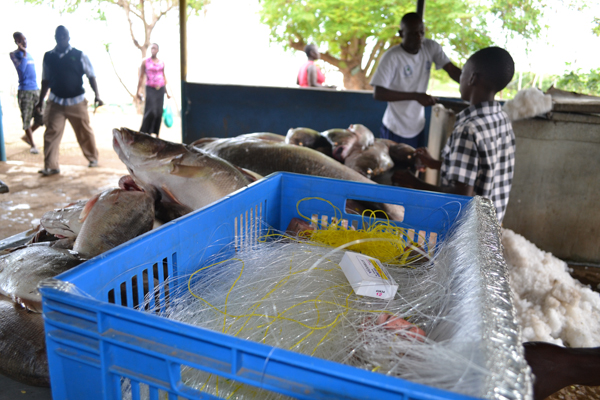 Fishing gear stands ready next to the day’s catch on the shore of Lake Victoria. Photo credit: Isaiah Esipisu. Lake Victoria, Africa’s largest fresh water body and the world’s second largest lake, is no longer fresh. The lake is choking with pollution from industrial and agricultural wastes, as well as raw sewage from Kisumu, Kenya’s […]
Fishing gear stands ready next to the day’s catch on the shore of Lake Victoria. Photo credit: Isaiah Esipisu. Lake Victoria, Africa’s largest fresh water body and the world’s second largest lake, is no longer fresh. The lake is choking with pollution from industrial and agricultural wastes, as well as raw sewage from Kisumu, Kenya’s […]
Invasive predators, deforestation driving Tasmanian parrot over the edge
 Young swift parrots (Lathamus discolour). Photo courtesy of Dejan Stojanovic. In the forests of Tasmania lives the swift parrot (Lathamus discolour), a highly threatened bird that breeds nowhere else in the world. New research published recently in Biological Conservation finds they are more at risk of extinction than previously thought, with introduced sugar gliders (Petaurus […]
Young swift parrots (Lathamus discolour). Photo courtesy of Dejan Stojanovic. In the forests of Tasmania lives the swift parrot (Lathamus discolour), a highly threatened bird that breeds nowhere else in the world. New research published recently in Biological Conservation finds they are more at risk of extinction than previously thought, with introduced sugar gliders (Petaurus […]
Energy Sprawl: Comparing biodiversity impacts of oil, gas and wind production
 Energy has become a contentious and politicized topic, spurring activism, whether it be the fossil fuel divestment campaign, Keystone pipeline protests, or concern over wind turbine harm to birds. But whatever energy future we choose, two things are clear: an expanding human population will need more energy, and no matter what energy source we pick, […]
Energy has become a contentious and politicized topic, spurring activism, whether it be the fossil fuel divestment campaign, Keystone pipeline protests, or concern over wind turbine harm to birds. But whatever energy future we choose, two things are clear: an expanding human population will need more energy, and no matter what energy source we pick, […]
Scientists, NGOs race to save ‘Millennium Trees’
 In a tiny area of an isolated archipelago in the southwest Pacific lives a unique tree species on the precipice of extinction. Recent research has shown it is declining dramatically, and mature individuals may be completely gone in 100 years. In response, environmental organizations and scientists are coming together to try and save New Caledonia’s […]
In a tiny area of an isolated archipelago in the southwest Pacific lives a unique tree species on the precipice of extinction. Recent research has shown it is declining dramatically, and mature individuals may be completely gone in 100 years. In response, environmental organizations and scientists are coming together to try and save New Caledonia’s […]
Rat eradication needed to save seabird colony
 Although only a nuisance in your home, on an isolated island chain (archipelago) off the northeastern coast of Brazil, rats pose a threat to the red-billed tropicbird (Phaethon aethereus). The seabird nests in the remote Abrolhos National Park, but two species of invasive rats prey on its eggs and young: the house rat (Rattus […]
Although only a nuisance in your home, on an isolated island chain (archipelago) off the northeastern coast of Brazil, rats pose a threat to the red-billed tropicbird (Phaethon aethereus). The seabird nests in the remote Abrolhos National Park, but two species of invasive rats prey on its eggs and young: the house rat (Rattus […]
Plant wars: some tree species compete better against grasses for reforestation
 Biologists may have discovered essential information that could help trees overcome specific grass species on tropical forest restoration sites What happens to degraded pastureland once the cows are kicked out? After years of letting the area rest, does it eventually become what it once was? Not likely. When disruptions such as invasive species and human […]
Biologists may have discovered essential information that could help trees overcome specific grass species on tropical forest restoration sites What happens to degraded pastureland once the cows are kicked out? After years of letting the area rest, does it eventually become what it once was? Not likely. When disruptions such as invasive species and human […]
Gone for good: world’s largest earwig declared extinct
 A female common earwig (Forficula auricularia) in defensive posture. The world’s largest earwig has been declared extinct. Photo by: Public Domain. The world has lost a giant: this week the IUCN Red List officially declared St. Helena giant earwig (Labidura herculeana) extinct. While its length of 80 millimeters (3.1 inches) may not seem like much, […]
A female common earwig (Forficula auricularia) in defensive posture. The world’s largest earwig has been declared extinct. Photo by: Public Domain. The world has lost a giant: this week the IUCN Red List officially declared St. Helena giant earwig (Labidura herculeana) extinct. While its length of 80 millimeters (3.1 inches) may not seem like much, […]
Next big idea in forest conservation? Recognize the value of novel forests
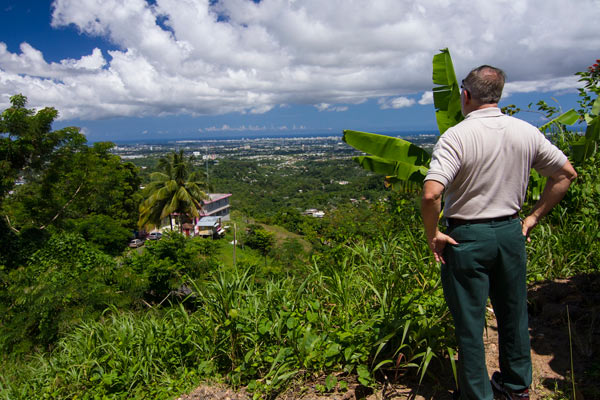 Innovation in Tropical Forest Conservation: Q&A with Ariel Lugo Ariel Lugo overlooking an urban watershed in Puerto Rico. Photo courtesy of Ariel Lugo. Think first before you eradicate non-native species says Dr. Ariel E. Lugo, the current director of the International Institute of Tropical Forestry within the USDA Forest Service, based in Puerto Rico. Lugo, […]
Innovation in Tropical Forest Conservation: Q&A with Ariel Lugo Ariel Lugo overlooking an urban watershed in Puerto Rico. Photo courtesy of Ariel Lugo. Think first before you eradicate non-native species says Dr. Ariel E. Lugo, the current director of the International Institute of Tropical Forestry within the USDA Forest Service, based in Puerto Rico. Lugo, […]
Dogs may be responsible for declining mammals in Brazil’s agroforests
 Study calls into question the efficacy of agroforests in conserving biodiversity With an estimated population of 700 million individuals, domestic dogs are the most abundant carnivore in the world and are present everywhere that man has settled. Domestic dogs, commonly referred to as man’s best friend, are not usually viewed as a huge threat to […]
Study calls into question the efficacy of agroforests in conserving biodiversity With an estimated population of 700 million individuals, domestic dogs are the most abundant carnivore in the world and are present everywhere that man has settled. Domestic dogs, commonly referred to as man’s best friend, are not usually viewed as a huge threat to […]
Invasion of the lionfish: new research finds the situation may be worse than we thought
 Invasive predator can live in nearly freshwater environments, may threaten estuaries, rivers You may have recently read the controversial story on invasive lionfish research involving Dr. Zack Jud of Florida International University and a young girl named Lauren Arrington. While the issue of attribution in scientific research is crucial to the discipline, much of the […]
Invasive predator can live in nearly freshwater environments, may threaten estuaries, rivers You may have recently read the controversial story on invasive lionfish research involving Dr. Zack Jud of Florida International University and a young girl named Lauren Arrington. While the issue of attribution in scientific research is crucial to the discipline, much of the […]
Invasive species worsen damage from Hawaii’s storms
 Iselle damage in Hawaii. Photo by Greg Asner Damage from Hurricane Iselle, which recently battered Hawaii’s Big Island, was exacerbated by invasion of non-native tree species, say experts who have studied the transformation of Hawaii’s native forests. Iselle, which made landfall on the Big Island on August 7, was the third-strongest tropical cyclone to hit […]
Iselle damage in Hawaii. Photo by Greg Asner Damage from Hurricane Iselle, which recently battered Hawaii’s Big Island, was exacerbated by invasion of non-native tree species, say experts who have studied the transformation of Hawaii’s native forests. Iselle, which made landfall on the Big Island on August 7, was the third-strongest tropical cyclone to hit […]
On the brink of extinction: Javan rhino has new enemy in invasive palm
 New threat is reducing the food supply of one of the world’s rarest animals The last of Indonesia’s critically endangered Javan rhinoceroses have survived poachers, rapid deforestation and life in the shadow of one of the archipelago’s most active volcanoes. But an invasive plant is now posing a new threat to the world’s rarest species […]
New threat is reducing the food supply of one of the world’s rarest animals The last of Indonesia’s critically endangered Javan rhinoceroses have survived poachers, rapid deforestation and life in the shadow of one of the archipelago’s most active volcanoes. But an invasive plant is now posing a new threat to the world’s rarest species […]
Long lives, big impacts: human life expectancy linked to extinctions
 Since the arrival of Homo sapiens, other species have been going extinct at an unprecedented rate. Most scientists now agree that extinction rates are between 100 and 1000 times greater than before humans existed. Working out what is driving these extinctions is fiendishly complicated, but a new study by scientists from the University of California, […]
Since the arrival of Homo sapiens, other species have been going extinct at an unprecedented rate. Most scientists now agree that extinction rates are between 100 and 1000 times greater than before humans existed. Working out what is driving these extinctions is fiendishly complicated, but a new study by scientists from the University of California, […]
Alien trees use logging roads to invade Borneo forests
 The spiked pepper tree (Piper aduncum) is native to the American tropics, but has made itself at home in a variety of other locales where it can crowd out local vegetation and interfere with forest recovery. Although it’s been slow to spread through Borneo since its introduction to Indonesia in 1952, new logging roads appear […]
The spiked pepper tree (Piper aduncum) is native to the American tropics, but has made itself at home in a variety of other locales where it can crowd out local vegetation and interfere with forest recovery. Although it’s been slow to spread through Borneo since its introduction to Indonesia in 1952, new logging roads appear […]
Nicaragua Canal could cause ecological disaster, warn experts
 Nicaragua’s plans for a canal linking the Pacific and Atlantic Oceans could trigger an environmental disaster through habitat destruction and alteration, introduction of non-native species, pollution, and sedimentation, warns a commentary published in this week’s issue of Nature. The ambitious project, which aims to compete with the recently-expanded Panama Canal, is being developed by HK […]
Nicaragua’s plans for a canal linking the Pacific and Atlantic Oceans could trigger an environmental disaster through habitat destruction and alteration, introduction of non-native species, pollution, and sedimentation, warns a commentary published in this week’s issue of Nature. The ambitious project, which aims to compete with the recently-expanded Panama Canal, is being developed by HK […]
Meeting the mammal that survived the dinosaurs
 The female Hispaniolan solenodon caught by Nicolas Corona in the Dominican Republic. She’s awaiting being fitted with a radio collar. Photo by: Tiffany Roufs. So, here I am, running in a forest at night over 2,000 miles from home. This forest—dry, stout, and thorny enough to draw blood—lies just a few miles north of a […]
The female Hispaniolan solenodon caught by Nicolas Corona in the Dominican Republic. She’s awaiting being fitted with a radio collar. Photo by: Tiffany Roufs. So, here I am, running in a forest at night over 2,000 miles from home. This forest—dry, stout, and thorny enough to draw blood—lies just a few miles north of a […]
Pet fish invade ecosystem, upending nutrients and impoverishing fishers
 If you, or someone you know, owns a freshwater aquarium, chances are you have seen the peculiar little creature attached face-first to the glass in effort to find a morsel of algae. This algae eater, popularly known as the sucker fish, is the sailfin catfish, or plecos. It is one of the most commonly purchased […]
If you, or someone you know, owns a freshwater aquarium, chances are you have seen the peculiar little creature attached face-first to the glass in effort to find a morsel of algae. This algae eater, popularly known as the sucker fish, is the sailfin catfish, or plecos. It is one of the most commonly purchased […]
‘Ecological Armageddon’: mammals vanish entirely from forest fragments after 25 years
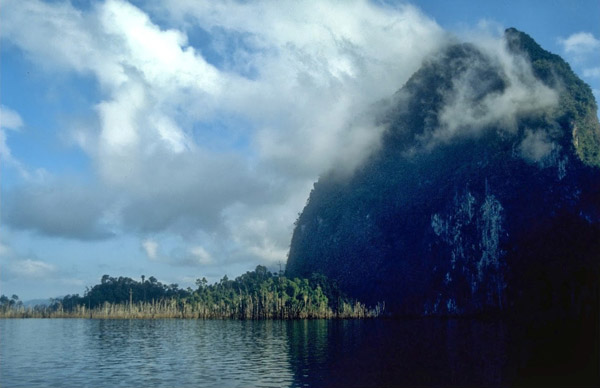 As tropical forests worldwide are increasingly cut into smaller and smaller fragments, mammal extinctions may not be far behind, according to a new study in Science. Tracking native smalls mammals in Chiew Larn Reservoir, Thailand for over 25 years, scientists found a stunning and rapid decline in mammal populations, until most forests were almost completely […]
As tropical forests worldwide are increasingly cut into smaller and smaller fragments, mammal extinctions may not be far behind, according to a new study in Science. Tracking native smalls mammals in Chiew Larn Reservoir, Thailand for over 25 years, scientists found a stunning and rapid decline in mammal populations, until most forests were almost completely […]
Are ‘novel’ tropical forests nature’s response to global change?
 We now live in a world dominated by humans (the Anthropocene), whose activities on Earth are resulting in new habitats and new environmental conditions including climate change. To many, the Anthropocene is an era of environmental doom that unless reversed, will result in catastrophic reductions in biodiversity. An alternate view is that the biota will […]
We now live in a world dominated by humans (the Anthropocene), whose activities on Earth are resulting in new habitats and new environmental conditions including climate change. To many, the Anthropocene is an era of environmental doom that unless reversed, will result in catastrophic reductions in biodiversity. An alternate view is that the biota will […]
Journey to the Edge of Eden: the struggle to preserve Southwest Florida
 Gary Schmelz, in a Journey to the Edge of Eden, takes us through a wonderful personal account of the conservation history of Southwest Florida. Journey to the Edge of Eden is one part personal memoir similar to the English naturalist Gerald Durrell and one part Florida conservation history. With hilarious stories of unintended naturalist misadventures […]
Gary Schmelz, in a Journey to the Edge of Eden, takes us through a wonderful personal account of the conservation history of Southwest Florida. Journey to the Edge of Eden is one part personal memoir similar to the English naturalist Gerald Durrell and one part Florida conservation history. With hilarious stories of unintended naturalist misadventures […]
Conservationists work to give South Georgia back to the birds
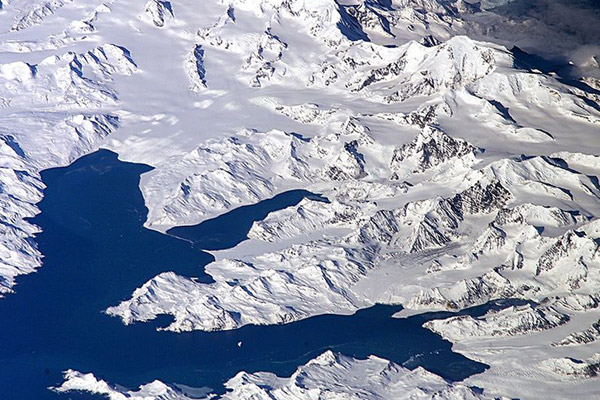 A team on South Georgia has successfully completed the world’s largest rodent eradication in an effort to rid the British territory of millions of rats and mice. Against the backdrop of an approaching Antarctic winter between February and May, three helicopters encountered perilous flying conditions while peppering the southern Atlantic island with 183 tonnes of […]
A team on South Georgia has successfully completed the world’s largest rodent eradication in an effort to rid the British territory of millions of rats and mice. Against the backdrop of an approaching Antarctic winter between February and May, three helicopters encountered perilous flying conditions while peppering the southern Atlantic island with 183 tonnes of […]
Unconventional swine: how invasive pigs are helping preserve biodiversity in the Pantanal
.600.jpg) Ordinarily, invasive and exotic species are a grave threat to native wildlife: outcompeting local species, introducing parasites and disease, and disturbing local ecological regimes. A unique case in the Brazilian Pantanal, however, has turned the tables; here, an introduced mammal has actually aided the conservation of native wildlife. The impact of feral pigs (Sus scrofa) […]
Ordinarily, invasive and exotic species are a grave threat to native wildlife: outcompeting local species, introducing parasites and disease, and disturbing local ecological regimes. A unique case in the Brazilian Pantanal, however, has turned the tables; here, an introduced mammal has actually aided the conservation of native wildlife. The impact of feral pigs (Sus scrofa) […]
Saviors or villains: controversy erupts as New Zealand plans to drop poison over Critically Endangered frog habitat
.600.jpg) New Zealand’s Department of Conservation (DOC) is facing a backlash over plans to aerially drop a controversial poison, known as 1080, over the habitat of two endangered, prehistoric, and truly bizarre frog species, Archey’s and Hochsetter’s frogs, on Mount Moehau. Used in New Zealand to kill populations of invasive mammals, such as rats and the […]
New Zealand’s Department of Conservation (DOC) is facing a backlash over plans to aerially drop a controversial poison, known as 1080, over the habitat of two endangered, prehistoric, and truly bizarre frog species, Archey’s and Hochsetter’s frogs, on Mount Moehau. Used in New Zealand to kill populations of invasive mammals, such as rats and the […]
Ant communities more segregated in palm oil plantations than rainforest
 Oil palm estate in Malaysia. Photo by: Rhett A. Butler. Ants are an important ecological group in both degraded and natural habitats. They interact with many other species and mediate a range of ecological processes. These interactions are often interpreted in the context of ant mosaics, where dominant species form strict territories, keeping other ants […]
Oil palm estate in Malaysia. Photo by: Rhett A. Butler. Ants are an important ecological group in both degraded and natural habitats. They interact with many other species and mediate a range of ecological processes. These interactions are often interpreted in the context of ant mosaics, where dominant species form strict territories, keeping other ants […]
Invasive plants hurt locals in Mauritius
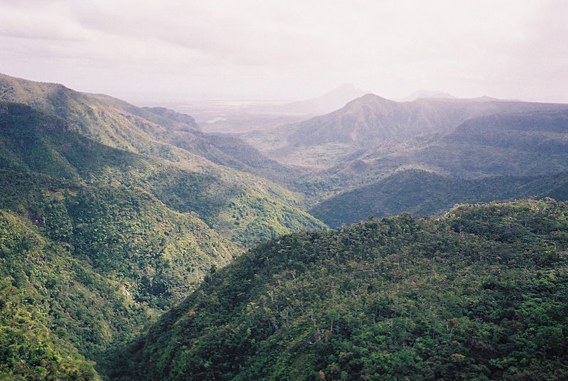 Black River Gorges National Park, Mauritius. Native species on the island of Mauritius have long had to deal with invasive species. In fact, invasives likely played a major role in the extinction of the Mauritius’ most famous resident, the dodo. While scientists have long cataloged the impact of invasive animals on island wildlife, there has […]
Black River Gorges National Park, Mauritius. Native species on the island of Mauritius have long had to deal with invasive species. In fact, invasives likely played a major role in the extinction of the Mauritius’ most famous resident, the dodo. While scientists have long cataloged the impact of invasive animals on island wildlife, there has […]
The Role of Science for Conservation – book review
 The Role of Science for Conservation, edited by Matthias Wolff and Mark Gardner, celebrates Charles Darwin’s Bicentennial and 50 years of research by the Charles Darwin Foundation in The Galápagos, Ecuador. Using The Galápagos as a case study, The Role of Science for Conservation communicates to a wide audience about themes from a broad range […]
The Role of Science for Conservation, edited by Matthias Wolff and Mark Gardner, celebrates Charles Darwin’s Bicentennial and 50 years of research by the Charles Darwin Foundation in The Galápagos, Ecuador. Using The Galápagos as a case study, The Role of Science for Conservation communicates to a wide audience about themes from a broad range […]
Captive frogs may be spreading diseases to wild cousins across Southeast Asia
 Lethal chytrid fungus discovered in Singapore. The bullfrog is believed to be spreading chytrid fungus to wild frogs in Southeast Asia. Photo courtesy of WCS. Scientists have documented a series of links between exotic frogs for trade and diseases in wild frogs in Southeast Asia, including the first documented case of the chytrid fungus—a virulent […]
Lethal chytrid fungus discovered in Singapore. The bullfrog is believed to be spreading chytrid fungus to wild frogs in Southeast Asia. Photo courtesy of WCS. Scientists have documented a series of links between exotic frogs for trade and diseases in wild frogs in Southeast Asia, including the first documented case of the chytrid fungus—a virulent […]
Extinction warning: racing to save the little dodo from its cousin’s fate
 Illustration of the little dodo likely based on stuffed specimens. By: John Gould. Sometime in the late 1600s the world’s last dodo perished on the island of Mauritius. No one knows how it spent its final moments—rather in the grip of some invasive predator or simply fading away from loneliness—but with its passing came an […]
Illustration of the little dodo likely based on stuffed specimens. By: John Gould. Sometime in the late 1600s the world’s last dodo perished on the island of Mauritius. No one knows how it spent its final moments—rather in the grip of some invasive predator or simply fading away from loneliness—but with its passing came an […]
Scientist: releasing invasive birds in Turkey to eat ticks will backfire
 Helmeted guineafowl in native habitat in Pilanesberg Reserve, South Africa. Photo courtesy of Çağan Şekercioğlu. As Turkey raises and releases thousands of non-native helmeted guineafowl (Numida meleagris) to eat ticks that carry the deadly Crimean-Congo hemorrhagic fever virus, new research suggests guineafowl actually eat few ticks, carry the parasites on their feathers, and further spread […]
Helmeted guineafowl in native habitat in Pilanesberg Reserve, South Africa. Photo courtesy of Çağan Şekercioğlu. As Turkey raises and releases thousands of non-native helmeted guineafowl (Numida meleagris) to eat ticks that carry the deadly Crimean-Congo hemorrhagic fever virus, new research suggests guineafowl actually eat few ticks, carry the parasites on their feathers, and further spread […]
Killer kittens: U.S. cats kill up to 25 billion birds and small mammals per year
 Killing machine Domesticated cats in the United States kill far more animals than previously thought — 1.4 to 3.7 billion birds and 6.9 – 20.7 billion small mammals per year — finds a study published this week in the journal Nature Communications. Extrapolating from local studies, scientists at the Smithsonian Conservation Biology Institute and the […]
Killing machine Domesticated cats in the United States kill far more animals than previously thought — 1.4 to 3.7 billion birds and 6.9 – 20.7 billion small mammals per year — finds a study published this week in the journal Nature Communications. Extrapolating from local studies, scientists at the Smithsonian Conservation Biology Institute and the […]
Cute koalas have become ‘urban refugees’
 The 3rd Annual New York Wildlife Conservation Film Festival (WFCC.org) runs from January 30 – February 2, 2013. Ahead of the event, Mongabay.com is running a series of Q&As with filmmakers and presenters. For more interviews, please see our WCFF feed. Jimmy, an orphan whose mother was rundown by a car, is the star of […]
The 3rd Annual New York Wildlife Conservation Film Festival (WFCC.org) runs from January 30 – February 2, 2013. Ahead of the event, Mongabay.com is running a series of Q&As with filmmakers and presenters. For more interviews, please see our WCFF feed. Jimmy, an orphan whose mother was rundown by a car, is the star of […]
Meet Cape Town’s volunteer ‘toad shepherds’
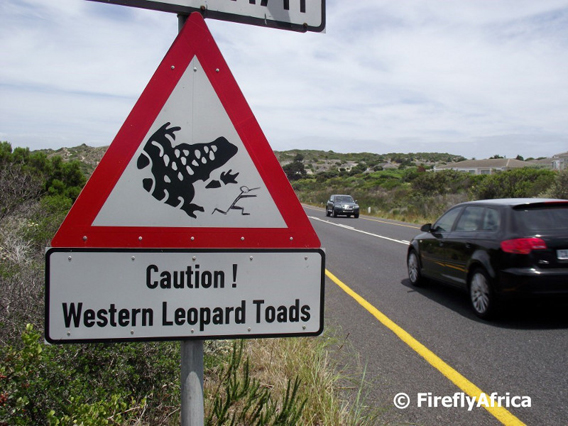 An interview with Hanniki Pieterse Western leopard toad signs that were put up this year. Photo courtesy of: Hanniki Pieterse. August marks the last month of winter in South Africa, and, as temperatures begin to rise, activists in Cape Town prepare for a truly unique conservation event. Every year at this time western leopard toads […]
An interview with Hanniki Pieterse Western leopard toad signs that were put up this year. Photo courtesy of: Hanniki Pieterse. August marks the last month of winter in South Africa, and, as temperatures begin to rise, activists in Cape Town prepare for a truly unique conservation event. Every year at this time western leopard toads […]
Remarkable comeback: blue iguana downgraded to Endangered after determined conservation efforts
 Blue iguana in Queen Elizabeth II Botanic Park. Photo by: Lhb1239. The wild blue iguana population has increased by at least 15 times in the last ten years, prompting the IUCN Red List to move the species from Critically Endangered to just Endangered. A targeted, ambitious conservation program, headed by the Blue Iguana Recovery Team, […]
Blue iguana in Queen Elizabeth II Botanic Park. Photo by: Lhb1239. The wild blue iguana population has increased by at least 15 times in the last ten years, prompting the IUCN Red List to move the species from Critically Endangered to just Endangered. A targeted, ambitious conservation program, headed by the Blue Iguana Recovery Team, […]
Arachnopocalypse: with birds away, the spiders play in Guam
 The accidental introduction of the brown tree snake on Guam has resulted in a loss of birds and a subsequent explosion of spiders. Photo by: Isaac Chellman. The island of Guam is drowning in spiders. New research in the open-access journal PLOS ONE has found that in the wet season, Guam’s arachnid population booms to […]
The accidental introduction of the brown tree snake on Guam has resulted in a loss of birds and a subsequent explosion of spiders. Photo by: Isaac Chellman. The island of Guam is drowning in spiders. New research in the open-access journal PLOS ONE has found that in the wet season, Guam’s arachnid population booms to […]
Animal pictures of the day: booming captive breeding for Mauritius skinks
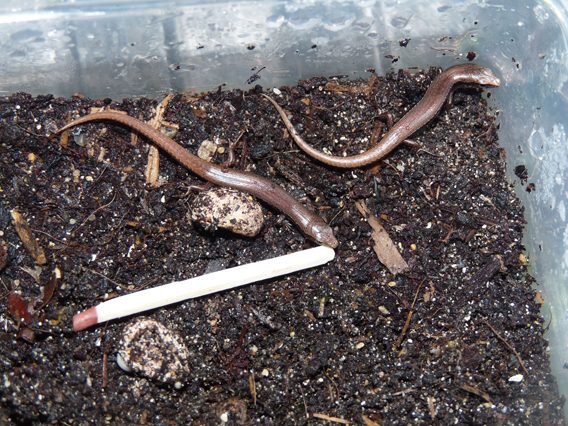 Orange-tailed skink hatchlings meet their match in a matchstick. Photo courtesy of the Durrell Wildlife Conservation Trust (DWCT). Three female orange-tailed skinks skinks have produced 16 skink babies in just four months, according to the Durrell Wildlife Conservation Trust (DWCT), which is captive breeding the Critically Endangered species. The breeding efforts are all the more […]
Orange-tailed skink hatchlings meet their match in a matchstick. Photo courtesy of the Durrell Wildlife Conservation Trust (DWCT). Three female orange-tailed skinks skinks have produced 16 skink babies in just four months, according to the Durrell Wildlife Conservation Trust (DWCT), which is captive breeding the Critically Endangered species. The breeding efforts are all the more […]
Massive snake found in Florida (photos)
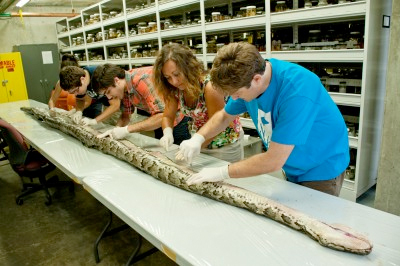 On Aug. 10, 2012, researchers at the Florida Museum of Natural History on the University of Florida campus examine the internal anatomy of the largest Burmese python found in Florida to date. The 17-foot-7-inch snake weighed 164 pounds and carried 87 eggs in its oviducts, a state record. Following scientific investigation, the snake will be […]
On Aug. 10, 2012, researchers at the Florida Museum of Natural History on the University of Florida campus examine the internal anatomy of the largest Burmese python found in Florida to date. The 17-foot-7-inch snake weighed 164 pounds and carried 87 eggs in its oviducts, a state record. Following scientific investigation, the snake will be […]
Meet the world’s rarest snake: only 18 left
-(Large).568.jpg) World’s rarest snake: Saint Lucia racer. Photo by: G. Guida. It’s slithery, brown, and doesn’t mind being picked up: meet the Saint Lucia racer (Liophis ornatus), which holds the dubious honor of being the world’s most endangered snake. A five month extensive survey found just 18 animals on a small islet off of the Caribbean […]
World’s rarest snake: Saint Lucia racer. Photo by: G. Guida. It’s slithery, brown, and doesn’t mind being picked up: meet the Saint Lucia racer (Liophis ornatus), which holds the dubious honor of being the world’s most endangered snake. A five month extensive survey found just 18 animals on a small islet off of the Caribbean […]
Lonesome George passes, taking unique subspecies with him
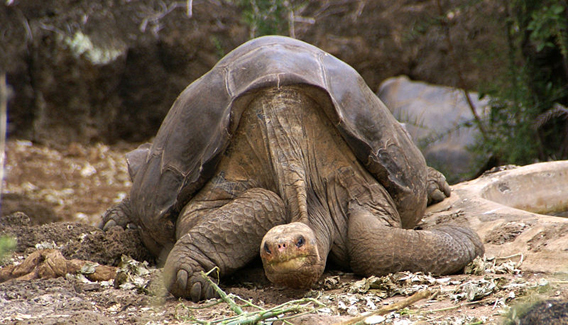 Lonesome George, the last of his kind, has passed away. Lonesome George, the sole surviving member of the Pinta Island tortoise (Chelonoidis nigra abingdoni), was found dead on Sunday by staff at the Galapagos National Park. With George’s passing, the Pinta Island tortoise subspecies officially falls into extinction. First found in 1972, Lonesome George became […]
Lonesome George, the last of his kind, has passed away. Lonesome George, the sole surviving member of the Pinta Island tortoise (Chelonoidis nigra abingdoni), was found dead on Sunday by staff at the Galapagos National Park. With George’s passing, the Pinta Island tortoise subspecies officially falls into extinction. First found in 1972, Lonesome George became […]
Why bird droppings matter to manta rays: discovering unknown ecological connections
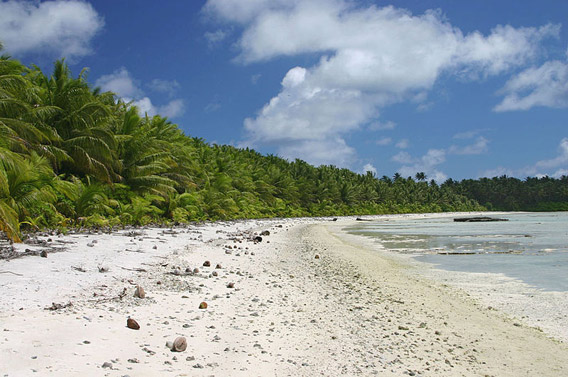 Beach on Palmyra Atoll. Ecologists have long argued that everything in the nature is connected, but teasing out these intricate connections is not so easy. In fact, it took research on a remote, unoccupied island for scientists to discover that manta ray abundance was linked to seabirds and thereby native trees. Working in the U.S. […]
Beach on Palmyra Atoll. Ecologists have long argued that everything in the nature is connected, but teasing out these intricate connections is not so easy. In fact, it took research on a remote, unoccupied island for scientists to discover that manta ray abundance was linked to seabirds and thereby native trees. Working in the U.S. […]
Island bat goes extinct after Australian officials hesitate
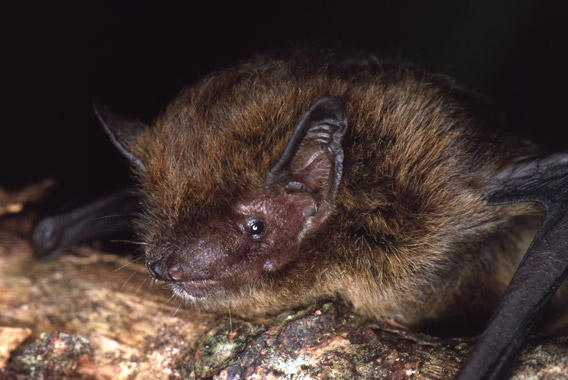 Now extinct: the Christmas Island pipistrelle. Photo by: Lindy Lumsden. Nights on Christmas Island in the Indian Ocean will never again be the same. The last echolocation call of a tiny bat native to the island, the Christmas Island pipistrelle (Pipistrellus murrayi), was recorded on August 26th 2009, and since then there has been only […]
Now extinct: the Christmas Island pipistrelle. Photo by: Lindy Lumsden. Nights on Christmas Island in the Indian Ocean will never again be the same. The last echolocation call of a tiny bat native to the island, the Christmas Island pipistrelle (Pipistrellus murrayi), was recorded on August 26th 2009, and since then there has been only […]
Skink biodiversity jumps 650 percent in the Caribbean
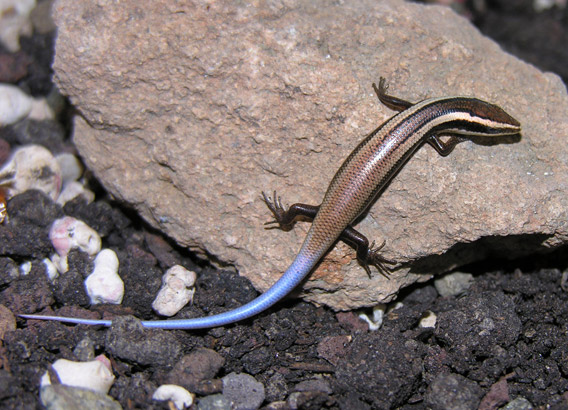 New species: the Anguilla Bank skink. Photo by: Karl Questal. In a single paper in Zootaxa scientists have rewritten the current understanding of lizard biodiversity in the Caribbean. By going over museum specimens of skinks, scientists have discovered 24 new species and re-established nine species previously described species, long-thought invalid. The single paper has increased […]
New species: the Anguilla Bank skink. Photo by: Karl Questal. In a single paper in Zootaxa scientists have rewritten the current understanding of lizard biodiversity in the Caribbean. By going over museum specimens of skinks, scientists have discovered 24 new species and re-established nine species previously described species, long-thought invalid. The single paper has increased […]
Invasive primates threaten Atlantic Forest natives
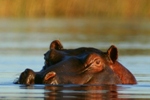 Scientists have called for the removal of eight invasive primates from Brazil’s imperiled Atlantic Forest in a new study published in mongabay.com’s open access journal Tropical Conservation Society (TCS). The researchers fear that the eight alien monkeys could hurt other species due to increased competition, predation, and possible disease. “The problem of introduced primate species […]
Scientists have called for the removal of eight invasive primates from Brazil’s imperiled Atlantic Forest in a new study published in mongabay.com’s open access journal Tropical Conservation Society (TCS). The researchers fear that the eight alien monkeys could hurt other species due to increased competition, predation, and possible disease. “The problem of introduced primate species […]
Invasion!: Burmese pythons decimate mammals in the Everglades
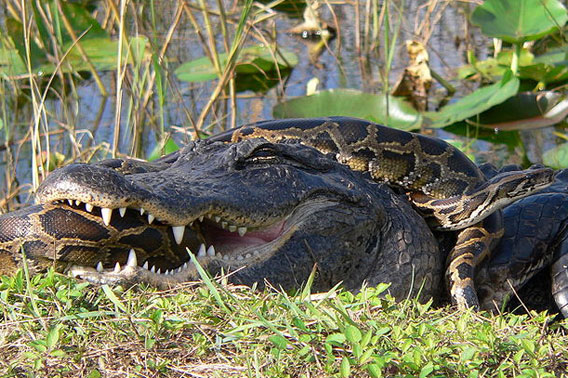 An American alligator and a Burmese python struggle in Everglades National Park. Photo by: Lori Oberhofer, U.S. National Park Service. The Everglades in southern Florida has faced myriad environmental impacts from draining for sprawl to the construction of canals, but even as the U.S. government moves slowly on an ambitious plan to restore the massive […]
An American alligator and a Burmese python struggle in Everglades National Park. Photo by: Lori Oberhofer, U.S. National Park Service. The Everglades in southern Florida has faced myriad environmental impacts from draining for sprawl to the construction of canals, but even as the U.S. government moves slowly on an ambitious plan to restore the massive […]
California city bans bullfrogs to safeguard native species
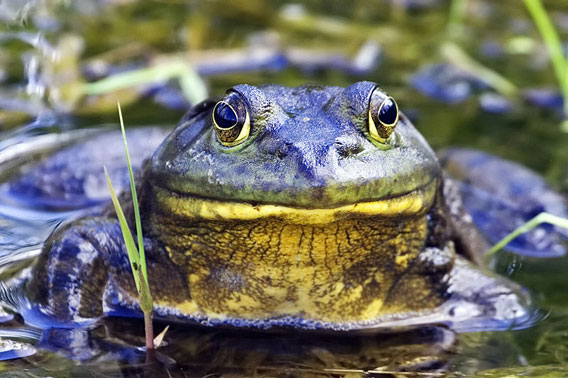 Invasive American bullfrog in British Colombia. Photo by: Alan D. Wils. Santa Cruz, California has become the first city in the U.S. to ban the importation, sale, release, and possession of the American bullfrog (Rana catesbeiana). Found throughout Eastern and Central U.S., the frogs have become an invasive threat to wildlife in the western U.S. […]
Invasive American bullfrog in British Colombia. Photo by: Alan D. Wils. Santa Cruz, California has become the first city in the U.S. to ban the importation, sale, release, and possession of the American bullfrog (Rana catesbeiana). Found throughout Eastern and Central U.S., the frogs have become an invasive threat to wildlife in the western U.S. […]
U.S. implements snake ban to save native ecosystems
 An American alligator and a Burmese python struggle in Everglades National Park. Photo by: Lori Oberhofer, U.S. National Park Service. Last week the U.S. Fish and Wildlife Service (USFWS) announced it was banning the importation and sale across state lines of four large, non-native snakes: the Burmese python (Python molurus bivittatus), the yellow anaconda (Eunectes […]
An American alligator and a Burmese python struggle in Everglades National Park. Photo by: Lori Oberhofer, U.S. National Park Service. Last week the U.S. Fish and Wildlife Service (USFWS) announced it was banning the importation and sale across state lines of four large, non-native snakes: the Burmese python (Python molurus bivittatus), the yellow anaconda (Eunectes […]
Aloha, and welcome to the planet’s extinction capital
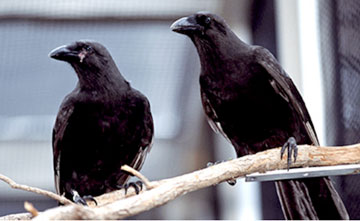 Hawaii evokes images of a tropical paradise where fragrant flowers, vivid colors, exotic plants, birds, and fish abound. Unfortunately, much of Hawaii’s original native flora and fauna has disappeared since the arrival of Europeans in the 18th Century. Hawaii now has the dubious distinction as having become the planet’s extinction capital, having lost more than […]
Hawaii evokes images of a tropical paradise where fragrant flowers, vivid colors, exotic plants, birds, and fish abound. Unfortunately, much of Hawaii’s original native flora and fauna has disappeared since the arrival of Europeans in the 18th Century. Hawaii now has the dubious distinction as having become the planet’s extinction capital, having lost more than […]
Forgotten species: the rebellious spotted handfish
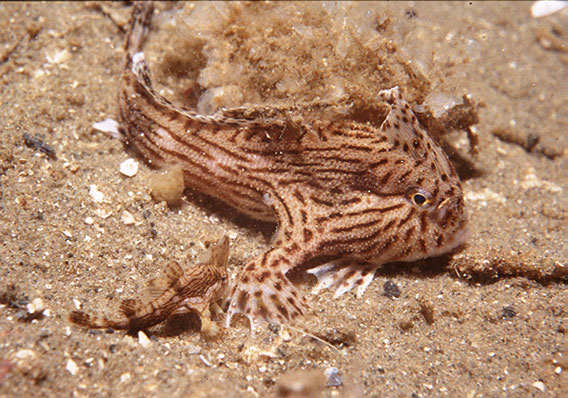 Everyone knows the tiger, the panda, the blue whale, but what about the other five to thirty million species estimated to inhabit our Earth? Many of these marvelous, stunning, and rare species have received little attention from the media, conservation groups, and the public. This series is an attempt to give these ‘forgotten species‘ some […]
Everyone knows the tiger, the panda, the blue whale, but what about the other five to thirty million species estimated to inhabit our Earth? Many of these marvelous, stunning, and rare species have received little attention from the media, conservation groups, and the public. This series is an attempt to give these ‘forgotten species‘ some […]
Ant surprises on Murciélago Islands in Costa Rica
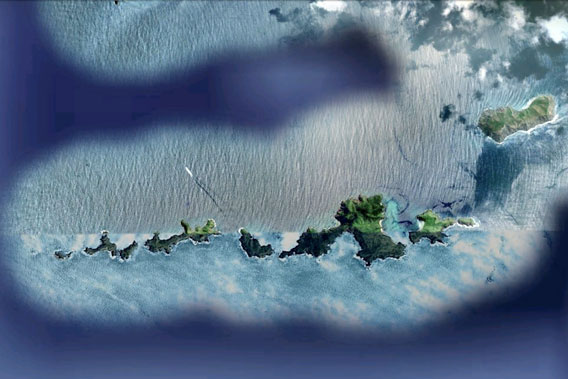 Murciélago Islands as seen by Google Earth. The Murciélago Islands are seven small islands off the northwest coast of Costa Rica in the Area de Conservación Guanacaste (ACG), home to one of the largest intact dry tropical forests in Central America. Despite this, few scientists have studied the biodiversity of these small uninhabited islands. A […]
Murciélago Islands as seen by Google Earth. The Murciélago Islands are seven small islands off the northwest coast of Costa Rica in the Area de Conservación Guanacaste (ACG), home to one of the largest intact dry tropical forests in Central America. Despite this, few scientists have studied the biodiversity of these small uninhabited islands. A […]
Down to 50, conservationists fight to save Javan Rhino from extinction
- Earlier this year, the International Rhino Foundation launched Operation Javan Rhino to prevent the extinction of the critically endangered Javan Rhinoceros (Rhinoceros sondaicus), formerly found in rain forests across Southeast Asia.
- Operation Javan Rhino is a multi-layered project which links field conservation, habitat restoration, and management efforts with the interests of local governments and communities.
- The following is an interview with Susie Ellis, Executive Director of the International Rhino Foundation.
New land snail invading Singapore requires swift action
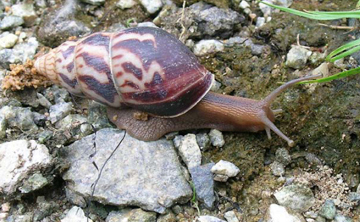 An African land snail Limicolaria flammea has been discovered by researchers in six locations in Singapore, perhaps heralding a new invasion of alien land snails in Southeast Asia. Although snails may seem largely innocuous creatures, past invasions have resulted in agricultural and economic damage. The global invasion of the giant African land snail (Achatina fulica) […]
An African land snail Limicolaria flammea has been discovered by researchers in six locations in Singapore, perhaps heralding a new invasion of alien land snails in Southeast Asia. Although snails may seem largely innocuous creatures, past invasions have resulted in agricultural and economic damage. The global invasion of the giant African land snail (Achatina fulica) […]
Alien plants invade Nigerian protected ‘gene bank’
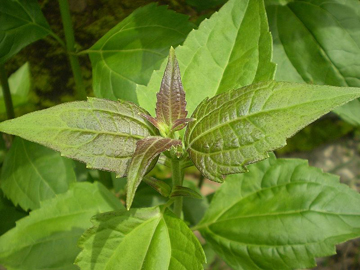 Very few studies have been conducted on invasive species in Nigeria, however a new study in mongabay.com’s open access journal Tropical Conservation Science has discovered 25 invasive plants in a field gene bank at the National Center for Genetic Resources and Biotechnology (NASGRAB) in Ibadan. The gene bank is used to establish populations of important […]
Very few studies have been conducted on invasive species in Nigeria, however a new study in mongabay.com’s open access journal Tropical Conservation Science has discovered 25 invasive plants in a field gene bank at the National Center for Genetic Resources and Biotechnology (NASGRAB) in Ibadan. The gene bank is used to establish populations of important […]
Photos: penguins devastated by oil spill
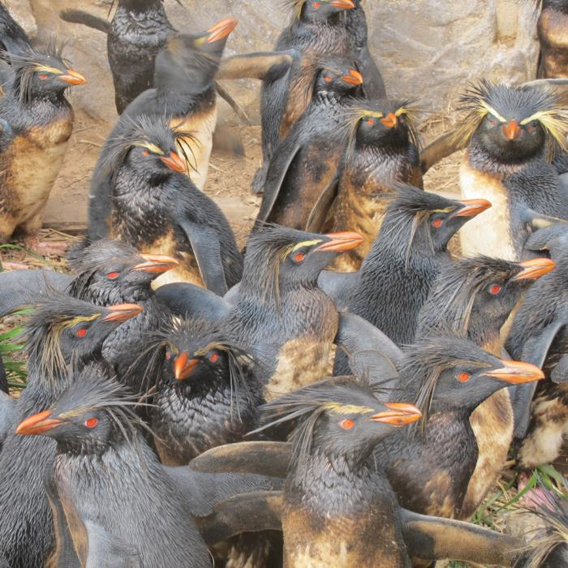 Northern rockhopper penguins covered in oil. Photo by: Tristan Conservation Team of Simon Glass, Wayne Swain and Matthew Green. Courtesy of: The Tristan da Cunha Website. Disturbing photos show northern rockhopper penguins (Eudyptes moseleyi) hit hard by an oil spill from a wrecked cargo ship on Nightingale Island in the Southern Atlantic. Already listed as […]
Northern rockhopper penguins covered in oil. Photo by: Tristan Conservation Team of Simon Glass, Wayne Swain and Matthew Green. Courtesy of: The Tristan da Cunha Website. Disturbing photos show northern rockhopper penguins (Eudyptes moseleyi) hit hard by an oil spill from a wrecked cargo ship on Nightingale Island in the Southern Atlantic. Already listed as […]
Hundreds of endangered penguins covered in oil after remote spill
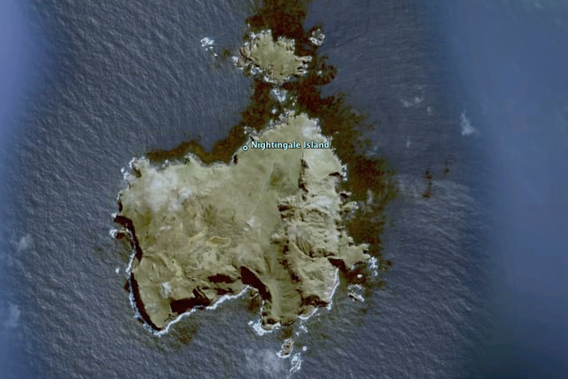 Nightingale Island as viewed from Google Earth. Conservation workers have found hundreds of oiled northern rockhopper penguins (Eudyptes moseleyi) after a cargo vessel wrecked on Nightingale Island, apart of the UK’s Tristan da Cunha archipelago. Northern rockhopper penguins are listed as Endangered by the IUCN Red List. According to a press release by BirdLife International, […]
Nightingale Island as viewed from Google Earth. Conservation workers have found hundreds of oiled northern rockhopper penguins (Eudyptes moseleyi) after a cargo vessel wrecked on Nightingale Island, apart of the UK’s Tristan da Cunha archipelago. Northern rockhopper penguins are listed as Endangered by the IUCN Red List. According to a press release by BirdLife International, […]
New Caledonia’s forests are second most threatened in the world, not New Zealand’s
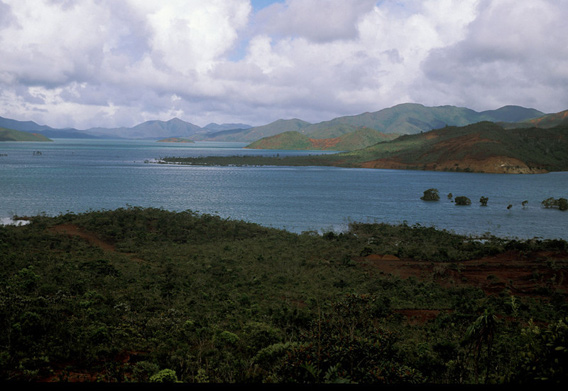 On February 2nd, Conservation International (CI) released a list of the world’s top 10 most threatened forest hotspots. The original press release incorrectly named New Zealand as number two, when in fact it is the island of New Caledonia and the surrounding East Melanesian islands. Down to only 5% of its original forest landscape, New […]
On February 2nd, Conservation International (CI) released a list of the world’s top 10 most threatened forest hotspots. The original press release incorrectly named New Zealand as number two, when in fact it is the island of New Caledonia and the surrounding East Melanesian islands. Down to only 5% of its original forest landscape, New […]
Forgotten species: the plummeting cycad
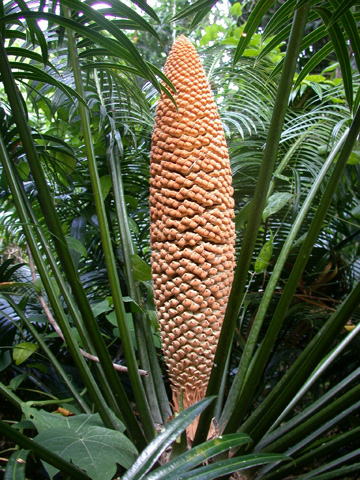 Everyone knows the tiger, the panda, the blue whale, but what about the other five to thirty million species estimated to inhabit our Earth? Many of these marvelous, stunning, and rare species have received little attention from the media, conservation groups, and the public. This series is an attempt to give these ‘forgotten species‘ some […]
Everyone knows the tiger, the panda, the blue whale, but what about the other five to thirty million species estimated to inhabit our Earth? Many of these marvelous, stunning, and rare species have received little attention from the media, conservation groups, and the public. This series is an attempt to give these ‘forgotten species‘ some […]
Pemerintah A.S. Bom Guam dengan Tikus Beku untuk Bunuh Ular
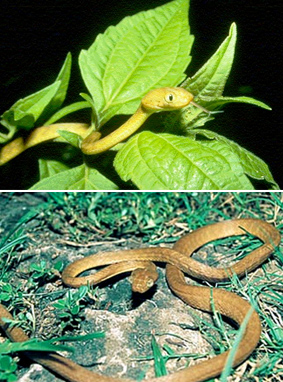 Dengan usaha yang sangat kreatif untuk menyingkirkan spesies agresif, Departemen Pertanian AS merencanakan untuk menjatuhkan ‘bom’ di hutan hujan pulau Guam dengan tikus beku mati yang dilapisi acetaminophen. Bom-tikus ini ditargetkan pada ular pohon cokelat, spesies penyerang yang telah membinasakan kehidupan alam setempat, dan membuat marah penduduk setempat, sejak muncul di tahun 1940-an. Idenya adalah […]
Dengan usaha yang sangat kreatif untuk menyingkirkan spesies agresif, Departemen Pertanian AS merencanakan untuk menjatuhkan ‘bom’ di hutan hujan pulau Guam dengan tikus beku mati yang dilapisi acetaminophen. Bom-tikus ini ditargetkan pada ular pohon cokelat, spesies penyerang yang telah membinasakan kehidupan alam setempat, dan membuat marah penduduk setempat, sejak muncul di tahun 1940-an. Idenya adalah […]
World’s rarest snake making a comeback
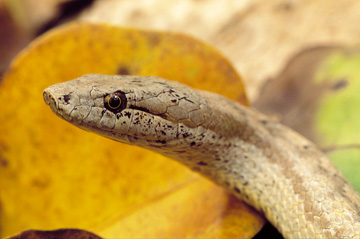 The Antiguan racer (Alsophis antiguae) shares a similar story with many highly endangered island species. Invasive mongoose killed every racer on the Caribbean island of Antigua, leaving only a small population on nearby Great Bird Island. Confined to 8 hectares, this final population was being killed-off by invasive Eurasian black rats. By the time conservationists […]
The Antiguan racer (Alsophis antiguae) shares a similar story with many highly endangered island species. Invasive mongoose killed every racer on the Caribbean island of Antigua, leaving only a small population on nearby Great Bird Island. Confined to 8 hectares, this final population was being killed-off by invasive Eurasian black rats. By the time conservationists […]
Rivers worldwide in peril: society treats symptoms, ignores causes
 Dams, agricultural runoff, pesticides, sewage, mercury pollution from coal plants, invasive species, overconsumption, irrigation, erosion from deforestation, wetland destruction, overfishing, aquaculture: it’s clear that the world’s rivers are facing a barrage of unprecedented impacts from humans, but just how bad is the situation? A new global analysis of the world’s rivers is not comforting: the […]
Dams, agricultural runoff, pesticides, sewage, mercury pollution from coal plants, invasive species, overconsumption, irrigation, erosion from deforestation, wetland destruction, overfishing, aquaculture: it’s clear that the world’s rivers are facing a barrage of unprecedented impacts from humans, but just how bad is the situation? A new global analysis of the world’s rivers is not comforting: the […]
U.S. government bombs Guam with frozen mice to kill snakes
 In a spectacularly creative effort to rid Guam of an invasive species, the US Department of Agriculture is planning to ‘bomb’ the island’s rainforests with dead frozen mice laced with acetaminophen. The mice-bombs are meant to target the brown tree snake, an invasive species which has ravaged local wildlife, and angered local residents, since arriving […]
In a spectacularly creative effort to rid Guam of an invasive species, the US Department of Agriculture is planning to ‘bomb’ the island’s rainforests with dead frozen mice laced with acetaminophen. The mice-bombs are meant to target the brown tree snake, an invasive species which has ravaged local wildlife, and angered local residents, since arriving […]
Goats, cats trigger near extinction of Hawaiian bird in past 7 years
A new survey by the United States Geological Survey shows the population of the Palila (Loxioides bailleui), a beautiful songbird found only in Hawaii, has fallen from 4,400 birds to 1,200 birds since 2003, a decline of nearly 75 percent. The bird is being driven toward extinction by introduced sheep and goats, which are destroying […]
Australian mammals in steady decline even in large National Park
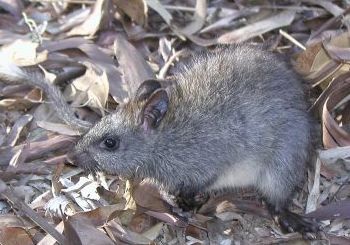 Kakadu National Park, one of the Australia’s “largest and best-resourced” protected areas, is experiencing a staggering decline in its small mammal population, according to a new study published in Wildlife Research. Spanning nearly 2 million hectares—larger than Fiji—the park lies in tropical northern Australia. “This decline is catastrophic,” John Woinarski, lead author of the study […]
Kakadu National Park, one of the Australia’s “largest and best-resourced” protected areas, is experiencing a staggering decline in its small mammal population, according to a new study published in Wildlife Research. Spanning nearly 2 million hectares—larger than Fiji—the park lies in tropical northern Australia. “This decline is catastrophic,” John Woinarski, lead author of the study […]
Photos: rats drive island lizard to extinction
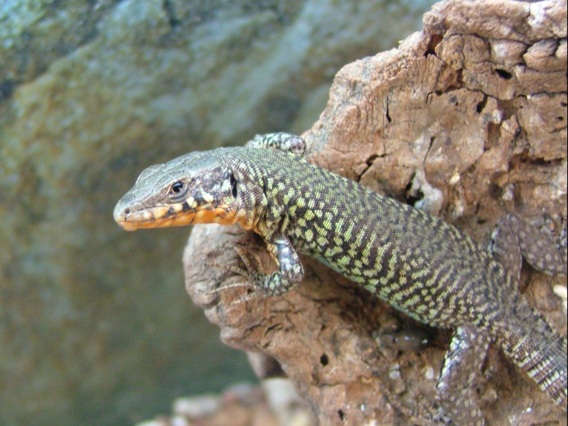 The Selmunett lizard (Podarcis filfolensis ssp. Kieselbachi) is very likely extinct, according to Maltese naturalist Arnold Sciberras. One of four subspecies of the Maltese wall lizard, the Selmunett lizard was last seen in 2005. Although the lizard’s home—Selmunett Island—has long been uninhabited by people, that fact did not help save the lizard. Over-predation by introduced […]
The Selmunett lizard (Podarcis filfolensis ssp. Kieselbachi) is very likely extinct, according to Maltese naturalist Arnold Sciberras. One of four subspecies of the Maltese wall lizard, the Selmunett lizard was last seen in 2005. Although the lizard’s home—Selmunett Island—has long been uninhabited by people, that fact did not help save the lizard. Over-predation by introduced […]
‘No hope now remains’ for the Alaotra grebe
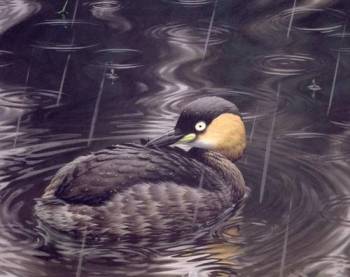 World governments have missed their goal of stemming biodiversity loss by this year, instead biodiversity loss has worsened according to scientists and policy-makers, and a little rusty-colored bird, the Alaotra grebe (Tachybaptus rufolavatus) is perhaps a victim of this failure to prioritize biodiversity conservation. Native to a small region in Madagascar, the grebe has been […]
World governments have missed their goal of stemming biodiversity loss by this year, instead biodiversity loss has worsened according to scientists and policy-makers, and a little rusty-colored bird, the Alaotra grebe (Tachybaptus rufolavatus) is perhaps a victim of this failure to prioritize biodiversity conservation. Native to a small region in Madagascar, the grebe has been […]
The Caribbean’s wonderfully weird (and threatened) mammals, an interview with Jose Nunez-Mino
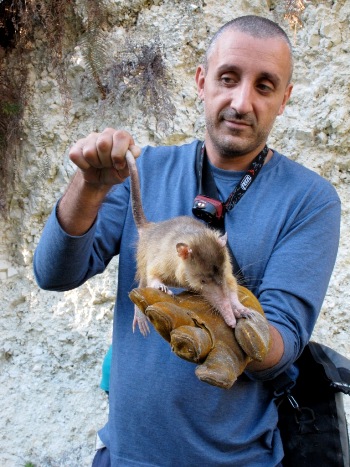 Not many people know the solenodon and the hutia, yet for the fortunate few that have encountered them, these strange little-studied mammals—just barely holding on in the Caribbean island of Hispaniola—deserve to be stars of the animal kingdom. “I could not quite believe it the first time I held a solenodon; I was in utter […]
Not many people know the solenodon and the hutia, yet for the fortunate few that have encountered them, these strange little-studied mammals—just barely holding on in the Caribbean island of Hispaniola—deserve to be stars of the animal kingdom. “I could not quite believe it the first time I held a solenodon; I was in utter […]
Gone: a look at extinction over the past decade
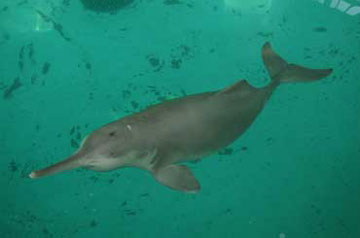 A survey of twelve species lost to extinction over the past ten years. No one can say with any certainty how many species went extinct from 2000-2009. Because no one knows if the world’s species number 3 million or 30 million, it is impossible to guess how many known species—let alone unknown—may have vanished recently. […]
A survey of twelve species lost to extinction over the past ten years. No one can say with any certainty how many species went extinct from 2000-2009. Because no one knows if the world’s species number 3 million or 30 million, it is impossible to guess how many known species—let alone unknown—may have vanished recently. […]
Not just the polar bear: ten American species that are feeling the heat from global warming
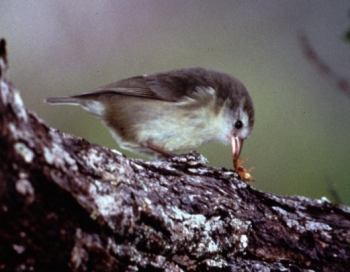 A new report, America’s Hottest Species, highlights a variety of American wildlife that are currently threatened by climate change from a small bird to a coral reef to the world’s largest marine turtle. “Global warming is like a bulldozer shoving species, already on the brink of extinction, perilously closer to the edge of existence,” said […]
A new report, America’s Hottest Species, highlights a variety of American wildlife that are currently threatened by climate change from a small bird to a coral reef to the world’s largest marine turtle. “Global warming is like a bulldozer shoving species, already on the brink of extinction, perilously closer to the edge of existence,” said […]
New killer snake invades Florida
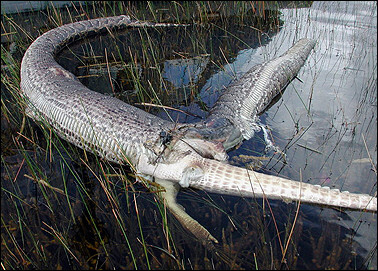 A new invasive python in Florida may be worse than the species already causing ecological havoc across the Everglades, reports the Miami Herald. A recent string of captures of African rock pythons has authorities worried that the species, smaller but much more aggressive than the already-established Burmese python, is getting a foothold in the state. […]
A new invasive python in Florida may be worse than the species already causing ecological havoc across the Everglades, reports the Miami Herald. A recent string of captures of African rock pythons has authorities worried that the species, smaller but much more aggressive than the already-established Burmese python, is getting a foothold in the state. […]
Employing dogs to save endangered species and places, an interview with Megan Parker
 An interview with Megan Parker, founder of Working Dogs for Conservation For millennia dogs have been helpers to humans: they have herded and protected livestock, pulled sleds, hunted game, led the blind, located people after disasters, and sniffed out drugs. Now a new occupation can be added: conservation aide. Working Dogs for Conservation (WDC) was […]
An interview with Megan Parker, founder of Working Dogs for Conservation For millennia dogs have been helpers to humans: they have herded and protected livestock, pulled sleds, hunted game, led the blind, located people after disasters, and sniffed out drugs. Now a new occupation can be added: conservation aide. Working Dogs for Conservation (WDC) was […]
Florida announces python hunt following snake invasion
 Florida has authorized a cull of Burmese pythons that have invaded the Everglades and other wetland areas, reports the Associated Press. A spokeswoman for the Florida Fish and Wildlife Conservation Commission, Pat Behnke, said ten snake-hunters would be dispatched to capture and euthanize Burmese pythons two weeks after the death of a toddler in her […]
Florida has authorized a cull of Burmese pythons that have invaded the Everglades and other wetland areas, reports the Associated Press. A spokeswoman for the Florida Fish and Wildlife Conservation Commission, Pat Behnke, said ten snake-hunters would be dispatched to capture and euthanize Burmese pythons two weeks after the death of a toddler in her […]
New report predicts dire consequences for every U.S. region from global warming
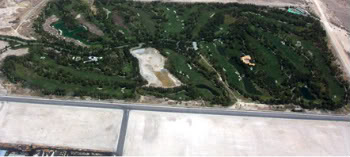 Sobering report is the most comprehensive to date. Government officials and scientists released a 196 page report detailing the impact of global warming on the U.S. yesterday. The study, commissioned in 2007 during the Bush Administration, found that every region of the U.S. faces large-scale consequences due to climate change, including higher temperatures, increased droughts, […]
Sobering report is the most comprehensive to date. Government officials and scientists released a 196 page report detailing the impact of global warming on the U.S. yesterday. The study, commissioned in 2007 during the Bush Administration, found that every region of the U.S. faces large-scale consequences due to climate change, including higher temperatures, increased droughts, […]
Have Australian cane toads finally met their match?
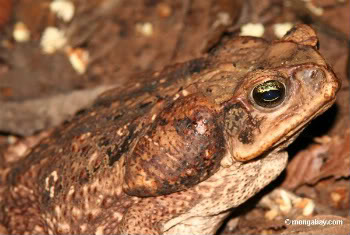 This weekend in Queensland, Australia the government held the first ‘Toad Day Out’ where hundreds of locals went hunting for the invasive cane toad, catching an estimated 10,000 toads to be euthanized. At the same time, researchers announced in the journal Functional Ecology that they may have discovered a native Australian species that will finally […]
This weekend in Queensland, Australia the government held the first ‘Toad Day Out’ where hundreds of locals went hunting for the invasive cane toad, catching an estimated 10,000 toads to be euthanized. At the same time, researchers announced in the journal Functional Ecology that they may have discovered a native Australian species that will finally […]
Extinct since 1963, wild eastern quolls discovered in Australia
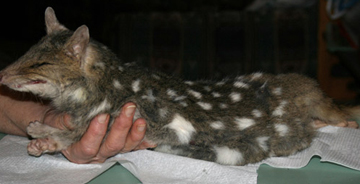 Extinct since 1963, wild eastern quolls discovered in Australia Extinct since 1963, wild eastern quolls discovered in Australia Jeremy Hance, mongabay.com October 17, 2008
Extinct since 1963, wild eastern quolls discovered in Australia Extinct since 1963, wild eastern quolls discovered in Australia Jeremy Hance, mongabay.com October 17, 2008
20 waterbirds added to threatened list
20 waterbirds added to threatened list 20 waterbirds added to threatened list mongabay.com October 2, 2008
Unknown but critically endangered iguana species discovered in Fiji
Unknown but critically endangered iguana species discovered in Fiji Unknown but critically endangered iguana species discovered in Fiji mongabay.com September 19, 2008 Researchers have discovered a third species of iguana in Fiji. It is believed to be critically endangered, with a population of a “few hundred”. The bright green lizard, which reaches a length of […]
Amphibians face mass extinction
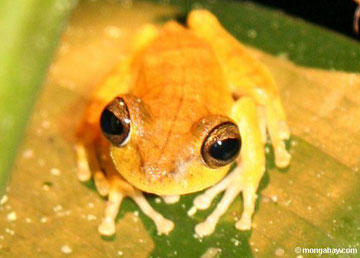 Amphibians face mass extinction Amphibians face mass extinction mongabay.com August 11, 2008 Amphibians are in big trouble. At least one third of the world’s 6,300 known species are threatened with extinction, while at least 200 species have gone extinct over the past 20 years. Worryingly the outbreak of a deadly fungal disease, chytridiomycosis, is spreading […]
Amphibians face mass extinction Amphibians face mass extinction mongabay.com August 11, 2008 Amphibians are in big trouble. At least one third of the world’s 6,300 known species are threatened with extinction, while at least 200 species have gone extinct over the past 20 years. Worryingly the outbreak of a deadly fungal disease, chytridiomycosis, is spreading […]
Cane toads are killing crocodiles in Australia
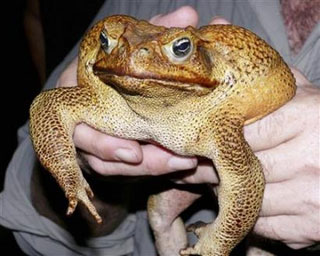 Cane toads are killing crocodiles in Australia Cane toads are killing crocodiles in Australia Jeremy Hance, mongabay.com July 30, 2008 Australia’s number one pest, the cane toad, devastates freshwater crocodile populations The cane toad has been a scourge to Australian wildlife for decades. An invasive species, the cane toad competes with local endemic frog species […]
Cane toads are killing crocodiles in Australia Cane toads are killing crocodiles in Australia Jeremy Hance, mongabay.com July 30, 2008 Australia’s number one pest, the cane toad, devastates freshwater crocodile populations The cane toad has been a scourge to Australian wildlife for decades. An invasive species, the cane toad competes with local endemic frog species […]
Birds face higher risk of extinction than conventionally thought
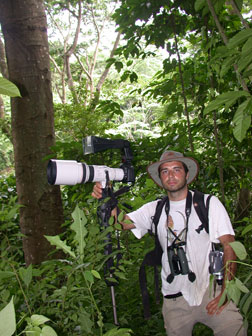 Birds face higher risk of extinction than conventionally thought Birds face higher risk of extinction than conventionally thought An interview with ornithologist Dr. Cagan Sekercioglu mongabay.com July 15, 2008 Birds may face higher risk of extinction than conventionally thought, says a bird ecology and conservation expert from Stanford University. Dr. Cagan H. Sekercioglu, a senior […]
Birds face higher risk of extinction than conventionally thought Birds face higher risk of extinction than conventionally thought An interview with ornithologist Dr. Cagan Sekercioglu mongabay.com July 15, 2008 Birds may face higher risk of extinction than conventionally thought, says a bird ecology and conservation expert from Stanford University. Dr. Cagan H. Sekercioglu, a senior […]
Climate change will cause significant disruptions to U.S. agriculture says Fed study
 Climate change will cause significant disruptions to U.S. agriculture says Fed study Climate change will cause significant disruptions to U.S. agriculture says Fed study mongabay.com May 28, 2008 Human-induced climate change will cause significant disruptions to water supplies, agriculture, and forestry in the United States in coming decades, says a federal report released Tuesday. The […]
Climate change will cause significant disruptions to U.S. agriculture says Fed study Climate change will cause significant disruptions to U.S. agriculture says Fed study mongabay.com May 28, 2008 Human-induced climate change will cause significant disruptions to water supplies, agriculture, and forestry in the United States in coming decades, says a federal report released Tuesday. The […]
Rat killing spree may save endangered wildlife on remote Pacific islands
Rat killing spree may save endangered wildlife on remote Pacific islands Rat killing spree may save endangered wildlife on remote Pacific islands mongabay.com May 26, 2008 A team of scientists is on its way to remote the Phoenix Islands Protected Area to eradicate rats that are threatening populations of indigenous seabirds, reports Conservation International, an […]
Invasive Species: Toad-ally out of control
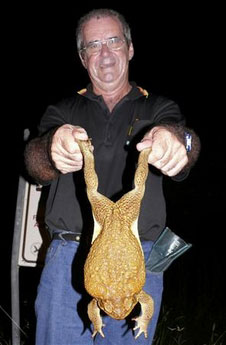 Invasive Species: Toad-ally out of control Invasive Species: Toad-ally out of control Ryan King, special to mongabay.com May 18, 2008 The ongoing epic of the cane toad foretells a grim future for ecologically sound management of introduced organisms Throughout warm, wet climates around the world lurks a camouflaged combatant seldom known beyond those who experience […]
Invasive Species: Toad-ally out of control Invasive Species: Toad-ally out of control Ryan King, special to mongabay.com May 18, 2008 The ongoing epic of the cane toad foretells a grim future for ecologically sound management of introduced organisms Throughout warm, wet climates around the world lurks a camouflaged combatant seldom known beyond those who experience […]
Borneo’s pygmy elephants are an alien species
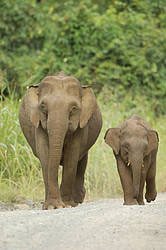 Borneo’s elephants are an alien species Borneo’s elephants are an alien species mongabay.com April 18, 2008 A new study suggests that the Borneo pygmy elephant — one of Borneo’s best known and charismatic animals — is actually an invasive species introduced from a neighboring island by a former sultan. The finding offers hope that in […]
Borneo’s elephants are an alien species Borneo’s elephants are an alien species mongabay.com April 18, 2008 A new study suggests that the Borneo pygmy elephant — one of Borneo’s best known and charismatic animals — is actually an invasive species introduced from a neighboring island by a former sultan. The finding offers hope that in […]
Invasive species cost China $14B per year
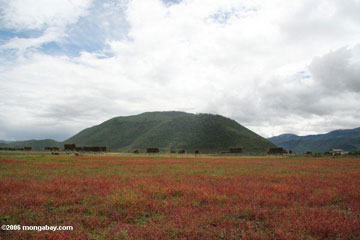 Invasive species cost China $14B per year Invasive species cost China $14B per year mongabay.com April 1, 2008 Rapid economic growth and giant infrastructure projects have allowed invasive species to spread throughout China and inflict more than $14.5 billion of damage to the nation’s economy annually, according to a study published in Bioscience. The research […]
Invasive species cost China $14B per year Invasive species cost China $14B per year mongabay.com April 1, 2008 Rapid economic growth and giant infrastructure projects have allowed invasive species to spread throughout China and inflict more than $14.5 billion of damage to the nation’s economy annually, according to a study published in Bioscience. The research […]
‘CAT scan’ shows Hawaiian forests invaded by alien species
 ‘CAT scan’ shows Hawaiian forests invaded by alien species ‘CAT scan’ shows Hawaiian forests invaded by alien species mongabay.com March 3, 2008 Invasive plant species are altering the ecology of Hawaiian rain forests, reports a study published in the Proceedings of the National Academy of Sciences (PNAS). Using a new type of remote sensing technology […]
‘CAT scan’ shows Hawaiian forests invaded by alien species ‘CAT scan’ shows Hawaiian forests invaded by alien species mongabay.com March 3, 2008 Invasive plant species are altering the ecology of Hawaiian rain forests, reports a study published in the Proceedings of the National Academy of Sciences (PNAS). Using a new type of remote sensing technology […]
Rats decimating Aleutian Islands’ ecology
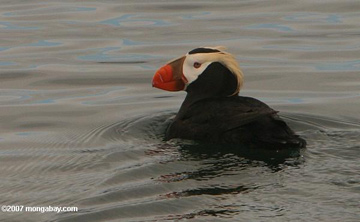 Rats decimating Aleutian Islands’ ecology Rats decimating Aleutian Islands’ ecology mongabay.com February 25, 2008 Rats are disrupting fragile ecosystems on the Aleutian Islands Archipelago, reports a new study published in the Proceedings of the National Academy of Sciences (PNAS). Conducting surveys of 32 islands in the Aleutian Archipelago, a team led by the University of […]
Rats decimating Aleutian Islands’ ecology Rats decimating Aleutian Islands’ ecology mongabay.com February 25, 2008 Rats are disrupting fragile ecosystems on the Aleutian Islands Archipelago, reports a new study published in the Proceedings of the National Academy of Sciences (PNAS). Conducting surveys of 32 islands in the Aleutian Archipelago, a team led by the University of […]
Warming could bring sharks to Antarctica with devastating ecological consequences
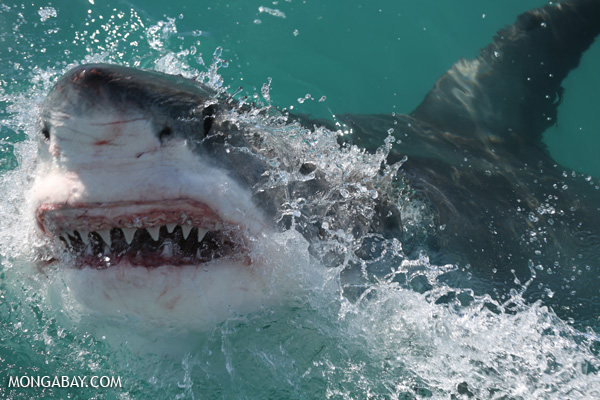 The Antarctic would still be too cold for Great White Sharks. Global warming could make the waters around Antarctica hospitable to sharks for the first time in 40 million years. Their return could have devastating ecological consequences report researchers from the University of Rhode Island. Analyzing the physiological adaptations and metabolism of sharks and other […]
The Antarctic would still be too cold for Great White Sharks. Global warming could make the waters around Antarctica hospitable to sharks for the first time in 40 million years. Their return could have devastating ecological consequences report researchers from the University of Rhode Island. Analyzing the physiological adaptations and metabolism of sharks and other […]
Invasive species hurt developing world economies
Invasive species hurt developing world economies Invasive species hurt developing world economies mongabay.com January 18, 2008 The ‘real’ costs of invasive species are underestimated in developing countries, argues a new report that calls for more research into the environmental, social and economic impact of non-native plants and animals. The report, published by the Global Invasive […]
Fish farms are killing wild salmon in British Columbia
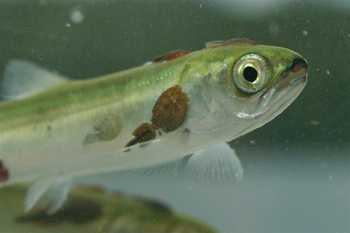 Fish farms are killing wild salmon in British Columbia Fish farms are killing wild salmon in British Columbia mongabay.com December 13, 2007 Parasitic sea lice infestations caused by salmon farms are driving nearby populations of wild salmon toward extinction, reports a study published in the December 14 issue of the journal Science. The research raises […]
Fish farms are killing wild salmon in British Columbia Fish farms are killing wild salmon in British Columbia mongabay.com December 13, 2007 Parasitic sea lice infestations caused by salmon farms are driving nearby populations of wild salmon toward extinction, reports a study published in the December 14 issue of the journal Science. The research raises […]
Cane toads to invade 2 million square kilometers of Australia
 Cane toads to invade 2 million square kilometers of Australia Cane toads to invade 2 million square kilometers of Australia Rhett A. Butler, mongabay.com April 3, 2007 Cane toads are dramatically expanding their range in Australia and may eventually double their current extent to occupy over 2 million square kilometers, according to new projections by […]
Cane toads to invade 2 million square kilometers of Australia Cane toads to invade 2 million square kilometers of Australia Rhett A. Butler, mongabay.com April 3, 2007 Cane toads are dramatically expanding their range in Australia and may eventually double their current extent to occupy over 2 million square kilometers, according to new projections by […]
Photos of monster cane toad captured in Australia
 Photos of monster cane toad captured in Australia Photos of monster cane toad captured in Australia mongabay.com March 27, 2007 A conservation group captured a giant cane toad in the Australian city of Darwin. The beast weighed 840 grams (1.8 pounds) and measured 20.5 cm (8 inches). The toad was captured as part of a […]
Photos of monster cane toad captured in Australia Photos of monster cane toad captured in Australia mongabay.com March 27, 2007 A conservation group captured a giant cane toad in the Australian city of Darwin. The beast weighed 840 grams (1.8 pounds) and measured 20.5 cm (8 inches). The toad was captured as part of a […]
Ladybugs ruin good wine
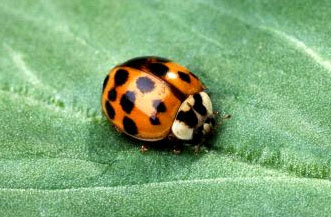 Ladybugs ruin good wine Ladybugs ruin good wine Rhett A. Butler, mongabay.com March 26, 2007 Secretions by ladybugs can taint the aroma and flavor of otherwise perfectly good wine, but scientists at Iowa State University say they may have devised a solution. Iowa State chemists have identified several compounds that are responsible for the ladybug’s […]
Ladybugs ruin good wine Ladybugs ruin good wine Rhett A. Butler, mongabay.com March 26, 2007 Secretions by ladybugs can taint the aroma and flavor of otherwise perfectly good wine, but scientists at Iowa State University say they may have devised a solution. Iowa State chemists have identified several compounds that are responsible for the ladybug’s […]
Invasive species is pestering Europe’s rich
Invasive species is pestering Europe’s rich Invasive species is pestering Europe’s rich mongabay.com March 24, 2007 An invasive species is causing mounting concern among rich Europeans according to an article in today’s edition of The Wall Street Journal Rhynchophorus ferrugineus, a palm weevil native to southeast Asia, is decimating ornamental palms across the Mediterranean, reportedly […]
Invasive predators more harmful to biodiversity than native predators
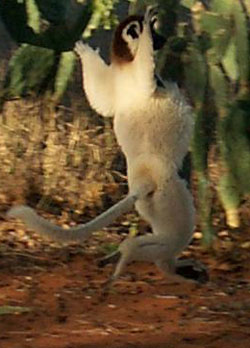 Alien predators are more harmful to prey populations than native predators, reports a study published in the current issue of the journal Proceedings of the Royal Society B: Biological Sciences. Analyzing prey response across dozens of field experiments in New Zealand, Australia, and island ecosystems, an international team of researchers led by Pälvi Salo of […]
Alien predators are more harmful to prey populations than native predators, reports a study published in the current issue of the journal Proceedings of the Royal Society B: Biological Sciences. Analyzing prey response across dozens of field experiments in New Zealand, Australia, and island ecosystems, an international team of researchers led by Pälvi Salo of […]
World’s bluest lizard headed toward extinction?
- High above the forest floor on the remote Colombian island of Gorgona lives a lizard with brilliant blue skin, rivaling the color of the sky.
- Anolis gorgonae, or the blue anole, is a species so elusive and rare, that scientists have been unable to give even an estimate of its population.
- Due to the lizard’s isolated habitat and reclusive habits, researchers know little about the blue anole, but are captivated by its stunning coloration.
Alien water weed re-invades Lake Victoria
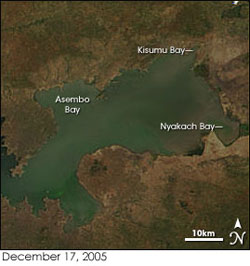 Alien water weed re-invades Lake Victoria Alien water weed re-invades Lake Victoria Rhett A. Butler, mongabay.com February 27, 2007 These images show the Winam Gulf, in the northeast corner of Lake Victoria in Kenya. In December 2005, when the right image was taken, the lake appeared to be clear. In November and December 2006, however, […]
Alien water weed re-invades Lake Victoria Alien water weed re-invades Lake Victoria Rhett A. Butler, mongabay.com February 27, 2007 These images show the Winam Gulf, in the northeast corner of Lake Victoria in Kenya. In December 2005, when the right image was taken, the lake appeared to be clear. In November and December 2006, however, […]
Invasive ants use genetic differences to distinguish friend from foe
 Invasive ants use genetic differences to distinguish friend from foe Invasive ants use genetic differences to distinguish friend from foe Argentine Ants Territorial When Neighbors Are Not Kin University of California, San Diego December 1, 2006 A study led by University of California, San Diego biologists shows that invasive Argentine ants appear to use genetic […]
Invasive ants use genetic differences to distinguish friend from foe Invasive ants use genetic differences to distinguish friend from foe Argentine Ants Territorial When Neighbors Are Not Kin University of California, San Diego December 1, 2006 A study led by University of California, San Diego biologists shows that invasive Argentine ants appear to use genetic […]
Add invasive species status to list of biofuel concerns
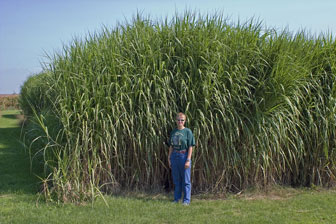 Add invasive species status to list of biofuel concerns Add invasive species status to list of biofuel concerns mongabay.com September 22, 2006 [Updated Sept. 23, 2006] High energy prices over the past couple years have fueled interest in biofuels, which proponents say are less damaging to the environment and provide energy security not afforded by […]
Add invasive species status to list of biofuel concerns Add invasive species status to list of biofuel concerns mongabay.com September 22, 2006 [Updated Sept. 23, 2006] High energy prices over the past couple years have fueled interest in biofuels, which proponents say are less damaging to the environment and provide energy security not afforded by […]
Invasive purple flower impacts Iceland’s biodiversity
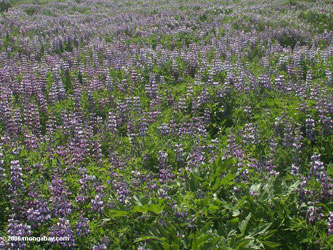 Invasive purple flower impacts Iceland’s biodiversity Invasive purple flower impacts Iceland’s biodiversity Nootka Lupine: Purple Menace or Miracle? Tina Butler July 24, 2006 Erosion is the gravest environmental problem Iceland faces today. Foliage loss, and ultimately soil erosion, occurs across the island, due largely to the extreme conditions of the environment, in particular the high […]
Invasive purple flower impacts Iceland’s biodiversity Invasive purple flower impacts Iceland’s biodiversity Nootka Lupine: Purple Menace or Miracle? Tina Butler July 24, 2006 Erosion is the gravest environmental problem Iceland faces today. Foliage loss, and ultimately soil erosion, occurs across the island, due largely to the extreme conditions of the environment, in particular the high […]
Tropical Asia needs to act to save biodiversity, say scientists
 Tropical Asia needs to act to save biodiversity, say scientists Tropical Asia needs to act to save biodiversity, say scientists mongabay.com July 22, 2006 A group of scientists urged governments of tropical Asia to take steps to stem biodiversity loss across the region. At the annual meeting for the Association for Tropical Biology and Conservation, […]
Tropical Asia needs to act to save biodiversity, say scientists Tropical Asia needs to act to save biodiversity, say scientists mongabay.com July 22, 2006 A group of scientists urged governments of tropical Asia to take steps to stem biodiversity loss across the region. At the annual meeting for the Association for Tropical Biology and Conservation, […]
Chinese invaders threaten Britain
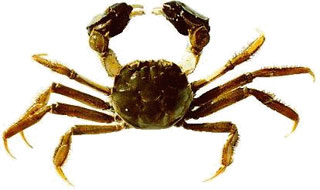 Chinese invaders threaten Britain Chinese invaders threaten Britain Invasive crab species could cause ecological havoc News release from the University of Newcastle upon Tyne February 8, 2006 An exotic type of crab is spreading at an alarming rate throughout Britain’s coast and rivers, a new study shows. The Chinese mitten crab, brought to Britain during […]
Chinese invaders threaten Britain Chinese invaders threaten Britain Invasive crab species could cause ecological havoc News release from the University of Newcastle upon Tyne February 8, 2006 An exotic type of crab is spreading at an alarming rate throughout Britain’s coast and rivers, a new study shows. The Chinese mitten crab, brought to Britain during […]
Easter Island's demise caused by rats, Dutch traders says new theory
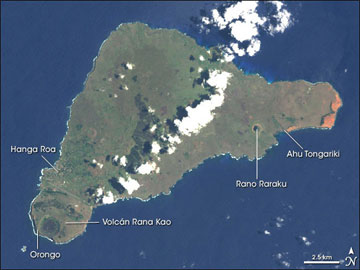 Easter Island’s demise caused by rats, Dutch traders says new theory Easter Island’s demise caused by rats, Dutch traders says new theory Rhett A. Butler, mongabay.com December 6, 2005 Rats and European traders may be responsible for the mysterious demise of Easter Island according to research presented last week by a University of Hawaii anthropologist […]
Easter Island’s demise caused by rats, Dutch traders says new theory Easter Island’s demise caused by rats, Dutch traders says new theory Rhett A. Butler, mongabay.com December 6, 2005 Rats and European traders may be responsible for the mysterious demise of Easter Island according to research presented last week by a University of Hawaii anthropologist […]
Invasive species date back thousands of years
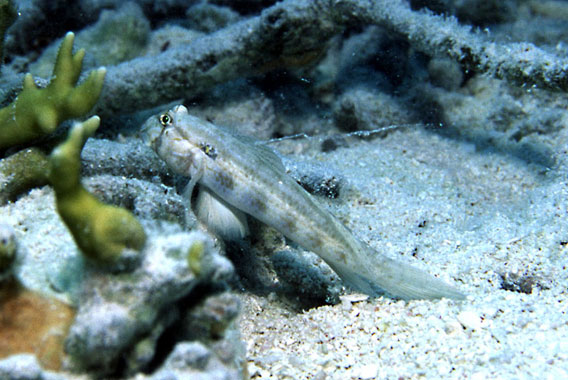 Invasive species in a historical context Invasive species in a historical context Smithsonian Tropical Research Institute October 13, 2005 New research published in Molecular Ecology suggests that climate change could trigger the expansion of invasive species into wider ranges. The study looked at the genetic history of a goby fish species in the Eastern Atlantic. […]
Invasive species in a historical context Invasive species in a historical context Smithsonian Tropical Research Institute October 13, 2005 New research published in Molecular Ecology suggests that climate change could trigger the expansion of invasive species into wider ranges. The study looked at the genetic history of a goby fish species in the Eastern Atlantic. […]
Invasive species may increase with global warming
 Invasive species may increase with global warming Invasive species may increase with global warming mongabay.com October 13, 2005 Michael Barron of the National Park Service took this picture of a carcass of an alligator as it protudes out from the body of a dead Burmese python in Everglades National Park, Florida. The Burmese python is […]
Invasive species may increase with global warming Invasive species may increase with global warming mongabay.com October 13, 2005 Michael Barron of the National Park Service took this picture of a carcass of an alligator as it protudes out from the body of a dead Burmese python in Everglades National Park, Florida. The Burmese python is […]
Python explodes after swallowing 6-foot alligator in Florida Everglades
 Fatal mistake: giant snakes eats alligator The National Park Service released photos that show the carcass of an American alligator that was almost swallowed by a Burmese python. Park officials discovered the animal carcasses in a remote part of Everglades National Park, in south Miami-Dade, Florida, on Monday, Sept. 26, 2005. It appears that the […]
Fatal mistake: giant snakes eats alligator The National Park Service released photos that show the carcass of an American alligator that was almost swallowed by a Burmese python. Park officials discovered the animal carcasses in a remote part of Everglades National Park, in south Miami-Dade, Florida, on Monday, Sept. 26, 2005. It appears that the […]
Cane toads increasingly a problem in Australia
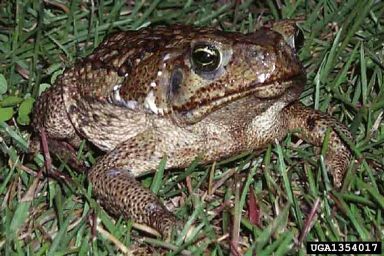 Cane toads increasingly a problem in Australia Cane toads increasingly a problem in Australia Overstaying Their Welcome: Cane Toads in Australia Tina Butler, mongabay.com April 17, 2005 About a week ago, an Australian Minister of Parliament from the Northern Territory sparked outrage from animal welfare groups, and probably a chuckle of recognition and commiseration among […]
Cane toads increasingly a problem in Australia Cane toads increasingly a problem in Australia Overstaying Their Welcome: Cane Toads in Australia Tina Butler, mongabay.com April 17, 2005 About a week ago, an Australian Minister of Parliament from the Northern Territory sparked outrage from animal welfare groups, and probably a chuckle of recognition and commiseration among […]
Feeds: news | india | latam | brasil | indonesia
 A state of emergency against illegal mining in Peru, open season for new mining ports in Chile, drones vs rats in the Galápagos, and jaguar corridors in Colombia are among the top recent stories from our Spanish-language service, Mongabay Latam. Massive raid on illegal mining in Peru’s Madre de Dios Peruvian security forces descended en […]
A state of emergency against illegal mining in Peru, open season for new mining ports in Chile, drones vs rats in the Galápagos, and jaguar corridors in Colombia are among the top recent stories from our Spanish-language service, Mongabay Latam. Massive raid on illegal mining in Peru’s Madre de Dios Peruvian security forces descended en […] The top stories from our Spanish-language service, Mongabay Latam, looked at jail sentences for wildlife traffickers in Bolivia; conserving river dolphins in Venezuela and culling lionfish in Colombia; and shark bycatch in Chile. Jaguar-tooth traffickers get up to four years’ prison in Bolivia A Bolivian court has set a legal precedent by sentencing traffickers in […]
The top stories from our Spanish-language service, Mongabay Latam, looked at jail sentences for wildlife traffickers in Bolivia; conserving river dolphins in Venezuela and culling lionfish in Colombia; and shark bycatch in Chile. Jaguar-tooth traffickers get up to four years’ prison in Bolivia A Bolivian court has set a legal precedent by sentencing traffickers in […] More isolated oceanic islands harbor fewer native species due to the fact that plants and animals are less capable of naturally dispersing to and colonizing those islands. This is known as the species-isolation relationship (SIR), one of the most fundamental concepts in the study of island biogeography. While the isolation of islands means that they […]
More isolated oceanic islands harbor fewer native species due to the fact that plants and animals are less capable of naturally dispersing to and colonizing those islands. This is known as the species-isolation relationship (SIR), one of the most fundamental concepts in the study of island biogeography. While the isolation of islands means that they […] Invasive species are among the greatest threats to the world’s biodiversity, and amphibians rank among the most devastating vertebrate invaders. That’s why the discovery of the Asian toad (Duttaphrynus melanostictus) in Madagascar’s second largest city and main port of Toamasina in March 2014 so alarmed conservationists. Should the newly introduced toad spread across the island […]
Invasive species are among the greatest threats to the world’s biodiversity, and amphibians rank among the most devastating vertebrate invaders. That’s why the discovery of the Asian toad (Duttaphrynus melanostictus) in Madagascar’s second largest city and main port of Toamasina in March 2014 so alarmed conservationists. Should the newly introduced toad spread across the island […] A lowland jungle stream in Java’s Ujung Kulon National Park. Photo: Rhett A. Butler Twenty years after ratifying a legally binding UN convention which obligates parties to deal with invasive alien species, considered to be main direct drivers of biodiversity loss across the globe, Indonesia has drawn up a national strategic plan on the matter. […]
A lowland jungle stream in Java’s Ujung Kulon National Park. Photo: Rhett A. Butler Twenty years after ratifying a legally binding UN convention which obligates parties to deal with invasive alien species, considered to be main direct drivers of biodiversity loss across the globe, Indonesia has drawn up a national strategic plan on the matter. […] Fishing gear stands ready next to the day’s catch on the shore of Lake Victoria. Photo credit: Isaiah Esipisu. Lake Victoria, Africa’s largest fresh water body and the world’s second largest lake, is no longer fresh. The lake is choking with pollution from industrial and agricultural wastes, as well as raw sewage from Kisumu, Kenya’s […]
Fishing gear stands ready next to the day’s catch on the shore of Lake Victoria. Photo credit: Isaiah Esipisu. Lake Victoria, Africa’s largest fresh water body and the world’s second largest lake, is no longer fresh. The lake is choking with pollution from industrial and agricultural wastes, as well as raw sewage from Kisumu, Kenya’s […] Young swift parrots (Lathamus discolour). Photo courtesy of Dejan Stojanovic. In the forests of Tasmania lives the swift parrot (Lathamus discolour), a highly threatened bird that breeds nowhere else in the world. New research published recently in Biological Conservation finds they are more at risk of extinction than previously thought, with introduced sugar gliders (Petaurus […]
Young swift parrots (Lathamus discolour). Photo courtesy of Dejan Stojanovic. In the forests of Tasmania lives the swift parrot (Lathamus discolour), a highly threatened bird that breeds nowhere else in the world. New research published recently in Biological Conservation finds they are more at risk of extinction than previously thought, with introduced sugar gliders (Petaurus […] Energy has become a contentious and politicized topic, spurring activism, whether it be the fossil fuel divestment campaign, Keystone pipeline protests, or concern over wind turbine harm to birds. But whatever energy future we choose, two things are clear: an expanding human population will need more energy, and no matter what energy source we pick, […]
Energy has become a contentious and politicized topic, spurring activism, whether it be the fossil fuel divestment campaign, Keystone pipeline protests, or concern over wind turbine harm to birds. But whatever energy future we choose, two things are clear: an expanding human population will need more energy, and no matter what energy source we pick, […] In a tiny area of an isolated archipelago in the southwest Pacific lives a unique tree species on the precipice of extinction. Recent research has shown it is declining dramatically, and mature individuals may be completely gone in 100 years. In response, environmental organizations and scientists are coming together to try and save New Caledonia’s […]
In a tiny area of an isolated archipelago in the southwest Pacific lives a unique tree species on the precipice of extinction. Recent research has shown it is declining dramatically, and mature individuals may be completely gone in 100 years. In response, environmental organizations and scientists are coming together to try and save New Caledonia’s […] Although only a nuisance in your home, on an isolated island chain (archipelago) off the northeastern coast of Brazil, rats pose a threat to the red-billed tropicbird (Phaethon aethereus). The seabird nests in the remote Abrolhos National Park, but two species of invasive rats prey on its eggs and young: the house rat (Rattus […]
Although only a nuisance in your home, on an isolated island chain (archipelago) off the northeastern coast of Brazil, rats pose a threat to the red-billed tropicbird (Phaethon aethereus). The seabird nests in the remote Abrolhos National Park, but two species of invasive rats prey on its eggs and young: the house rat (Rattus […] Biologists may have discovered essential information that could help trees overcome specific grass species on tropical forest restoration sites What happens to degraded pastureland once the cows are kicked out? After years of letting the area rest, does it eventually become what it once was? Not likely. When disruptions such as invasive species and human […]
Biologists may have discovered essential information that could help trees overcome specific grass species on tropical forest restoration sites What happens to degraded pastureland once the cows are kicked out? After years of letting the area rest, does it eventually become what it once was? Not likely. When disruptions such as invasive species and human […] A female common earwig (Forficula auricularia) in defensive posture. The world’s largest earwig has been declared extinct. Photo by: Public Domain. The world has lost a giant: this week the IUCN Red List officially declared St. Helena giant earwig (Labidura herculeana) extinct. While its length of 80 millimeters (3.1 inches) may not seem like much, […]
A female common earwig (Forficula auricularia) in defensive posture. The world’s largest earwig has been declared extinct. Photo by: Public Domain. The world has lost a giant: this week the IUCN Red List officially declared St. Helena giant earwig (Labidura herculeana) extinct. While its length of 80 millimeters (3.1 inches) may not seem like much, […] Innovation in Tropical Forest Conservation: Q&A with Ariel Lugo Ariel Lugo overlooking an urban watershed in Puerto Rico. Photo courtesy of Ariel Lugo. Think first before you eradicate non-native species says Dr. Ariel E. Lugo, the current director of the International Institute of Tropical Forestry within the USDA Forest Service, based in Puerto Rico. Lugo, […]
Innovation in Tropical Forest Conservation: Q&A with Ariel Lugo Ariel Lugo overlooking an urban watershed in Puerto Rico. Photo courtesy of Ariel Lugo. Think first before you eradicate non-native species says Dr. Ariel E. Lugo, the current director of the International Institute of Tropical Forestry within the USDA Forest Service, based in Puerto Rico. Lugo, […] Study calls into question the efficacy of agroforests in conserving biodiversity With an estimated population of 700 million individuals, domestic dogs are the most abundant carnivore in the world and are present everywhere that man has settled. Domestic dogs, commonly referred to as man’s best friend, are not usually viewed as a huge threat to […]
Study calls into question the efficacy of agroforests in conserving biodiversity With an estimated population of 700 million individuals, domestic dogs are the most abundant carnivore in the world and are present everywhere that man has settled. Domestic dogs, commonly referred to as man’s best friend, are not usually viewed as a huge threat to […] Invasive predator can live in nearly freshwater environments, may threaten estuaries, rivers You may have recently read the controversial story on invasive lionfish research involving Dr. Zack Jud of Florida International University and a young girl named Lauren Arrington. While the issue of attribution in scientific research is crucial to the discipline, much of the […]
Invasive predator can live in nearly freshwater environments, may threaten estuaries, rivers You may have recently read the controversial story on invasive lionfish research involving Dr. Zack Jud of Florida International University and a young girl named Lauren Arrington. While the issue of attribution in scientific research is crucial to the discipline, much of the […] Iselle damage in Hawaii. Photo by Greg Asner Damage from Hurricane Iselle, which recently battered Hawaii’s Big Island, was exacerbated by invasion of non-native tree species, say experts who have studied the transformation of Hawaii’s native forests. Iselle, which made landfall on the Big Island on August 7, was the third-strongest tropical cyclone to hit […]
Iselle damage in Hawaii. Photo by Greg Asner Damage from Hurricane Iselle, which recently battered Hawaii’s Big Island, was exacerbated by invasion of non-native tree species, say experts who have studied the transformation of Hawaii’s native forests. Iselle, which made landfall on the Big Island on August 7, was the third-strongest tropical cyclone to hit […] New threat is reducing the food supply of one of the world’s rarest animals The last of Indonesia’s critically endangered Javan rhinoceroses have survived poachers, rapid deforestation and life in the shadow of one of the archipelago’s most active volcanoes. But an invasive plant is now posing a new threat to the world’s rarest species […]
New threat is reducing the food supply of one of the world’s rarest animals The last of Indonesia’s critically endangered Javan rhinoceroses have survived poachers, rapid deforestation and life in the shadow of one of the archipelago’s most active volcanoes. But an invasive plant is now posing a new threat to the world’s rarest species […] Since the arrival of Homo sapiens, other species have been going extinct at an unprecedented rate. Most scientists now agree that extinction rates are between 100 and 1000 times greater than before humans existed. Working out what is driving these extinctions is fiendishly complicated, but a new study by scientists from the University of California, […]
Since the arrival of Homo sapiens, other species have been going extinct at an unprecedented rate. Most scientists now agree that extinction rates are between 100 and 1000 times greater than before humans existed. Working out what is driving these extinctions is fiendishly complicated, but a new study by scientists from the University of California, […] The spiked pepper tree (Piper aduncum) is native to the American tropics, but has made itself at home in a variety of other locales where it can crowd out local vegetation and interfere with forest recovery. Although it’s been slow to spread through Borneo since its introduction to Indonesia in 1952, new logging roads appear […]
The spiked pepper tree (Piper aduncum) is native to the American tropics, but has made itself at home in a variety of other locales where it can crowd out local vegetation and interfere with forest recovery. Although it’s been slow to spread through Borneo since its introduction to Indonesia in 1952, new logging roads appear […] Nicaragua’s plans for a canal linking the Pacific and Atlantic Oceans could trigger an environmental disaster through habitat destruction and alteration, introduction of non-native species, pollution, and sedimentation, warns a commentary published in this week’s issue of Nature. The ambitious project, which aims to compete with the recently-expanded Panama Canal, is being developed by HK […]
Nicaragua’s plans for a canal linking the Pacific and Atlantic Oceans could trigger an environmental disaster through habitat destruction and alteration, introduction of non-native species, pollution, and sedimentation, warns a commentary published in this week’s issue of Nature. The ambitious project, which aims to compete with the recently-expanded Panama Canal, is being developed by HK […] The female Hispaniolan solenodon caught by Nicolas Corona in the Dominican Republic. She’s awaiting being fitted with a radio collar. Photo by: Tiffany Roufs. So, here I am, running in a forest at night over 2,000 miles from home. This forest—dry, stout, and thorny enough to draw blood—lies just a few miles north of a […]
The female Hispaniolan solenodon caught by Nicolas Corona in the Dominican Republic. She’s awaiting being fitted with a radio collar. Photo by: Tiffany Roufs. So, here I am, running in a forest at night over 2,000 miles from home. This forest—dry, stout, and thorny enough to draw blood—lies just a few miles north of a […] If you, or someone you know, owns a freshwater aquarium, chances are you have seen the peculiar little creature attached face-first to the glass in effort to find a morsel of algae. This algae eater, popularly known as the sucker fish, is the sailfin catfish, or plecos. It is one of the most commonly purchased […]
If you, or someone you know, owns a freshwater aquarium, chances are you have seen the peculiar little creature attached face-first to the glass in effort to find a morsel of algae. This algae eater, popularly known as the sucker fish, is the sailfin catfish, or plecos. It is one of the most commonly purchased […] As tropical forests worldwide are increasingly cut into smaller and smaller fragments, mammal extinctions may not be far behind, according to a new study in Science. Tracking native smalls mammals in Chiew Larn Reservoir, Thailand for over 25 years, scientists found a stunning and rapid decline in mammal populations, until most forests were almost completely […]
As tropical forests worldwide are increasingly cut into smaller and smaller fragments, mammal extinctions may not be far behind, according to a new study in Science. Tracking native smalls mammals in Chiew Larn Reservoir, Thailand for over 25 years, scientists found a stunning and rapid decline in mammal populations, until most forests were almost completely […] We now live in a world dominated by humans (the Anthropocene), whose activities on Earth are resulting in new habitats and new environmental conditions including climate change. To many, the Anthropocene is an era of environmental doom that unless reversed, will result in catastrophic reductions in biodiversity. An alternate view is that the biota will […]
We now live in a world dominated by humans (the Anthropocene), whose activities on Earth are resulting in new habitats and new environmental conditions including climate change. To many, the Anthropocene is an era of environmental doom that unless reversed, will result in catastrophic reductions in biodiversity. An alternate view is that the biota will […] Gary Schmelz, in a Journey to the Edge of Eden, takes us through a wonderful personal account of the conservation history of Southwest Florida. Journey to the Edge of Eden is one part personal memoir similar to the English naturalist Gerald Durrell and one part Florida conservation history. With hilarious stories of unintended naturalist misadventures […]
Gary Schmelz, in a Journey to the Edge of Eden, takes us through a wonderful personal account of the conservation history of Southwest Florida. Journey to the Edge of Eden is one part personal memoir similar to the English naturalist Gerald Durrell and one part Florida conservation history. With hilarious stories of unintended naturalist misadventures […] A team on South Georgia has successfully completed the world’s largest rodent eradication in an effort to rid the British territory of millions of rats and mice. Against the backdrop of an approaching Antarctic winter between February and May, three helicopters encountered perilous flying conditions while peppering the southern Atlantic island with 183 tonnes of […]
A team on South Georgia has successfully completed the world’s largest rodent eradication in an effort to rid the British territory of millions of rats and mice. Against the backdrop of an approaching Antarctic winter between February and May, three helicopters encountered perilous flying conditions while peppering the southern Atlantic island with 183 tonnes of […].600.jpg) Ordinarily, invasive and exotic species are a grave threat to native wildlife: outcompeting local species, introducing parasites and disease, and disturbing local ecological regimes. A unique case in the Brazilian Pantanal, however, has turned the tables; here, an introduced mammal has actually aided the conservation of native wildlife. The impact of feral pigs (Sus scrofa) […]
Ordinarily, invasive and exotic species are a grave threat to native wildlife: outcompeting local species, introducing parasites and disease, and disturbing local ecological regimes. A unique case in the Brazilian Pantanal, however, has turned the tables; here, an introduced mammal has actually aided the conservation of native wildlife. The impact of feral pigs (Sus scrofa) […].600.jpg) New Zealand’s Department of Conservation (DOC) is facing a backlash over plans to aerially drop a controversial poison, known as 1080, over the habitat of two endangered, prehistoric, and truly bizarre frog species, Archey’s and Hochsetter’s frogs, on Mount Moehau. Used in New Zealand to kill populations of invasive mammals, such as rats and the […]
New Zealand’s Department of Conservation (DOC) is facing a backlash over plans to aerially drop a controversial poison, known as 1080, over the habitat of two endangered, prehistoric, and truly bizarre frog species, Archey’s and Hochsetter’s frogs, on Mount Moehau. Used in New Zealand to kill populations of invasive mammals, such as rats and the […] Oil palm estate in Malaysia. Photo by: Rhett A. Butler. Ants are an important ecological group in both degraded and natural habitats. They interact with many other species and mediate a range of ecological processes. These interactions are often interpreted in the context of ant mosaics, where dominant species form strict territories, keeping other ants […]
Oil palm estate in Malaysia. Photo by: Rhett A. Butler. Ants are an important ecological group in both degraded and natural habitats. They interact with many other species and mediate a range of ecological processes. These interactions are often interpreted in the context of ant mosaics, where dominant species form strict territories, keeping other ants […] Black River Gorges National Park, Mauritius. Native species on the island of Mauritius have long had to deal with invasive species. In fact, invasives likely played a major role in the extinction of the Mauritius’ most famous resident, the dodo. While scientists have long cataloged the impact of invasive animals on island wildlife, there has […]
Black River Gorges National Park, Mauritius. Native species on the island of Mauritius have long had to deal with invasive species. In fact, invasives likely played a major role in the extinction of the Mauritius’ most famous resident, the dodo. While scientists have long cataloged the impact of invasive animals on island wildlife, there has […] The Role of Science for Conservation, edited by Matthias Wolff and Mark Gardner, celebrates Charles Darwin’s Bicentennial and 50 years of research by the Charles Darwin Foundation in The Galápagos, Ecuador. Using The Galápagos as a case study, The Role of Science for Conservation communicates to a wide audience about themes from a broad range […]
The Role of Science for Conservation, edited by Matthias Wolff and Mark Gardner, celebrates Charles Darwin’s Bicentennial and 50 years of research by the Charles Darwin Foundation in The Galápagos, Ecuador. Using The Galápagos as a case study, The Role of Science for Conservation communicates to a wide audience about themes from a broad range […] Lethal chytrid fungus discovered in Singapore. The bullfrog is believed to be spreading chytrid fungus to wild frogs in Southeast Asia. Photo courtesy of WCS. Scientists have documented a series of links between exotic frogs for trade and diseases in wild frogs in Southeast Asia, including the first documented case of the chytrid fungus—a virulent […]
Lethal chytrid fungus discovered in Singapore. The bullfrog is believed to be spreading chytrid fungus to wild frogs in Southeast Asia. Photo courtesy of WCS. Scientists have documented a series of links between exotic frogs for trade and diseases in wild frogs in Southeast Asia, including the first documented case of the chytrid fungus—a virulent […] Illustration of the little dodo likely based on stuffed specimens. By: John Gould. Sometime in the late 1600s the world’s last dodo perished on the island of Mauritius. No one knows how it spent its final moments—rather in the grip of some invasive predator or simply fading away from loneliness—but with its passing came an […]
Illustration of the little dodo likely based on stuffed specimens. By: John Gould. Sometime in the late 1600s the world’s last dodo perished on the island of Mauritius. No one knows how it spent its final moments—rather in the grip of some invasive predator or simply fading away from loneliness—but with its passing came an […] Helmeted guineafowl in native habitat in Pilanesberg Reserve, South Africa. Photo courtesy of Çağan Şekercioğlu. As Turkey raises and releases thousands of non-native helmeted guineafowl (Numida meleagris) to eat ticks that carry the deadly Crimean-Congo hemorrhagic fever virus, new research suggests guineafowl actually eat few ticks, carry the parasites on their feathers, and further spread […]
Helmeted guineafowl in native habitat in Pilanesberg Reserve, South Africa. Photo courtesy of Çağan Şekercioğlu. As Turkey raises and releases thousands of non-native helmeted guineafowl (Numida meleagris) to eat ticks that carry the deadly Crimean-Congo hemorrhagic fever virus, new research suggests guineafowl actually eat few ticks, carry the parasites on their feathers, and further spread […] Killing machine Domesticated cats in the United States kill far more animals than previously thought — 1.4 to 3.7 billion birds and 6.9 – 20.7 billion small mammals per year — finds a study published this week in the journal Nature Communications. Extrapolating from local studies, scientists at the Smithsonian Conservation Biology Institute and the […]
Killing machine Domesticated cats in the United States kill far more animals than previously thought — 1.4 to 3.7 billion birds and 6.9 – 20.7 billion small mammals per year — finds a study published this week in the journal Nature Communications. Extrapolating from local studies, scientists at the Smithsonian Conservation Biology Institute and the […] The 3rd Annual New York Wildlife Conservation Film Festival (WFCC.org) runs from January 30 – February 2, 2013. Ahead of the event, Mongabay.com is running a series of Q&As with filmmakers and presenters. For more interviews, please see our WCFF feed. Jimmy, an orphan whose mother was rundown by a car, is the star of […]
The 3rd Annual New York Wildlife Conservation Film Festival (WFCC.org) runs from January 30 – February 2, 2013. Ahead of the event, Mongabay.com is running a series of Q&As with filmmakers and presenters. For more interviews, please see our WCFF feed. Jimmy, an orphan whose mother was rundown by a car, is the star of […] An interview with Hanniki Pieterse Western leopard toad signs that were put up this year. Photo courtesy of: Hanniki Pieterse. August marks the last month of winter in South Africa, and, as temperatures begin to rise, activists in Cape Town prepare for a truly unique conservation event. Every year at this time western leopard toads […]
An interview with Hanniki Pieterse Western leopard toad signs that were put up this year. Photo courtesy of: Hanniki Pieterse. August marks the last month of winter in South Africa, and, as temperatures begin to rise, activists in Cape Town prepare for a truly unique conservation event. Every year at this time western leopard toads […] Blue iguana in Queen Elizabeth II Botanic Park. Photo by: Lhb1239. The wild blue iguana population has increased by at least 15 times in the last ten years, prompting the IUCN Red List to move the species from Critically Endangered to just Endangered. A targeted, ambitious conservation program, headed by the Blue Iguana Recovery Team, […]
Blue iguana in Queen Elizabeth II Botanic Park. Photo by: Lhb1239. The wild blue iguana population has increased by at least 15 times in the last ten years, prompting the IUCN Red List to move the species from Critically Endangered to just Endangered. A targeted, ambitious conservation program, headed by the Blue Iguana Recovery Team, […] The accidental introduction of the brown tree snake on Guam has resulted in a loss of birds and a subsequent explosion of spiders. Photo by: Isaac Chellman. The island of Guam is drowning in spiders. New research in the open-access journal PLOS ONE has found that in the wet season, Guam’s arachnid population booms to […]
The accidental introduction of the brown tree snake on Guam has resulted in a loss of birds and a subsequent explosion of spiders. Photo by: Isaac Chellman. The island of Guam is drowning in spiders. New research in the open-access journal PLOS ONE has found that in the wet season, Guam’s arachnid population booms to […] Orange-tailed skink hatchlings meet their match in a matchstick. Photo courtesy of the Durrell Wildlife Conservation Trust (DWCT). Three female orange-tailed skinks skinks have produced 16 skink babies in just four months, according to the Durrell Wildlife Conservation Trust (DWCT), which is captive breeding the Critically Endangered species. The breeding efforts are all the more […]
Orange-tailed skink hatchlings meet their match in a matchstick. Photo courtesy of the Durrell Wildlife Conservation Trust (DWCT). Three female orange-tailed skinks skinks have produced 16 skink babies in just four months, according to the Durrell Wildlife Conservation Trust (DWCT), which is captive breeding the Critically Endangered species. The breeding efforts are all the more […] On Aug. 10, 2012, researchers at the Florida Museum of Natural History on the University of Florida campus examine the internal anatomy of the largest Burmese python found in Florida to date. The 17-foot-7-inch snake weighed 164 pounds and carried 87 eggs in its oviducts, a state record. Following scientific investigation, the snake will be […]
On Aug. 10, 2012, researchers at the Florida Museum of Natural History on the University of Florida campus examine the internal anatomy of the largest Burmese python found in Florida to date. The 17-foot-7-inch snake weighed 164 pounds and carried 87 eggs in its oviducts, a state record. Following scientific investigation, the snake will be […]-(Large).568.jpg) World’s rarest snake: Saint Lucia racer. Photo by: G. Guida. It’s slithery, brown, and doesn’t mind being picked up: meet the Saint Lucia racer (Liophis ornatus), which holds the dubious honor of being the world’s most endangered snake. A five month extensive survey found just 18 animals on a small islet off of the Caribbean […]
World’s rarest snake: Saint Lucia racer. Photo by: G. Guida. It’s slithery, brown, and doesn’t mind being picked up: meet the Saint Lucia racer (Liophis ornatus), which holds the dubious honor of being the world’s most endangered snake. A five month extensive survey found just 18 animals on a small islet off of the Caribbean […] Lonesome George, the last of his kind, has passed away. Lonesome George, the sole surviving member of the Pinta Island tortoise (Chelonoidis nigra abingdoni), was found dead on Sunday by staff at the Galapagos National Park. With George’s passing, the Pinta Island tortoise subspecies officially falls into extinction. First found in 1972, Lonesome George became […]
Lonesome George, the last of his kind, has passed away. Lonesome George, the sole surviving member of the Pinta Island tortoise (Chelonoidis nigra abingdoni), was found dead on Sunday by staff at the Galapagos National Park. With George’s passing, the Pinta Island tortoise subspecies officially falls into extinction. First found in 1972, Lonesome George became […] Beach on Palmyra Atoll. Ecologists have long argued that everything in the nature is connected, but teasing out these intricate connections is not so easy. In fact, it took research on a remote, unoccupied island for scientists to discover that manta ray abundance was linked to seabirds and thereby native trees. Working in the U.S. […]
Beach on Palmyra Atoll. Ecologists have long argued that everything in the nature is connected, but teasing out these intricate connections is not so easy. In fact, it took research on a remote, unoccupied island for scientists to discover that manta ray abundance was linked to seabirds and thereby native trees. Working in the U.S. […] Now extinct: the Christmas Island pipistrelle. Photo by: Lindy Lumsden. Nights on Christmas Island in the Indian Ocean will never again be the same. The last echolocation call of a tiny bat native to the island, the Christmas Island pipistrelle (Pipistrellus murrayi), was recorded on August 26th 2009, and since then there has been only […]
Now extinct: the Christmas Island pipistrelle. Photo by: Lindy Lumsden. Nights on Christmas Island in the Indian Ocean will never again be the same. The last echolocation call of a tiny bat native to the island, the Christmas Island pipistrelle (Pipistrellus murrayi), was recorded on August 26th 2009, and since then there has been only […] New species: the Anguilla Bank skink. Photo by: Karl Questal. In a single paper in Zootaxa scientists have rewritten the current understanding of lizard biodiversity in the Caribbean. By going over museum specimens of skinks, scientists have discovered 24 new species and re-established nine species previously described species, long-thought invalid. The single paper has increased […]
New species: the Anguilla Bank skink. Photo by: Karl Questal. In a single paper in Zootaxa scientists have rewritten the current understanding of lizard biodiversity in the Caribbean. By going over museum specimens of skinks, scientists have discovered 24 new species and re-established nine species previously described species, long-thought invalid. The single paper has increased […] Scientists have called for the removal of eight invasive primates from Brazil’s imperiled Atlantic Forest in a new study published in mongabay.com’s open access journal Tropical Conservation Society (TCS). The researchers fear that the eight alien monkeys could hurt other species due to increased competition, predation, and possible disease. “The problem of introduced primate species […]
Scientists have called for the removal of eight invasive primates from Brazil’s imperiled Atlantic Forest in a new study published in mongabay.com’s open access journal Tropical Conservation Society (TCS). The researchers fear that the eight alien monkeys could hurt other species due to increased competition, predation, and possible disease. “The problem of introduced primate species […] An American alligator and a Burmese python struggle in Everglades National Park. Photo by: Lori Oberhofer, U.S. National Park Service. The Everglades in southern Florida has faced myriad environmental impacts from draining for sprawl to the construction of canals, but even as the U.S. government moves slowly on an ambitious plan to restore the massive […]
An American alligator and a Burmese python struggle in Everglades National Park. Photo by: Lori Oberhofer, U.S. National Park Service. The Everglades in southern Florida has faced myriad environmental impacts from draining for sprawl to the construction of canals, but even as the U.S. government moves slowly on an ambitious plan to restore the massive […] Invasive American bullfrog in British Colombia. Photo by: Alan D. Wils. Santa Cruz, California has become the first city in the U.S. to ban the importation, sale, release, and possession of the American bullfrog (Rana catesbeiana). Found throughout Eastern and Central U.S., the frogs have become an invasive threat to wildlife in the western U.S. […]
Invasive American bullfrog in British Colombia. Photo by: Alan D. Wils. Santa Cruz, California has become the first city in the U.S. to ban the importation, sale, release, and possession of the American bullfrog (Rana catesbeiana). Found throughout Eastern and Central U.S., the frogs have become an invasive threat to wildlife in the western U.S. […] An American alligator and a Burmese python struggle in Everglades National Park. Photo by: Lori Oberhofer, U.S. National Park Service. Last week the U.S. Fish and Wildlife Service (USFWS) announced it was banning the importation and sale across state lines of four large, non-native snakes: the Burmese python (Python molurus bivittatus), the yellow anaconda (Eunectes […]
An American alligator and a Burmese python struggle in Everglades National Park. Photo by: Lori Oberhofer, U.S. National Park Service. Last week the U.S. Fish and Wildlife Service (USFWS) announced it was banning the importation and sale across state lines of four large, non-native snakes: the Burmese python (Python molurus bivittatus), the yellow anaconda (Eunectes […] Hawaii evokes images of a tropical paradise where fragrant flowers, vivid colors, exotic plants, birds, and fish abound. Unfortunately, much of Hawaii’s original native flora and fauna has disappeared since the arrival of Europeans in the 18th Century. Hawaii now has the dubious distinction as having become the planet’s extinction capital, having lost more than […]
Hawaii evokes images of a tropical paradise where fragrant flowers, vivid colors, exotic plants, birds, and fish abound. Unfortunately, much of Hawaii’s original native flora and fauna has disappeared since the arrival of Europeans in the 18th Century. Hawaii now has the dubious distinction as having become the planet’s extinction capital, having lost more than […] Everyone knows the tiger, the panda, the blue whale, but what about the other five to thirty million species estimated to inhabit our Earth? Many of these marvelous, stunning, and rare species have received little attention from the media, conservation groups, and the public. This series is an attempt to give these ‘forgotten species‘ some […]
Everyone knows the tiger, the panda, the blue whale, but what about the other five to thirty million species estimated to inhabit our Earth? Many of these marvelous, stunning, and rare species have received little attention from the media, conservation groups, and the public. This series is an attempt to give these ‘forgotten species‘ some […] Murciélago Islands as seen by Google Earth. The Murciélago Islands are seven small islands off the northwest coast of Costa Rica in the Area de Conservación Guanacaste (ACG), home to one of the largest intact dry tropical forests in Central America. Despite this, few scientists have studied the biodiversity of these small uninhabited islands. A […]
Murciélago Islands as seen by Google Earth. The Murciélago Islands are seven small islands off the northwest coast of Costa Rica in the Area de Conservación Guanacaste (ACG), home to one of the largest intact dry tropical forests in Central America. Despite this, few scientists have studied the biodiversity of these small uninhabited islands. A […] An African land snail Limicolaria flammea has been discovered by researchers in six locations in Singapore, perhaps heralding a new invasion of alien land snails in Southeast Asia. Although snails may seem largely innocuous creatures, past invasions have resulted in agricultural and economic damage. The global invasion of the giant African land snail (Achatina fulica) […]
An African land snail Limicolaria flammea has been discovered by researchers in six locations in Singapore, perhaps heralding a new invasion of alien land snails in Southeast Asia. Although snails may seem largely innocuous creatures, past invasions have resulted in agricultural and economic damage. The global invasion of the giant African land snail (Achatina fulica) […] Very few studies have been conducted on invasive species in Nigeria, however a new study in mongabay.com’s open access journal Tropical Conservation Science has discovered 25 invasive plants in a field gene bank at the National Center for Genetic Resources and Biotechnology (NASGRAB) in Ibadan. The gene bank is used to establish populations of important […]
Very few studies have been conducted on invasive species in Nigeria, however a new study in mongabay.com’s open access journal Tropical Conservation Science has discovered 25 invasive plants in a field gene bank at the National Center for Genetic Resources and Biotechnology (NASGRAB) in Ibadan. The gene bank is used to establish populations of important […] Northern rockhopper penguins covered in oil. Photo by: Tristan Conservation Team of Simon Glass, Wayne Swain and Matthew Green. Courtesy of: The Tristan da Cunha Website. Disturbing photos show northern rockhopper penguins (Eudyptes moseleyi) hit hard by an oil spill from a wrecked cargo ship on Nightingale Island in the Southern Atlantic. Already listed as […]
Northern rockhopper penguins covered in oil. Photo by: Tristan Conservation Team of Simon Glass, Wayne Swain and Matthew Green. Courtesy of: The Tristan da Cunha Website. Disturbing photos show northern rockhopper penguins (Eudyptes moseleyi) hit hard by an oil spill from a wrecked cargo ship on Nightingale Island in the Southern Atlantic. Already listed as […] Nightingale Island as viewed from Google Earth. Conservation workers have found hundreds of oiled northern rockhopper penguins (Eudyptes moseleyi) after a cargo vessel wrecked on Nightingale Island, apart of the UK’s Tristan da Cunha archipelago. Northern rockhopper penguins are listed as Endangered by the IUCN Red List. According to a press release by BirdLife International, […]
Nightingale Island as viewed from Google Earth. Conservation workers have found hundreds of oiled northern rockhopper penguins (Eudyptes moseleyi) after a cargo vessel wrecked on Nightingale Island, apart of the UK’s Tristan da Cunha archipelago. Northern rockhopper penguins are listed as Endangered by the IUCN Red List. According to a press release by BirdLife International, […] On February 2nd, Conservation International (CI) released a list of the world’s top 10 most threatened forest hotspots. The original press release incorrectly named New Zealand as number two, when in fact it is the island of New Caledonia and the surrounding East Melanesian islands. Down to only 5% of its original forest landscape, New […]
On February 2nd, Conservation International (CI) released a list of the world’s top 10 most threatened forest hotspots. The original press release incorrectly named New Zealand as number two, when in fact it is the island of New Caledonia and the surrounding East Melanesian islands. Down to only 5% of its original forest landscape, New […] Everyone knows the tiger, the panda, the blue whale, but what about the other five to thirty million species estimated to inhabit our Earth? Many of these marvelous, stunning, and rare species have received little attention from the media, conservation groups, and the public. This series is an attempt to give these ‘forgotten species‘ some […]
Everyone knows the tiger, the panda, the blue whale, but what about the other five to thirty million species estimated to inhabit our Earth? Many of these marvelous, stunning, and rare species have received little attention from the media, conservation groups, and the public. This series is an attempt to give these ‘forgotten species‘ some […] Dengan usaha yang sangat kreatif untuk menyingkirkan spesies agresif, Departemen Pertanian AS merencanakan untuk menjatuhkan ‘bom’ di hutan hujan pulau Guam dengan tikus beku mati yang dilapisi acetaminophen. Bom-tikus ini ditargetkan pada ular pohon cokelat, spesies penyerang yang telah membinasakan kehidupan alam setempat, dan membuat marah penduduk setempat, sejak muncul di tahun 1940-an. Idenya adalah […]
Dengan usaha yang sangat kreatif untuk menyingkirkan spesies agresif, Departemen Pertanian AS merencanakan untuk menjatuhkan ‘bom’ di hutan hujan pulau Guam dengan tikus beku mati yang dilapisi acetaminophen. Bom-tikus ini ditargetkan pada ular pohon cokelat, spesies penyerang yang telah membinasakan kehidupan alam setempat, dan membuat marah penduduk setempat, sejak muncul di tahun 1940-an. Idenya adalah […] The Antiguan racer (Alsophis antiguae) shares a similar story with many highly endangered island species. Invasive mongoose killed every racer on the Caribbean island of Antigua, leaving only a small population on nearby Great Bird Island. Confined to 8 hectares, this final population was being killed-off by invasive Eurasian black rats. By the time conservationists […]
The Antiguan racer (Alsophis antiguae) shares a similar story with many highly endangered island species. Invasive mongoose killed every racer on the Caribbean island of Antigua, leaving only a small population on nearby Great Bird Island. Confined to 8 hectares, this final population was being killed-off by invasive Eurasian black rats. By the time conservationists […] Dams, agricultural runoff, pesticides, sewage, mercury pollution from coal plants, invasive species, overconsumption, irrigation, erosion from deforestation, wetland destruction, overfishing, aquaculture: it’s clear that the world’s rivers are facing a barrage of unprecedented impacts from humans, but just how bad is the situation? A new global analysis of the world’s rivers is not comforting: the […]
Dams, agricultural runoff, pesticides, sewage, mercury pollution from coal plants, invasive species, overconsumption, irrigation, erosion from deforestation, wetland destruction, overfishing, aquaculture: it’s clear that the world’s rivers are facing a barrage of unprecedented impacts from humans, but just how bad is the situation? A new global analysis of the world’s rivers is not comforting: the […] In a spectacularly creative effort to rid Guam of an invasive species, the US Department of Agriculture is planning to ‘bomb’ the island’s rainforests with dead frozen mice laced with acetaminophen. The mice-bombs are meant to target the brown tree snake, an invasive species which has ravaged local wildlife, and angered local residents, since arriving […]
In a spectacularly creative effort to rid Guam of an invasive species, the US Department of Agriculture is planning to ‘bomb’ the island’s rainforests with dead frozen mice laced with acetaminophen. The mice-bombs are meant to target the brown tree snake, an invasive species which has ravaged local wildlife, and angered local residents, since arriving […] Kakadu National Park, one of the Australia’s “largest and best-resourced” protected areas, is experiencing a staggering decline in its small mammal population, according to a new study published in Wildlife Research. Spanning nearly 2 million hectares—larger than Fiji—the park lies in tropical northern Australia. “This decline is catastrophic,” John Woinarski, lead author of the study […]
Kakadu National Park, one of the Australia’s “largest and best-resourced” protected areas, is experiencing a staggering decline in its small mammal population, according to a new study published in Wildlife Research. Spanning nearly 2 million hectares—larger than Fiji—the park lies in tropical northern Australia. “This decline is catastrophic,” John Woinarski, lead author of the study […] The Selmunett lizard (Podarcis filfolensis ssp. Kieselbachi) is very likely extinct, according to Maltese naturalist Arnold Sciberras. One of four subspecies of the Maltese wall lizard, the Selmunett lizard was last seen in 2005. Although the lizard’s home—Selmunett Island—has long been uninhabited by people, that fact did not help save the lizard. Over-predation by introduced […]
The Selmunett lizard (Podarcis filfolensis ssp. Kieselbachi) is very likely extinct, according to Maltese naturalist Arnold Sciberras. One of four subspecies of the Maltese wall lizard, the Selmunett lizard was last seen in 2005. Although the lizard’s home—Selmunett Island—has long been uninhabited by people, that fact did not help save the lizard. Over-predation by introduced […] World governments have missed their goal of stemming biodiversity loss by this year, instead biodiversity loss has worsened according to scientists and policy-makers, and a little rusty-colored bird, the Alaotra grebe (Tachybaptus rufolavatus) is perhaps a victim of this failure to prioritize biodiversity conservation. Native to a small region in Madagascar, the grebe has been […]
World governments have missed their goal of stemming biodiversity loss by this year, instead biodiversity loss has worsened according to scientists and policy-makers, and a little rusty-colored bird, the Alaotra grebe (Tachybaptus rufolavatus) is perhaps a victim of this failure to prioritize biodiversity conservation. Native to a small region in Madagascar, the grebe has been […] Not many people know the solenodon and the hutia, yet for the fortunate few that have encountered them, these strange little-studied mammals—just barely holding on in the Caribbean island of Hispaniola—deserve to be stars of the animal kingdom. “I could not quite believe it the first time I held a solenodon; I was in utter […]
Not many people know the solenodon and the hutia, yet for the fortunate few that have encountered them, these strange little-studied mammals—just barely holding on in the Caribbean island of Hispaniola—deserve to be stars of the animal kingdom. “I could not quite believe it the first time I held a solenodon; I was in utter […] A survey of twelve species lost to extinction over the past ten years. No one can say with any certainty how many species went extinct from 2000-2009. Because no one knows if the world’s species number 3 million or 30 million, it is impossible to guess how many known species—let alone unknown—may have vanished recently. […]
A survey of twelve species lost to extinction over the past ten years. No one can say with any certainty how many species went extinct from 2000-2009. Because no one knows if the world’s species number 3 million or 30 million, it is impossible to guess how many known species—let alone unknown—may have vanished recently. […] A new report, America’s Hottest Species, highlights a variety of American wildlife that are currently threatened by climate change from a small bird to a coral reef to the world’s largest marine turtle. “Global warming is like a bulldozer shoving species, already on the brink of extinction, perilously closer to the edge of existence,” said […]
A new report, America’s Hottest Species, highlights a variety of American wildlife that are currently threatened by climate change from a small bird to a coral reef to the world’s largest marine turtle. “Global warming is like a bulldozer shoving species, already on the brink of extinction, perilously closer to the edge of existence,” said […] A new invasive python in Florida may be worse than the species already causing ecological havoc across the Everglades, reports the Miami Herald. A recent string of captures of African rock pythons has authorities worried that the species, smaller but much more aggressive than the already-established Burmese python, is getting a foothold in the state. […]
A new invasive python in Florida may be worse than the species already causing ecological havoc across the Everglades, reports the Miami Herald. A recent string of captures of African rock pythons has authorities worried that the species, smaller but much more aggressive than the already-established Burmese python, is getting a foothold in the state. […] An interview with Megan Parker, founder of Working Dogs for Conservation For millennia dogs have been helpers to humans: they have herded and protected livestock, pulled sleds, hunted game, led the blind, located people after disasters, and sniffed out drugs. Now a new occupation can be added: conservation aide. Working Dogs for Conservation (WDC) was […]
An interview with Megan Parker, founder of Working Dogs for Conservation For millennia dogs have been helpers to humans: they have herded and protected livestock, pulled sleds, hunted game, led the blind, located people after disasters, and sniffed out drugs. Now a new occupation can be added: conservation aide. Working Dogs for Conservation (WDC) was […] Florida has authorized a cull of Burmese pythons that have invaded the Everglades and other wetland areas, reports the Associated Press. A spokeswoman for the Florida Fish and Wildlife Conservation Commission, Pat Behnke, said ten snake-hunters would be dispatched to capture and euthanize Burmese pythons two weeks after the death of a toddler in her […]
Florida has authorized a cull of Burmese pythons that have invaded the Everglades and other wetland areas, reports the Associated Press. A spokeswoman for the Florida Fish and Wildlife Conservation Commission, Pat Behnke, said ten snake-hunters would be dispatched to capture and euthanize Burmese pythons two weeks after the death of a toddler in her […] Sobering report is the most comprehensive to date. Government officials and scientists released a 196 page report detailing the impact of global warming on the U.S. yesterday. The study, commissioned in 2007 during the Bush Administration, found that every region of the U.S. faces large-scale consequences due to climate change, including higher temperatures, increased droughts, […]
Sobering report is the most comprehensive to date. Government officials and scientists released a 196 page report detailing the impact of global warming on the U.S. yesterday. The study, commissioned in 2007 during the Bush Administration, found that every region of the U.S. faces large-scale consequences due to climate change, including higher temperatures, increased droughts, […] This weekend in Queensland, Australia the government held the first ‘Toad Day Out’ where hundreds of locals went hunting for the invasive cane toad, catching an estimated 10,000 toads to be euthanized. At the same time, researchers announced in the journal Functional Ecology that they may have discovered a native Australian species that will finally […]
This weekend in Queensland, Australia the government held the first ‘Toad Day Out’ where hundreds of locals went hunting for the invasive cane toad, catching an estimated 10,000 toads to be euthanized. At the same time, researchers announced in the journal Functional Ecology that they may have discovered a native Australian species that will finally […] Extinct since 1963, wild eastern quolls discovered in Australia Extinct since 1963, wild eastern quolls discovered in Australia Jeremy Hance, mongabay.com October 17, 2008
Extinct since 1963, wild eastern quolls discovered in Australia Extinct since 1963, wild eastern quolls discovered in Australia Jeremy Hance, mongabay.com October 17, 2008 Amphibians face mass extinction Amphibians face mass extinction mongabay.com August 11, 2008 Amphibians are in big trouble. At least one third of the world’s 6,300 known species are threatened with extinction, while at least 200 species have gone extinct over the past 20 years. Worryingly the outbreak of a deadly fungal disease, chytridiomycosis, is spreading […]
Amphibians face mass extinction Amphibians face mass extinction mongabay.com August 11, 2008 Amphibians are in big trouble. At least one third of the world’s 6,300 known species are threatened with extinction, while at least 200 species have gone extinct over the past 20 years. Worryingly the outbreak of a deadly fungal disease, chytridiomycosis, is spreading […] Cane toads are killing crocodiles in Australia Cane toads are killing crocodiles in Australia Jeremy Hance, mongabay.com July 30, 2008 Australia’s number one pest, the cane toad, devastates freshwater crocodile populations The cane toad has been a scourge to Australian wildlife for decades. An invasive species, the cane toad competes with local endemic frog species […]
Cane toads are killing crocodiles in Australia Cane toads are killing crocodiles in Australia Jeremy Hance, mongabay.com July 30, 2008 Australia’s number one pest, the cane toad, devastates freshwater crocodile populations The cane toad has been a scourge to Australian wildlife for decades. An invasive species, the cane toad competes with local endemic frog species […] Birds face higher risk of extinction than conventionally thought Birds face higher risk of extinction than conventionally thought An interview with ornithologist Dr. Cagan Sekercioglu mongabay.com July 15, 2008 Birds may face higher risk of extinction than conventionally thought, says a bird ecology and conservation expert from Stanford University. Dr. Cagan H. Sekercioglu, a senior […]
Birds face higher risk of extinction than conventionally thought Birds face higher risk of extinction than conventionally thought An interview with ornithologist Dr. Cagan Sekercioglu mongabay.com July 15, 2008 Birds may face higher risk of extinction than conventionally thought, says a bird ecology and conservation expert from Stanford University. Dr. Cagan H. Sekercioglu, a senior […] Climate change will cause significant disruptions to U.S. agriculture says Fed study Climate change will cause significant disruptions to U.S. agriculture says Fed study mongabay.com May 28, 2008 Human-induced climate change will cause significant disruptions to water supplies, agriculture, and forestry in the United States in coming decades, says a federal report released Tuesday. The […]
Climate change will cause significant disruptions to U.S. agriculture says Fed study Climate change will cause significant disruptions to U.S. agriculture says Fed study mongabay.com May 28, 2008 Human-induced climate change will cause significant disruptions to water supplies, agriculture, and forestry in the United States in coming decades, says a federal report released Tuesday. The […] Invasive Species: Toad-ally out of control Invasive Species: Toad-ally out of control Ryan King, special to mongabay.com May 18, 2008 The ongoing epic of the cane toad foretells a grim future for ecologically sound management of introduced organisms Throughout warm, wet climates around the world lurks a camouflaged combatant seldom known beyond those who experience […]
Invasive Species: Toad-ally out of control Invasive Species: Toad-ally out of control Ryan King, special to mongabay.com May 18, 2008 The ongoing epic of the cane toad foretells a grim future for ecologically sound management of introduced organisms Throughout warm, wet climates around the world lurks a camouflaged combatant seldom known beyond those who experience […] Borneo’s elephants are an alien species Borneo’s elephants are an alien species mongabay.com April 18, 2008 A new study suggests that the Borneo pygmy elephant — one of Borneo’s best known and charismatic animals — is actually an invasive species introduced from a neighboring island by a former sultan. The finding offers hope that in […]
Borneo’s elephants are an alien species Borneo’s elephants are an alien species mongabay.com April 18, 2008 A new study suggests that the Borneo pygmy elephant — one of Borneo’s best known and charismatic animals — is actually an invasive species introduced from a neighboring island by a former sultan. The finding offers hope that in […] Invasive species cost China $14B per year Invasive species cost China $14B per year mongabay.com April 1, 2008 Rapid economic growth and giant infrastructure projects have allowed invasive species to spread throughout China and inflict more than $14.5 billion of damage to the nation’s economy annually, according to a study published in Bioscience. The research […]
Invasive species cost China $14B per year Invasive species cost China $14B per year mongabay.com April 1, 2008 Rapid economic growth and giant infrastructure projects have allowed invasive species to spread throughout China and inflict more than $14.5 billion of damage to the nation’s economy annually, according to a study published in Bioscience. The research […] ‘CAT scan’ shows Hawaiian forests invaded by alien species ‘CAT scan’ shows Hawaiian forests invaded by alien species mongabay.com March 3, 2008 Invasive plant species are altering the ecology of Hawaiian rain forests, reports a study published in the Proceedings of the National Academy of Sciences (PNAS). Using a new type of remote sensing technology […]
‘CAT scan’ shows Hawaiian forests invaded by alien species ‘CAT scan’ shows Hawaiian forests invaded by alien species mongabay.com March 3, 2008 Invasive plant species are altering the ecology of Hawaiian rain forests, reports a study published in the Proceedings of the National Academy of Sciences (PNAS). Using a new type of remote sensing technology […] Rats decimating Aleutian Islands’ ecology Rats decimating Aleutian Islands’ ecology mongabay.com February 25, 2008 Rats are disrupting fragile ecosystems on the Aleutian Islands Archipelago, reports a new study published in the Proceedings of the National Academy of Sciences (PNAS). Conducting surveys of 32 islands in the Aleutian Archipelago, a team led by the University of […]
Rats decimating Aleutian Islands’ ecology Rats decimating Aleutian Islands’ ecology mongabay.com February 25, 2008 Rats are disrupting fragile ecosystems on the Aleutian Islands Archipelago, reports a new study published in the Proceedings of the National Academy of Sciences (PNAS). Conducting surveys of 32 islands in the Aleutian Archipelago, a team led by the University of […] The Antarctic would still be too cold for Great White Sharks. Global warming could make the waters around Antarctica hospitable to sharks for the first time in 40 million years. Their return could have devastating ecological consequences report researchers from the University of Rhode Island. Analyzing the physiological adaptations and metabolism of sharks and other […]
The Antarctic would still be too cold for Great White Sharks. Global warming could make the waters around Antarctica hospitable to sharks for the first time in 40 million years. Their return could have devastating ecological consequences report researchers from the University of Rhode Island. Analyzing the physiological adaptations and metabolism of sharks and other […] Fish farms are killing wild salmon in British Columbia Fish farms are killing wild salmon in British Columbia mongabay.com December 13, 2007 Parasitic sea lice infestations caused by salmon farms are driving nearby populations of wild salmon toward extinction, reports a study published in the December 14 issue of the journal Science. The research raises […]
Fish farms are killing wild salmon in British Columbia Fish farms are killing wild salmon in British Columbia mongabay.com December 13, 2007 Parasitic sea lice infestations caused by salmon farms are driving nearby populations of wild salmon toward extinction, reports a study published in the December 14 issue of the journal Science. The research raises […] Cane toads to invade 2 million square kilometers of Australia Cane toads to invade 2 million square kilometers of Australia Rhett A. Butler, mongabay.com April 3, 2007 Cane toads are dramatically expanding their range in Australia and may eventually double their current extent to occupy over 2 million square kilometers, according to new projections by […]
Cane toads to invade 2 million square kilometers of Australia Cane toads to invade 2 million square kilometers of Australia Rhett A. Butler, mongabay.com April 3, 2007 Cane toads are dramatically expanding their range in Australia and may eventually double their current extent to occupy over 2 million square kilometers, according to new projections by […] Photos of monster cane toad captured in Australia Photos of monster cane toad captured in Australia mongabay.com March 27, 2007 A conservation group captured a giant cane toad in the Australian city of Darwin. The beast weighed 840 grams (1.8 pounds) and measured 20.5 cm (8 inches). The toad was captured as part of a […]
Photos of monster cane toad captured in Australia Photos of monster cane toad captured in Australia mongabay.com March 27, 2007 A conservation group captured a giant cane toad in the Australian city of Darwin. The beast weighed 840 grams (1.8 pounds) and measured 20.5 cm (8 inches). The toad was captured as part of a […] Ladybugs ruin good wine Ladybugs ruin good wine Rhett A. Butler, mongabay.com March 26, 2007 Secretions by ladybugs can taint the aroma and flavor of otherwise perfectly good wine, but scientists at Iowa State University say they may have devised a solution. Iowa State chemists have identified several compounds that are responsible for the ladybug’s […]
Ladybugs ruin good wine Ladybugs ruin good wine Rhett A. Butler, mongabay.com March 26, 2007 Secretions by ladybugs can taint the aroma and flavor of otherwise perfectly good wine, but scientists at Iowa State University say they may have devised a solution. Iowa State chemists have identified several compounds that are responsible for the ladybug’s […] Alien predators are more harmful to prey populations than native predators, reports a study published in the current issue of the journal Proceedings of the Royal Society B: Biological Sciences. Analyzing prey response across dozens of field experiments in New Zealand, Australia, and island ecosystems, an international team of researchers led by Pälvi Salo of […]
Alien predators are more harmful to prey populations than native predators, reports a study published in the current issue of the journal Proceedings of the Royal Society B: Biological Sciences. Analyzing prey response across dozens of field experiments in New Zealand, Australia, and island ecosystems, an international team of researchers led by Pälvi Salo of […] Alien water weed re-invades Lake Victoria Alien water weed re-invades Lake Victoria Rhett A. Butler, mongabay.com February 27, 2007 These images show the Winam Gulf, in the northeast corner of Lake Victoria in Kenya. In December 2005, when the right image was taken, the lake appeared to be clear. In November and December 2006, however, […]
Alien water weed re-invades Lake Victoria Alien water weed re-invades Lake Victoria Rhett A. Butler, mongabay.com February 27, 2007 These images show the Winam Gulf, in the northeast corner of Lake Victoria in Kenya. In December 2005, when the right image was taken, the lake appeared to be clear. In November and December 2006, however, […] Invasive ants use genetic differences to distinguish friend from foe Invasive ants use genetic differences to distinguish friend from foe Argentine Ants Territorial When Neighbors Are Not Kin University of California, San Diego December 1, 2006 A study led by University of California, San Diego biologists shows that invasive Argentine ants appear to use genetic […]
Invasive ants use genetic differences to distinguish friend from foe Invasive ants use genetic differences to distinguish friend from foe Argentine Ants Territorial When Neighbors Are Not Kin University of California, San Diego December 1, 2006 A study led by University of California, San Diego biologists shows that invasive Argentine ants appear to use genetic […] Add invasive species status to list of biofuel concerns Add invasive species status to list of biofuel concerns mongabay.com September 22, 2006 [Updated Sept. 23, 2006] High energy prices over the past couple years have fueled interest in biofuels, which proponents say are less damaging to the environment and provide energy security not afforded by […]
Add invasive species status to list of biofuel concerns Add invasive species status to list of biofuel concerns mongabay.com September 22, 2006 [Updated Sept. 23, 2006] High energy prices over the past couple years have fueled interest in biofuels, which proponents say are less damaging to the environment and provide energy security not afforded by […] Invasive purple flower impacts Iceland’s biodiversity Invasive purple flower impacts Iceland’s biodiversity Nootka Lupine: Purple Menace or Miracle? Tina Butler July 24, 2006 Erosion is the gravest environmental problem Iceland faces today. Foliage loss, and ultimately soil erosion, occurs across the island, due largely to the extreme conditions of the environment, in particular the high […]
Invasive purple flower impacts Iceland’s biodiversity Invasive purple flower impacts Iceland’s biodiversity Nootka Lupine: Purple Menace or Miracle? Tina Butler July 24, 2006 Erosion is the gravest environmental problem Iceland faces today. Foliage loss, and ultimately soil erosion, occurs across the island, due largely to the extreme conditions of the environment, in particular the high […] Tropical Asia needs to act to save biodiversity, say scientists Tropical Asia needs to act to save biodiversity, say scientists mongabay.com July 22, 2006 A group of scientists urged governments of tropical Asia to take steps to stem biodiversity loss across the region. At the annual meeting for the Association for Tropical Biology and Conservation, […]
Tropical Asia needs to act to save biodiversity, say scientists Tropical Asia needs to act to save biodiversity, say scientists mongabay.com July 22, 2006 A group of scientists urged governments of tropical Asia to take steps to stem biodiversity loss across the region. At the annual meeting for the Association for Tropical Biology and Conservation, […] Chinese invaders threaten Britain Chinese invaders threaten Britain Invasive crab species could cause ecological havoc News release from the University of Newcastle upon Tyne February 8, 2006 An exotic type of crab is spreading at an alarming rate throughout Britain’s coast and rivers, a new study shows. The Chinese mitten crab, brought to Britain during […]
Chinese invaders threaten Britain Chinese invaders threaten Britain Invasive crab species could cause ecological havoc News release from the University of Newcastle upon Tyne February 8, 2006 An exotic type of crab is spreading at an alarming rate throughout Britain’s coast and rivers, a new study shows. The Chinese mitten crab, brought to Britain during […] Easter Island’s demise caused by rats, Dutch traders says new theory Easter Island’s demise caused by rats, Dutch traders says new theory Rhett A. Butler, mongabay.com December 6, 2005 Rats and European traders may be responsible for the mysterious demise of Easter Island according to research presented last week by a University of Hawaii anthropologist […]
Easter Island’s demise caused by rats, Dutch traders says new theory Easter Island’s demise caused by rats, Dutch traders says new theory Rhett A. Butler, mongabay.com December 6, 2005 Rats and European traders may be responsible for the mysterious demise of Easter Island according to research presented last week by a University of Hawaii anthropologist […] Invasive species in a historical context Invasive species in a historical context Smithsonian Tropical Research Institute October 13, 2005 New research published in Molecular Ecology suggests that climate change could trigger the expansion of invasive species into wider ranges. The study looked at the genetic history of a goby fish species in the Eastern Atlantic. […]
Invasive species in a historical context Invasive species in a historical context Smithsonian Tropical Research Institute October 13, 2005 New research published in Molecular Ecology suggests that climate change could trigger the expansion of invasive species into wider ranges. The study looked at the genetic history of a goby fish species in the Eastern Atlantic. […] Invasive species may increase with global warming Invasive species may increase with global warming mongabay.com October 13, 2005 Michael Barron of the National Park Service took this picture of a carcass of an alligator as it protudes out from the body of a dead Burmese python in Everglades National Park, Florida. The Burmese python is […]
Invasive species may increase with global warming Invasive species may increase with global warming mongabay.com October 13, 2005 Michael Barron of the National Park Service took this picture of a carcass of an alligator as it protudes out from the body of a dead Burmese python in Everglades National Park, Florida. The Burmese python is […] Fatal mistake: giant snakes eats alligator The National Park Service released photos that show the carcass of an American alligator that was almost swallowed by a Burmese python. Park officials discovered the animal carcasses in a remote part of Everglades National Park, in south Miami-Dade, Florida, on Monday, Sept. 26, 2005. It appears that the […]
Fatal mistake: giant snakes eats alligator The National Park Service released photos that show the carcass of an American alligator that was almost swallowed by a Burmese python. Park officials discovered the animal carcasses in a remote part of Everglades National Park, in south Miami-Dade, Florida, on Monday, Sept. 26, 2005. It appears that the […] Cane toads increasingly a problem in Australia Cane toads increasingly a problem in Australia Overstaying Their Welcome: Cane Toads in Australia Tina Butler, mongabay.com April 17, 2005 About a week ago, an Australian Minister of Parliament from the Northern Territory sparked outrage from animal welfare groups, and probably a chuckle of recognition and commiseration among […]
Cane toads increasingly a problem in Australia Cane toads increasingly a problem in Australia Overstaying Their Welcome: Cane Toads in Australia Tina Butler, mongabay.com April 17, 2005 About a week ago, an Australian Minister of Parliament from the Northern Territory sparked outrage from animal welfare groups, and probably a chuckle of recognition and commiseration among […]